4. Customer Service
4.1 Introduction
After an application has cycled through the Loan origination process, it becomes an account. Account maintenance and collections tasks can be performed with Oracle Financial Services Lending and Leasing’s Customer Service screen.
The Customer Service screen enables you to view and manage all customer information in a centralized location to ensure data integrity and provide better service. Oracle Financial Services Lending and Leasing provides online real-time information about the applicant(s), contract, account balances, dues, transactions, call activities, and comments. Oracle Financial Services Lending and Leasing also supports back-dating of financial transactions till the account’s opening date.
Activating an Account
An account is automatically activated when you fund the contract using Funding main tab or convert from a legacy system. You cannot activate an account using the Customer Service screen.
Posting and Reversing Payments
A payment can be posted and reversed on the Payments screen. You cannot post and reverse the payment in Customer Service screen. (For more information, see the Payment Processing chapter)
Account Mask
After an application completes the Loan origination cycle and is funded or is ported into the system, it becomes an account and receives an account number. The system assigns account numbers using the following logic:
YYYYMMNNNNNNNX
where:
YYYYMM = contract date
NNNNNNN = serial number
X = check digit
The system sorts accounts using the NNNNNN portion only. That portion is referred to as the account ID.
4.1.1 Quick Search section
Conditions and Queues
During the Loan application process, Accounts do not have sub statuses; instead, accounts use conditions. Conditions further define the status of an account; for example: delinquent, bankruptcy, scheduled for charge off, Do Not Charge Off. Conditions can be applied automatically by the system based on set up, and manually by the system users using Customer Service screen.
However note that, when an application is funded as an account in OFSLL, a default condition is posted on the account as 'NO ACTIVE CONDITION'. This can be viewed in Summary tab ‘Conditions’ section. This condition is available in the Queue Criteria drop-down to create Queue of Accounts with NO ACTIVE CONDITION. On posting any other condition on the account, this default condition is replaced automatically and an entry is updated in Account Details > Condition Details > Condition/Queue History tab.
The system can assign accounts to specific users by way of queues. Queues are a work flow management tool that allow the users to work on accounts sequentially from a prioritized list, rather than having to manually search for and load them. Queues are created and sorted during nightly processing. Examples of customer service queues include due date change requests, delinquent accounts, deferment requests, and title and insurance follow-up.
Account conditions serve as default queues; that is, an account’s condition determines which queue the account is in.
In the following example, account has a condition of deliNquent, noted in the Conditions section and Status field. The account was loaded from delinquent queue, DELq (d).
A queue can be associated with only one condition. In the following example, the Delinquent queue is associated with the Delinquent condition. However, an account can have more than one condition, so an account can be in more than one queue. Multiple queues can be created for a single condition. Account attributes (such as number of days delinquent and product code) can be used for assigning accounts to a queue and sorting accounts within a queue.
You can quickly load an account from a queue using Next Account button in the Quick Search section.
4.2 Customer Service screen
Most of the screens on Customer Service screen contain Account(s) and Customer(s) sections as a header. The Account(s) section provides a quick overview of an account by displaying its company, branch, account number, product, payoff amount and amount due, status, and oldest due date. The information on Customer Service screen always refers to the account selected in this section.
The Customer(s) section displays information about customer(s) attached to the account. The information on Customer Service screen always refers to the customer selected in this section.
To view account details in Account(s) and Customer(s) sections, open Customer Service screen and load the account you want to work with.
On Customer Service screen’s Account(s) section, view the following information: The system filters and displays information based on your selection:
Command Button: |
Action Performed: |
Current |
Displays the current searched account only. It does not matter how that account was searched like using account search screen or selected a queue from drop-down and pressed ‘Next’ button or account number was directly entered in Acc# search field and pressed Submit button.This is the default option. |
Show All |
Displays the related accounts based on current selected customer’s customer Id or list of enabled business accounts matching with 'Tax Number' of current selected business. To view the details of account number(s) other than current account, select the account in Account(s) section. |
Group Follow-up |
Displays the set of accounts that share same account condition as the selected account and bear same Customer/Business Id. Other than having same account condition and Customer/Business Id, the queue currently selected should have the Group Follow-up Indicator enabled in queue setup and follow-up date should fall in range of organization level system parameter UCS_GROUP_FOLLOWUP_DAYS. |
Associated Accounts |
Displays all the Associated Accounts if the selected account is a Master Account. This option is not selected by default. Following are the other combinations on how system displays the accounts: - If the selected account is a Master Account, selecting this option displays all Associated Accounts (if exists) of the Master Account including the Master Account. - If the selected account is an Associated Account linked to a Master Account which also has other Associated Accounts, then system displays all Associated Accounts of the Master Account including the Master Account. - If the selected account is not linked to any Master Account, then system displays only the current selected account. - If the selected account is the only Associated Account linked to a Master Account, then system displays the current selected account and its Master Account. However, on selecting individual account record, system displays the respective account details in all Servicing > Account tabs. |
Agreement Number |
The option is enabled only on selecting ‘Associated Accounts’ as the filter criteria and provides a drop-down list with all unique agreement numbers present in the sorted list of account(s). On selecting any of the Agreement Number from the drop-down list, system filters and displays only those accounts associated with the selected agreement number. |
In Account(s) section, click View to view the following information:
In this field: |
View this: |
Company |
The company of the account. |
Branch |
The branch of the account. |
Sub Unit |
View the Sub Unit associated with the company/branch combination. System automatically displays the Sub Unit mapped in Setup > User > Companies > Branch Definition screen. |
Account # |
The account number. Note: This can also be the external reference number in case of conversion accounts if the value of system parameter AUTO_GEN_ACC_NBR_CONV is set to ‘N’. |
Master Account # |
View the Master Account number of the customer. During the funding process, an application can either be marked as ‘Master Account’ or ‘Linked to Existing Master Account’ in the Master Account tab of Origination screen. - If marked as Master Account, system populates the Master Account # which is same as Account #. - If Linked to Existing Master Account, system populates the selected Master Account #. - If the Application is neither marked as ‘Master Account’ nor ‘Linked to Existing Master Account’, then this field is displayed as UNDEFINED. |
Master Account |
View the Master Account indicator value propagated from Origination on funding an application. ‘Y’ indicates that the current account is a Master Account and ‘N’ indicates its not. |
Product |
The product for the account. |
Days Past Due |
The total number of days elapsed past due date. |
Currency |
The currency for the account. |
Pay Off Amt |
The current payoff amount for the account. |
Amount Due |
The current delinquent amount due for the account. |
Status |
The account’s status. |
DLQ Reason |
The delinquency reason that gets auto updated by the system as one of the following when the account is marked delinquent. - 1st Payment Delinquency, when the first payment is delinquent. - NSF Delinquency, when the payment amount on due date results in NSF (non sufficient funds) in the account. - Matured Delinquency, when account reaches the ‘Maturity Date’ with some delinquency amount. Note: System automatically removes the delinquency reason on the account if the payment is received. However, if the same payment is reversed, the conditions are posted back. |
Oldest Due Dt |
The oldest due date. |
Sales Order Number |
View the Sales Order Number propagated from Origination after funding the application. If Sales Order Number is Null or blank indicating that the same was not specified during origination, you can add/update the Sales Order number to the account by posting Sale Order Number Maintenance MAINTENANCE non-monetary transaction. Refer to Appendix - Non Monetary Transaction section for more details. Note: In ERP systems, Sales Order Number is created to capture the sale of Products & Services. A Sales Order Number may be associated to multiple Accounts in OFSLL and in-turn helps to group all those accounts with the same sales order number. |
Statement Consolidation |
View the statement Consolidation indicator propagated from Origination > Funding screen or updated by posting Master Account - Statement Consolidation Indicator Maintenance non monetary transaction. If checked, indicates that system generates consolidated billing statement at Master Account level along with details of all the associated accounts. If unchecked, system generates billing statement to only current account. |
The system allows quick search of an account through Quick Search section in the right hand side of screen irrespective of the customer service screen on which you are working on. This is available in addition to the Quick Search section available in Results tab.
For more details on Quick Search refer ‘Search Functions’ chapter.
Comments can be added using Add Comment section in the right hand side of screen irrespective of screen you are working on. This is available in addition to the Comments sub tab available under Customer Service tab. This facilitates quick and easy reference.
For details on Comments refer Comments sub tab section in this chapter.
Call Activity functionality can be performed using Add Call Activity section in the right hand side of screen irrespective of the screen you are working on. This is available in addition to the Call Activities sub tab available under Customer Service tab. This facilitates quick and easy reference.
For details on Call Activity refer Call Activities sub tab section in this chapter.

4.3 Customer Service screen’s Summary tab
Open Customer Service screen and load the account you want to work with. By default the Customer Service screen opens the Summary tab.

Alerts section
Any comment posted as an alert, are displayed in the alert section of Summary tab.
Conditions section
You can view any conditions like Bankruptcy, Repossession, Foreclosure etc posted on an account. The condition is posted in the account with a start date which is the effective date and follow up date which indicates the next follow-up date for further process.
For newly funded account, a default condition is posted as 'NO ACTIVE CONDITION'. This condition is available in the Queue Criteria drop-down to create Queue of Accounts with NO ACTIVE CONDITION. On posting any other condition on the account, this default condition is replaced automatically and an entry is updated in Account Details > Condition Details > Condition/Queue History tab.
Dues section
Unpaid dues and the dates are displayed in a tabular form. Details of payment amount due, fee due, payoff are also displayed.
In this field: |
View this: |
Delq Due |
The total delinquent amount that is due so far in the account. |
LC Due |
The total amount of non-sufficient fee due in the account. |
NSF Due |
The non sufficient funds fee due. |
Other Due |
The total of any other dues pending in the account. |
Total Due |
The total of all dues including payment amount and all applicable fees. |
Total Due (incl current due) |
The additional due of current month (included based on pre-bill days). |
Today’s Payoff |
If the account is to be paid off as per the current date and the amount payable by the borrower. |
Future payoff |
The total Amount due on a future date. The borrower can know the total pay off amount for a future date, say 10 days from today. |
Future Payoff Date |
The date on which the future payoff is due. |
Future Pmt Dt |
The date till which the future payoff quote is valid. |
Oldest Due Dt |
The due date. |
Amt Paid Excess |
The excess amount paid. |
Memo Excess Amount |
The excess amount paid towards the membership fee. |
Paid Term |
The total count of paid dues. |
Remaining Term |
The total count of remaining outstanding dues to be paid. |
Days to Time Bar |
View the total number of days remaining to reach the time bar end date. |
Delinquency Information Section
View the following information in the Delinquency Information section:
In this field: |
View this: |
Late |
Total number of times the account was delinquent for less than 30 days since start date. |
30 |
Total number of times the account was delinquent for over 30 days since start date. |
60 |
Total number of times the account was delinquent for over 60 days since start date. |
90 |
Total number of times the account was delinquent for over 90 days since start date. |
120 |
Total number of times the account was delinquent for over 120 days since start date. |
150 |
Total number of times the account was delinquent for over 150 days since start date. |
180 |
Total number of times the account was delinquent for over 180 days since start date. |
Category |
The delinquency category. |
Days |
The number of days delinquent. A negative number in this fields denotes the number of days until a payment is due. |
Broken Promises (Life) |
Total number of broken promises since the account start date. |
Broken Promises (Year) |
Total number of broken promises since this year. |
Note that, the above fields - Broken Promises (Life) and Broken Promises (Year) are auto-updated at runtime after executing the scheduled batch job CPPPRC_BJ_100_01 (BROKEN PROMISE PROCESSING) with the method of update defined in Company parameter FUTURE PROMISE HANDLING METHOD (CMN_PROMISE_FUTURE_MTHD). |
|
Kept Promises (Life) |
Total number of fulfilled promises since the account start date excluding Broken and Cancelled Promises. |
Kept Promises (Year) |
Total number of fulfilled promises since this year excluding Broken and Cancelled Promises. |
NSF (Life) |
Total number of non sufficient funds since the account start date. |
NSF (Year) |
Total number of non sufficient funds since this year. |
Collector |
The default collector working on the account. |
Activities Section
View the following information in the Activities section:
In this field: |
View this: |
Active Dt |
The date account was made active. |
Last Activity Dt |
The date on which most recent activity was performed in the account. |
Due Day |
The due day for payment. |
Last Pmt Amt |
The last payment amount. |
Customer Grade |
The customer grade. |
App# |
The application number from which this account was created. |
Producer |
The producer through which the account was sourced. |
X-ref |
The cross reference number of third party origination system. |
Paid Off Dt |
The date on which account was paid off. Note: Filed has value only if account has Paid-off condition. |
Effective Dt |
The date account became effective. |
Current Pmt |
The current payment amount. |
Last Bill Amt |
The last bill amount. |
Last Pmt Amt |
The last payment amount. |
Chargeoff Dt |
The Date on which account was charged off. Note: This is applicable only if account has Charged-off condition. Else, no value displayed. |
Military Duty |
If selected, indicates that at the time of billing, the customer was in active military duty and qualifies for rates in accordance with Service members Civil Relief Act (SCRA) of 2003. |
Customer Score |
The customer score. |
Behaviour Score |
The behavior score. |
Due Date Change section
The Due Date Change section displays the remaining number of transactions available for the account in the Summary tab. You can view the following information under Due Date Change section.
In this Field: |
Do This: |
Last Txn Dt |
The last date on which the due date was changed. |
Rem. Txn. Limit (Life) |
Remaining number of due date changes allowed till account closure. |
Rem. Txn. Limit (Year) |
Remaining number of due date changes in the account for current calendar year. |
Extensions section
The Extensions section displays the remaining number of transactions available for the account in the Summary tab. You can view following extension details as per the conditions maintained in the contract.
In this Field: |
Do This: |
Rem. Txn. Limit (Year) |
Remaining number of extensions in the account for current calendar year. |
Rem. Txn. Limit (Life) |
Remaining number of extensions in the account till closure. |
Last Txn Dt |
The date when last extension was made. |
Exten. Gap Rem. (Months) |
The number of months remaining before you can post Extensions for an account. |
Contract Information
You can view the contract information recorded during the funding process. It’s a display only version of the same information found on the Funding screen’s > Contract screen.
In this Field: |
Do This: |
Contract Dt |
View the contract funded date. |
Amt Financed |
View the amount financed for the contract excluding the prepaid finance charges. |
Term |
View the contract term. |
Rate |
View the interest rate. Note: For Islamic products this field is displayed as ‘Profit Rate’. |
Maturity Dt |
View the contract maturity date. |
Account Information
You can view the loan account information recorded in Account Details > Account Information screen.
In this Field: |
Do This: |
Contract Dt |
View the contract funded date. |
Amt Financed |
View the loan amount financed for the contract excluding the prepaid finance charges. |
Term |
View the contract term. |
Rate |
View the interest rate. Note: For Islamic products this field is displayed as ‘Profit Rate’. |
Maturity Dt |
View the contract maturity date. |
Settlement Information
You can view the account settlement details as recorded in Account Details when the ‘Account Settlement Transaction’ is posted.
In this Field: |
Do This: |
Effective Dt |
View the settlement agreement start date. |
Good Through Dt |
View the settlement agreement expiry date. |
Agreed Amt |
View the settlement amount agreed by customer to the lender. |
Paid Till Dt |
View the total amount paid by the customer and allocated to account balances during the agreed period (between effective date and Good through date). |
Collateral Information section
You can view the Collateral Information in this section:
In this field: |
View this: |
Primary |
If selected. indicates that this is the primary collateral. |
Description |
A brief description on the collateral. This is a hyper-link which when clicked opens Collateral Management screen with relevant collateral details. |
Identification # |
The identification number of the collateral. This is a hyper-link which when clicked takes you to the collateral management screen with the relevant asset details. |
Year |
The year of manufacture of the collateral. |
Asset Class |
The asset class of the collateral. |
Asset Type |
The type of collateral. |
Sub Type |
The sub type of the collateral. |
Customer/Business Information section
On Customer Service screen’s Customer Information section, select the record you want to work with. Based on type of account selected as either Customer or Business, you can view the related information as indicated below:
For a Customer account, view the following details:
In this field: |
View this: |
Customer # |
Customer identification number (unique customer identifier). |
Name |
Customer’s full name. |
Relation |
Customer’s relationship to the account. |
SSN |
Customer’s social security number. If the organizational parameter UIX_HIDE_RESTRICTED_DATA is set to Y, this appears as a masked number; for example, XXX-XX-1234. |
National ID |
Customer’s national identification number. |
Birth Dt |
Customer’s date of birth. |
Gender |
Customer’s gender. |
Customer’s e-mail address. |
Additional Customer Details
In this field: |
View this: |
Customer’s e-mail address. |
|
Language |
Language spoken by the customer. |
Marital Status |
Customer’s marital status. |
Disability |
Customer’s disability indicator If selected, this indicates that the customer is disabled. |
Skip |
Customer’s skip indicator. If selected, this indicates that the customer is a skip debtor. This is selected using the Maintenance screen. |
Stop Correspondence |
Stop correspondence indicator. If selected, Oracle Financial Services Lending and Leasing will not send correspondence to customer. This is selected using the Maintenance screen. |
Privacy Opt-Out |
Privacy opt-out indicator. If selected, indicates that customer does not want the FI to share his /her information with any other body, other than regulatory requirements. (optional). |
Active Military Duty |
Customer’s Active Military Duty indicator. If selected, this indicates that the customer is serving Military Duty. This is selected using the Maintenance screen. |
Time Zone |
Customer’s time zone. |
For a Business account, view the following details:
In this field: |
View this: |
Business # |
The registered business number. |
Name of the Business |
The name of the business. |
Organization Type |
The type of Organization to which the business belongs. |
Business Category |
The type of Category to which the business belongs. |
Type of Business |
The type of business. |
Legal Name |
The legal name of the business. |
Tax ID # |
The taxation identity number of the business. |
Additional Business Details
In this field: |
View this: |
Business e-mail address. |
|
Contact Person |
The contact person at the business. |
Start Dt |
The Business start date. |
Management Since |
The year the current management was established. |
Bankruptcy |
Business’s bankruptcy indicator. |
Skip |
Business’s skip indicator. If selected, indicates that the Business has debts and the customer is a skip debtor. |
Stop Correspondence |
Stop correspondence indicator. If selected, Oracle Financial Services Lending and Leasing will not send correspondence to Business. |
Privacy Opt-Out |
Privacy opt-out indicator. If selected, indicates that Business does not want the financial information to share information with any other body, other than regulatory requirements. |
Time Zone |
Business time zone. |
Address Information section
This section displays Customer Address or Business Address depending on the type of account selected as either Customer or Business only account.
In this field: |
View this: |
Type |
Address type. |
Current |
If selected, indicates that this is the current address. |
Permission to Call |
If selected, indicates that you can contact the customer. |
Mailing |
If selected, indicates that this is the mailing address. |
Address |
Address details. |
Phone |
Phone number. |
Employment Information section
The section is not displayed for Business only accounts. The details defined in Customer Service > Customer Details > Employments tab are populated here.
In this field: |
View this: |
Type |
Type of Employment as PART TIME, FULL TIME and so on. |
Current |
If selected, indicates that this is the current employer. |
Permission to Call |
If selected, indicates that you can contact the employer. |
Employer |
Employer Details |
Next Pay Day |
The next payment day of the month. |
Frequency |
Frequency of the payment. |
Address |
Address details. |
Phone |
Phone number. |
Telecom Information Section
This section displays Customer Telecom or Business Telecom depending on the type of account selected as either Customer or Business only account.
In this field: |
View this: |
Type |
The type of phone contact such as Home / Office / Car / Mobile phone. |
Current |
If selected, indicates that this is the current phone contact. |
Permission to Call |
Permission as either Yes ‘Y’ or No ‘N’ to contact the customer over phone. |
Phone |
The customer’s phone number. |
Extn |
The customer’s phone extension. |
Time Zone |
The customer’s time zone. |
Best day to call |
Preferred day of the week to contact the customer, if specified. |
Best Time To Call |
Preferred time to contact the customer, if specified. |
Outbound Call History
Displays outbound call statistics with following references:
In this field: |
View this: |
Today |
The total number of outbound calls as of today. |
Last 7 days |
The total number of outbound calls in the past 7 days. |
Last 30 days |
The total number of outbound calls in the past 30 days. |
Work Order Details
Displays work order details as indicated below:
In this field: |
View this: |
Work Order # |
View the work order number. |
Case # |
View the case number if associated with the work order. |
Work Order Type |
View the type of work order. |
Vendor |
View the vendor to whom the work order is assigned. |
Status |
View the status of work order. |
4.4 Customer Service screen’s Collections tab
The Collections tab in the Customer Service screen displays the collection-related account information required for a collector to work on the account. It is a quick snap-shot of the payment dues and promises along with other account details maintained in the system.
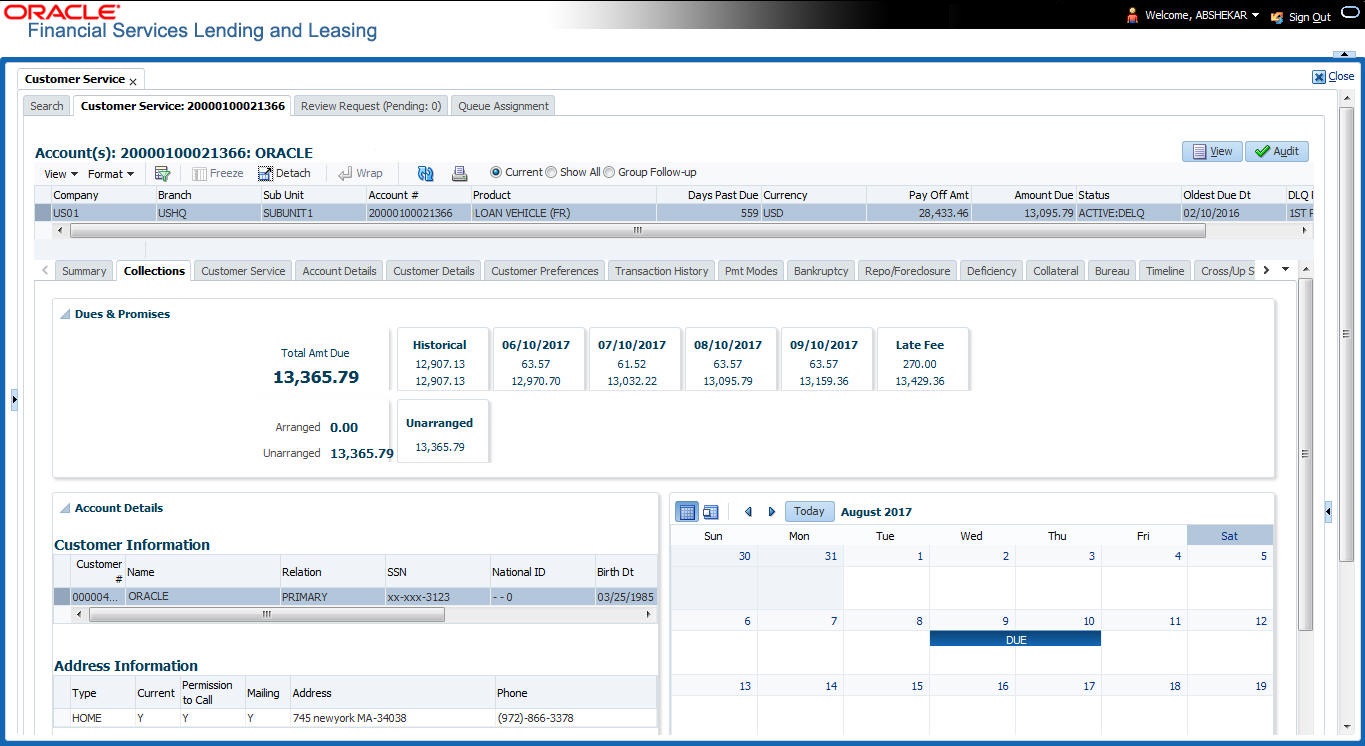
The Collections tab consists of the following sub sections:
Dues & Promises
This section displays the details of unpaid dues and promises on the selected customer account.
- Total Amt Due - Indicates the total amount due on the account.
- Arranged - Indicates the amount agreed as Promise to Pay (PTP).
- Unarranged - Indicates the difference between total amount due and Promise to Pay.
The adjacent section display the following details depending on the account status:
- ‘Historical’ due amount on the account from previous dues.
- Last 4 unpaid dues with the Due Date and Due amount.
- ‘Late Fee’ amount charged on the account.
- ‘NSF Fee’ charged on the account.
- ‘Other Fee’ charged on the account.
- Consolidated amount agreed as PTP (Promise to Pay).
- ‘Unarranged’ indicates the total outstanding due excluding the Promise to Pay amount.
- Each bucket display the consolidated due amount with current and previous dues (if any).
Note
When a due is partially paid and the Payment Received flag = N, system displays only the remaining due amount and not the full due amount.
Account Details
This section displays the summary of account-related information maintained in the system. Since some of the sections are already detailed in the above ‘Customer Service screen’s Summary tab’ the same have been referenced in required instances.
Customer/Business Information
Displays the customer's information starting with primary customer or Business information depending on the type of account selected as either Customer or Business only account. For detailed information, refer to ‘Customer/Business Information section’.
Address Information
Displays corresponding Customer Address or Business Address depending on the type of account selected as either Customer or Business only account. For detailed information, refer to ‘Address Information section’.
Employment Information
Displays the corresponding Employment information of the customer selected in ‘Customer Information’ section. For detailed information, refer to ‘Employment Information section’. The section is not displayed for Business only accounts.
Telecom Information
Displays the corresponding Customer or Business Telecommunication details depending on the type of account selected as either Customer or Business only account. For detailed information, refer to ‘Telecom Information Section’.
Collateral Information
Displays the corresponding collateral details maintained in Customer Service > Collateral tab for the selected customer account. For detailed information, refer to ‘Collateral Information section’.
Reference & Other Contacts
Displays the following details maintained in Customer Service > References tab.
- Relationship
- Name
- Phone1
- Phone2
- Comment
For detailed information, refer to ‘References sub tab’.
Customer Preferences
This section displays the details of customer communication preferences maintained in Customer Service > Customer Preferences tab.
In this field: |
View this: |
Communication Mode |
The mode of communication preferred by customer such as Email or Phone. |
Value |
Communication details such as email ID or phone number. |
Type |
Preferred type of communication in case of ADHOC TELECOM. |
Time Zone |
Customer’s time zone. |
Best day to call |
Preferred day of the week to contact the customer, if specified. |
Best Time To Call |
Preferred time to contact the customer, if specified. |
Calendar
This section displays the dues and payment related activities on account for the current month in Calendar format. By default, the calendar is displayed in Monthly format and can be changed to view by ‘Day’ on clicking  icon. The navigation buttons (
icon. The navigation buttons ( and
and  ) facilitates to move to Previous or Next Month/Day depending on the selection. However, clicking ‘Today’ button reverts the selection to the current Month/Day.
) facilitates to move to Previous or Next Month/Day depending on the selection. However, clicking ‘Today’ button reverts the selection to the current Month/Day.
The following events are highlighted in the Calendar on specific dates:
- The next payment due date as ‘DUE’.
- The next payment day as ‘PAY DAY’ (displayed only for Primary Customer of the account with Current indicator as ‘Y’ and for latest record in Employments tab).
- Paid Date as ‘PAID’.
- Promised to Pay Date as ‘PTP’.
- Current Date.
When multiple events occur on the same day, the same is indicated with the count along with a link to view the events. Also depending on the time zone configured, an event may be extended and highlighted to two days in the calendar when there is an overlap.
Eligibility
This section displays the customer account eligibility to take an ‘Extension’ for payment due date and if ‘Due Date Change’ (DDC) is allowed on the account. If yes, the same is indicated with a  (tick mark).
(tick mark).
Activities
This section displays the dues and payment related activities on account for 36 activities starting from A01 up to A36.
4.5 Customer Service screen’s Customer Service tab
Open the Customer Service screen and load the account you want to work with. Click the Customer Service tab to view the sections under it.
4.5.1 Call Activities sub tab
Call activity section includes calls from customer, calls you make regarding the account or changes to the condition of the account. Entries in the Call Activities section are listed in reverse chronological order of follow-up date.
Each action and result has a code and description. The code for the call action and call result is what appears on the Call Activity sub screen. The Call activity action codes (Action field) and call activity results codes (Results field) are user-defined.
The Call Activities sub tab displays all the call activities defined by users in both “Customer Service > Call Activities tab” and in “Right Hand Splitter > Add Call Activity section”.
4.5.1.1 Recording a Call Activity
To record a call activity
- Open the Customer Service screen and load the account you want to work with.
- Click Customer Service sub tab and then click Call Activities tab under it. Click Add. The system displays the following screen.
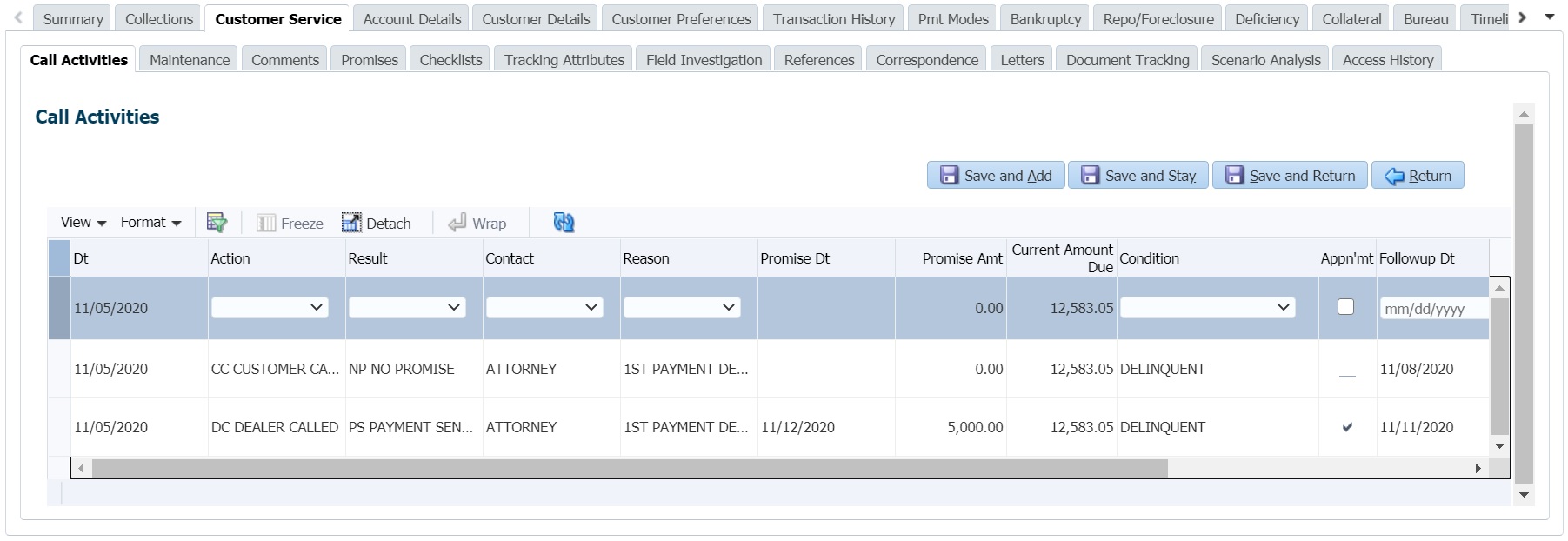
- You can complete the following optional fields:
- Perform any of the Basic Operations mentioned in Navigation chapter.
In this field:
Do this:
Dt
System defaults the current date.
Action Code
The action code is auto-updated based on action selected.
Action
Select the action performed from the drop-down list.
Result Code
The result code is auto-updated based on result selected.
Result
Select the result of the action from the drop-down list. Depending on the action selected, filtered results are displayed for selection.
Contact
Select the person contacted from the drop-down list.
Reason
Select the reason for the communication from the drop-down list.
Cancel
Select the check box to cancel the promise.
Promise Dt
Select the promise date from the adjoining calendar.
Promise Amt
Specify the promise amount.
Current Amount Due
or
Due on Taken Dt
View the amount due on the account as of current date.
On saving the record, the same amount is updated on the call activity and also system posts a comment on the account with the Amount Due as '<Account Currency Code> <Values of Amount Due> Amount Due on <GL Date>'. For example USD 200 AMOUNT DUE ON 11/12/2020.
Note: In add mode, this field name is ‘Current Amount Due’ and table name is ‘Due on Taken Dt’.
Condition
Select the condition or queue type from the drop-down list.
The list displays a combination of all the possible conditions depending on the action and result selected along with any open conditions applicable on the account. You can select ‘None’ if there are no specific conditions.
Appointment
Check this box to take an appointment.
If Appointment is checked, then system allows you to select date and appointment time as per customer request. If appointment flag is not checked, then you can only enter the date with date picker.
Followup Dt
Specify the next follow-up date. Based on this date, system automatically adds the account in queue for follow-up.
Time Zone
Select the time zone of the customer.
Group Followup
Check this box to enable group followup.
Comment
Specify additional information of the call activity, if any.
- Perform any of the Basic Actions mentioned in Navigation chapter.
- Click to Save and Add to add a new record. Click to Save and Return to return to the main screen. The system creates two entries on Customer Service screen for the call activity.
The codes for Action and Result appear as a record on the Customer Service screen, under Call Activities tab. The description for Action and Result appear as a system generated comment on the Customer Service screen, under Comments tab. If the account is delinquent, then the delinquency days is also appended in the system generated comment.
4.5.1.2 Making an Appointment
The Appointment box on Call Activities section enables you to schedule an account to appear in a particular queue at a future date and time. When you make an appointment, account will appear in the front of queue listed in the Conditions field at the time listed in the Follow Up Dt field.
In order to view the account, you must be working in that queue at follow up time. Refer the ‘Recording a Call Activity section’.
To make an appointment
- Open Customer Service screen and load the account you want to work with.
- Click Customer Service sub tab and then click Call Activities tab under it.
- Click Add and specify the field details on Call Activities section (Refer, Recording a call activity section).
- In Condition field, select the condition for queue you want the account to appear in.
- In Follow Up Dt field, select the date and time you want account to appear using the calendar. This can be either current day or a day in future.
- Select the Appn’mt box.
- Click Save And Add / Save And Return.
If account is not worked within the queue on day of the appointment, nightly jobs will cancel the appointment. If the account’s queue condition changes during nightly batch jobs, the outstanding appointments are cancelled.
4.5.1.3 Cancelling an Appointment
Using the Call Activities screen, you can cancel an appointment for an account. The account will still appear in the queue on follow up date, but no longer receive a priority.
To cancel an appointment
- Open Customer Service screen and load the account you want to work with.
- Click Customer Service sub tab and then click Call Activities tab under it.
Click Add. The system displays Call Activities screen. If you need to change time for the appointment, create a new entry on account’s Call Activities section with the same condition, but enter a new follow up date. If you need to cancel the appointment, create a new entry on account’s Call Activities section with same condition, but don’t check the Appointment check box.
(To create a new entry, refer Recording a Call Activity section.)
- Click Save.
4.5.1.4 Recording a Promise to Pay
If you record an action on Call Activities screen as a ‘promise to pay’, it appears as a record on the Account Details screen’s Promises section. The Promises section enables you to quickly view these actions without searching for them individually.
To record a promise to pay
- Open Customer Service screen and load the account you want to work with.
- Click Customer Service sub tab and then click Call Activities tab under it.
- Click Add. The system displays the Call Activities screen. In Action field, select the action which is already performed, such as DC - Dealer Called
- In the Result field, select a result involving a promise to pay, such as PP - PROMISE TO PAY.
- You can complete the following optional fields:
In this field:
Do this:
Contact
Select the contact type. (Who was the person you communicated with?).
Reason
Select the reason, as stated by the contacted person. (What is the reason for this contact?).
- In the Promise Dt field, record date when the person you spoke with promises to make payment.
- In the Promise Amt field, record amount of payment the person you spoke with promises to pay.
- In the Condition field, select the condition or queue type.
- In the Follow up Dt field, enter next follow-up date for the promise-to-pay or accept the default date.
- Click Save. The system automatically notes this information as an entry on the Promises and Comments sub screens.
Note
If payment amount is within the tolerance limit, promise is considered to be kept. If the payment amount is not within tolerance limit, promise is considered to be broken.
4.5.1.5 Cancelling a Promise to Pay
Oracle Financial Services Lending and Leasing enables you to cancel promises to pay using the Account Detail’s screen Call Activities section. You might do this when a customer informs you prior to the promise date that he or she cannot make the payment.
To cancel the existing promise to pay
- Open the Customer Service screen and load the account you want to work with.
- Click Customer Service sub tab and then click Call Activities tab under it.
- Click Add. The system displays the Call Activities screen.
- Select the call activity entry for the promise to pay you want to cancel.
Click the Cancel box. The promise is marked as cancelled and will not be considered when processing promises; in other words, it will not be counted as either satisfied or broken.
4.5.1.6 Posting Offline Call Activities
The system facilitates posting of offline call activities against an account.
To Post Offline Call Activities:
- The source file is provided in CSV format (pre-determined for fields & size). Each field in the file is separated by a comma (,) and each line is separated by return (New Line).
- A batch job Offline call activity posting, loads the provided flat file in the specified format and system will process it line by line.
- For each line, the system posts Call Action Code and the corresponding Call Result Code, for a given account number with SYSDATE.
- The system will perform respective call activities and sets the follow-up date as SYSDATE + Follow up Days (As provided in the feed file)
- During offline call activity, you can specify comments, if any, in the comments field. The system defaults comments received from offline call activity in the comments section sub tab under Customer Service screen.
- During offline call activity, you can also include the alert flag as ‘Y’ or ‘N’ for a comment as the last parameter (i.e. after comments and separated by a comma). Oracle Financial Services Lending and Leasing recognizes this comment as an alert and displays in Customer Service > Summary Tab, in Alerts section.
4.5.2 Maintenance sub tab
The Customer Service screen’s Maintenance screen acts as a single command stations that enables you to post a wide array of monetary and non monetary transactions for any given account. Transaction available is based on the account’s Loan produce and the user’s responsibility. This section explains how to complete the following tasks:
Monetary tasks
Loan:
- Apply, adjust, or waive servicing expenses
- Adjust or waive late charges
- Adjust or waive non-sufficient funds
- Apply, adjust, or waive repossession expenses
- Apply, adjust, or waive bankruptcy expenses
- Apply or adjust phone pay fees
- Change an index/margin rate
- Apply, adjust, or cancel financed insurance
- Generate a payoff quote
- Generate a backdated payoff quote
- Payoff an account
- Charge-off an account/Do Not Charge-Off an account
- Close an account
- Trading of Accounts - Monetary Transactions
- Account Settlement Transaction
- Adjust, charge-off, or waive the advance/principal balance
- Adjust the interest balance
- Stop interest accrual
- Indicate a borrower as on or off active military duty
- Change a due date
- Apply, adjust, or waive an extension fee
- Change payment amount
- Adjust or waive a prepayment penalty
- Reschedule an escrow payment
- Adjust or waive an escrow payment
- Adjust or waive a payoff quote fee
- Place an account in a nonperforming condition
- Reverse a nonperforming condition
- Reschedule precompute loan to interest bearing loan
Non-Monetary tasks
Loan:
- Update a customer’s/Business name
- Maintain customer details
- Mark a customer/business as a skipped debtor
- Change a customer’s Privacy Opt-Out indicator
- Stop correspondence
- Modify financed insurance information
- Start or stop an ACH
- Reprint a statement (batch only)
- Add or stop servicing of accounts with post dated checks as a repayment method
- Re-order coupon books
- Cancel or adjust an ESC
- Apply a refund payment to an ESC
- Cancel insurance (or reverse the insurance cancellation)
- Add new escrow insurance details
- Add new escrow tax details
- Change insurance annual disbursement
- Change insurance disbursement plan
- Change escrow indicators of insurance
- Change insurance expiration date
- Change insurance maturity date
- Change tax annual disbursement
- Change tax disbursement plan
- Change escrow indicators of tax
- Resume escrow analysis
- Resume escrow disbursements
- Stop escrow analysis
- Stop escrow disbursements
- Refund or adjust insurance
- Adjust Dealer Compensation
- Trading of Accounts - Non-Monetary Transactions
- Bankruptcy Reporting Indicator
- Sub Unit Account Transfer
The system enables you to post a monetary transaction immediately or submit it for nightly processing. The transaction is identified as either a ‘real-time’ or nightly batch transaction in Oracle Financial Services Lending and Leasing’s transaction setup codes. The system also enables you to cancel the future dated transactions or transactions those have been submitted for nightly processing. All activities in the account, including who performed it, date and time stamp, are captured in the audit trail.
4.5.2.1 Creating Monetary and Non monetary Transactions
All monetary and non monetary tasks listed in the appendix Transaction Parameters are available for use on Maintenance screen. Each task requires a Transaction value and a Parameter value.
To use the Maintenance screen to complete monetary transaction
- Open Customer Service screen and load the account you want to work with.
- Click Customer Service sub tab and then click Maintenance tab under it.
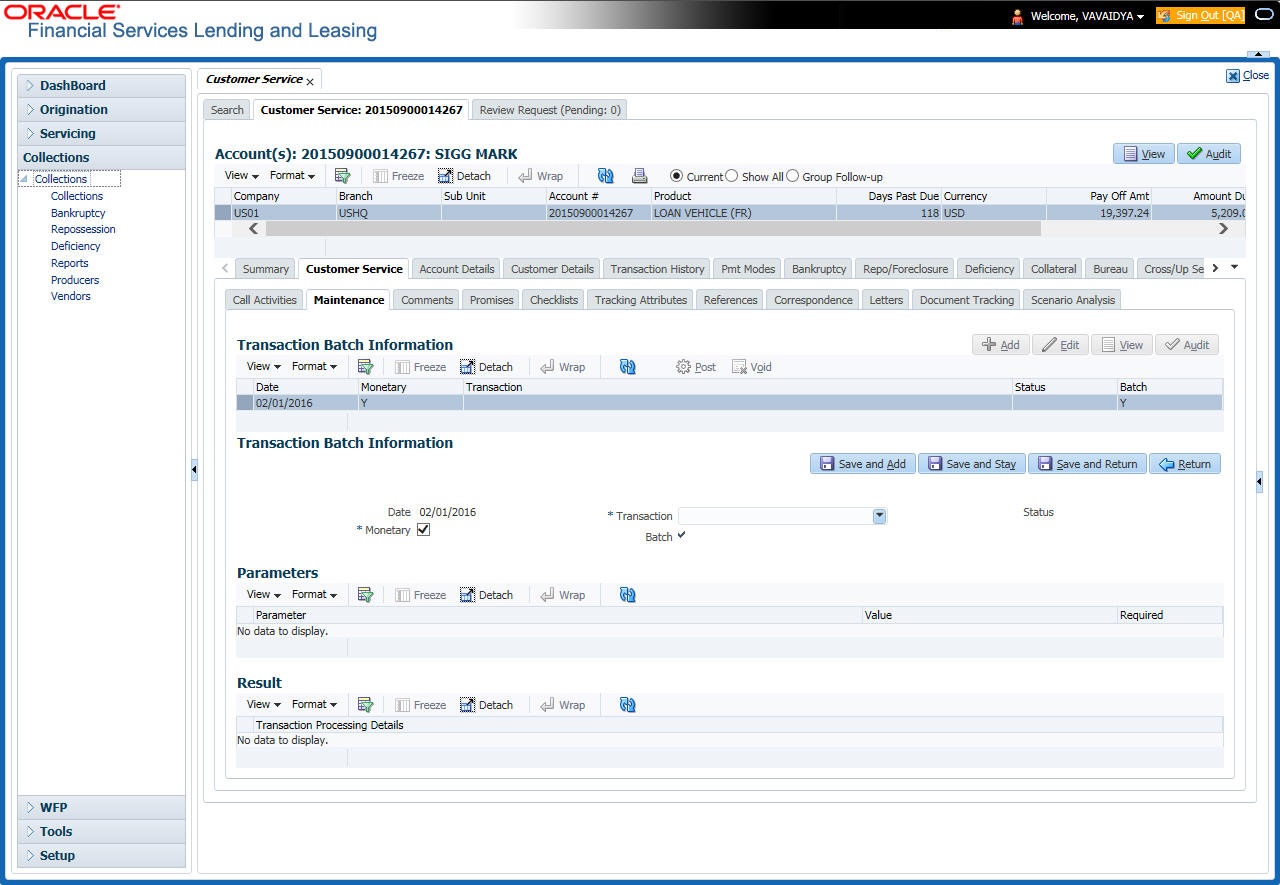
- On the Maintenance screen’s Action section, click AddIn the Transaction Batch Information Section section:
- Select the Monetary box to complete a monetary transaction.
-or-
- Clear the Monetary box to complete a non monetary transaction.
- In the Transaction field, select transaction for the task you want to complete. Transaction availability depends on the type of Loan account, whether the transaction is monetary or non monetary, and user responsibility.
Note that, during set up, all transactions are configured to be processed either in real time or as a batch transaction. Accordingly, the ‘Batch’ check box is selected only if the selected transaction is to be performed through batch execution.
- Click Load Parameters.
- Specify all the required parameter values and click Post.
The system displays result (success or failure) in the Results section.
You can cancel a transaction by selecting the record and clicking Void. The parameter ‘TPE_TXN_POST_DEFAULT_GLDATE’ is used to default the transaction date to GL date. If the ‘Default Transaction Date to GL Date’ is Yes, then GL date will be defaulted as transaction date. If the value is ‘No’, then the transaction date will not be defaulted and you can specify the transaction date manually.
When transaction date is not equal to or less than the system date, transaction is considered to be back dated. System Date is ‘OFSLL System Date’ which is the GL Date. When user posts the back dated transaction, system displays warning message as “Confirm to post the back dated transaction” with YES/NO. If user selects 'Yes', then transaction proceeds. If user selects 'No', then the transaction gets cancelled.
System displays back dated posting warning message only if the parameter ‘TPE_SHOW_BACKDATE_WARNING’ is set to ‘Y’
When an ‘ON MILITARY DUTY TRANSACTION’ is posted in an account:
- The system restricts users from bankruptcy /repossession/foreclosure conditions.
- System posts DO NOT CHARGE OFF condition on that account to exclude the account from Auto Charge Off process.
- The DO NOT CHARGE OFF condition is removed when 'OFF Military Duty' transaction is posted.
4.5.3 Comments sub tab
Oracle Financial Services Lending and Leasing enables you to record/delete comments on the Customer Service screen using Comments tab. These comments also appear under the Comments sub tab.
All the user added Comments in either Customer Service > Comments tab or in Right Hand Splitter > Add Comment section, are displayed in the Comments sub tab including system generated comments.
4.5.3.1 Recording an Additional Comment
To record an additional comment
- Open the Customer Service screen and load the account you want to work with.
- Click Customer Service sub tab and then click Comments tab under it.
- Click Add. The system displays the Comments screen.

- If you want to tag this comment as important, select the Alert box. If selected, the comment appears on Customer Service screen’s Alerts section, after Save.
- In the Type field, select what type of comment you are adding.
- In the Sub Type field, select what sub type of comment you are adding.
- In the Comment field, specify your comment.
- Click Save and Add to add a new record. Click Save and Return to return to the main screen.
Comments can be viewed under the Comments tab View the following:
In this field: |
View this: |
Alert |
If selected, Oracle Financial Services Lending and Leasing to recognizes this comment as an alert and displays in Customer Service > Summary Tab, in Alerts section. |
Type |
The type of comment. |
SubType |
The sub type of comment. |
Comment |
The text message entered in the Add Comments section. |
Comment By |
The user ID of person who entered comment in the Add Comments section. |
Comment Dt |
The date on which comment was entered in the Add Comments section. |
4.5.3.2 Deleting Comment(s)
You can delete ‘REGULAR’ type comments displayed in the Comments sub tab.
To delete a comment
- Open the Customer Service screen and load the account you want to work with.
- Click Customer Service sub tab and then click Comments tab under it.
- Select the row which consists of the comment and click Delete from the actions.
- Click ‘Yes’ to confirm delete in the warning message displayed.
4.5.4 Promises sub tab
The system automatically updates promise to pay request information as an entry under the Promises sub tab based on value defined in parameter at setup level.
In this field: |
View this: |
Promise Amt |
The amount promised. |
Promise Dt |
The date by which customer promises to pay the said amount. |
Taken By |
The user who took promise. |
Taken Dt |
The date promise was taken. |
Due on Taken Dt |
View the amount due on the account as of current date. Note: In add mode, this field name is ‘Current Amount Due’. |
Collected Amt |
The amount collected against the promise. |
Broken ind |
If ‘Y’, indicates that this is a broken promise. Note: This field is auto-updated by the system at runtime after executing the scheduled batch job CPPPRC_BJ_100_01 (BROKEN PROMISE PROCESSING) with the method of update defined in Company parameter FUTURE PROMISE HANDLING METHOD (CMN_PROMISE_FUTURE_MTHD). Refer ‘Company Parameters’ section for more information. |
Cancelled |
If ‘Y’, indicates that this is a cancelled promise |
If a call was recorded as a Promise to Pay on the Call Activities section, it will appear under the Promises sub tab. The Promises sub tab enables you to quickly view details about the call and subsequent actions and displays 25 most recent promises to pay.
A promise is considered to be broken in either of the following conditions:
- If system does not receive the promised amount ‘ON or Before’ the promised date.
- If a payment is received but the paid amount is not up to the tolerance limit, as defined in Setup > Contract screen.
System automatically updates the consolidated status of all promises in Customer Service > Summary tab, ‘Delinquency Information’ section. View the following information in the Promises sub tab.
Create Multiple Promises
In the Promises sub tab, you can capture more than one Promise at a go and track all promises, instead of adding multiple call activities to capture multiple promises.
To record multiple promises related to call activity, Click Create Multiple Promises. The system displays the ‘Promises’ section with the following fields:
In this field: |
View this: |
Action |
Select the type of action from the drop-down list. |
Result |
Select the required result of action from the drop-down list. The Result field drop-down list displays only “Promise to Pay” related results based on the action selected. |
Contact |
Select the type of person you contacted from the drop-down list. |
Reason |
Based on the account condition and the reason stated by the contact, select the appropriate reason from the drop-down list. |
Promise St Dt |
Select the date from which the first promise is made from the adjoining calendar icon. |
Frequency |
Select the frequency of payment from the drop-down list. |
Promise Amt |
System defaults the current due amount on the account as on current date. Specify the amount promised by the contact. Ensure that you do not enter zero or a decimal value. |
No. of Promises |
Specify the total number of promises made by the contact. A minimum of one promise need to exist. |
Appointment |
Select the check box if a prior appointment is to be taken for future follow-up. |
Current Amount Due |
View the amount due on the account as of current date. |
Comment |
Specify additional details of the promise, if any. |
Click Create to record the promise details. Based on the number of promises, equivalent records are created in the section below with the following information:
In this field: |
View this: |
Promise Dt |
The first record indicates the promise start date and subsequent records will have dates incremented based on frequency and number of promises. |
Promise Amt |
View the amount promised. |
Reason |
Indicates the reason stated by the contact. |
Contact |
Indicates the contact selected. |
FollowUp Dt |
Indicates the followup date which is auto calculated by the system by adding 2-3 additional days from the promise date. |
Appointment |
Indicates if a prior appointment is required for future follow-up. |
Comment |
Specify additional details of the promise, if any. |
If required, You can further modify the details of each record.
Click Save and Return. The recorded promises are populated in Call Activities tab for tracking.
For more information on Call Activities, refer Customer Service > Call Activities sub tab section.
4.5.5 Checklists sub tab
In this field: |
View this: |
Promise Amt |
The amount promised. |
Promise Dt |
The date by which customer promises to pay the said amount. |
Taken By |
The user who took promise. |
Taken Dt |
The date promise was taken. |
Collected Amt |
The amount collected against the promise. |
Broken |
If selected, indicates that this is a broken promise. |
Cancelled |
If selected, indicates that this is a cancelled promise |
Oracle Financial Services Lending and Leasing enables you to use checklist to ensure that procedures are followed to complete various tasks. This instructional information appears under the Checklist sub tab.
4.5.5.1 Completing a Checklist for an Account
To complete a checklist for an account
- Open the Customer Service screen and load the account you want to work with.
- Click Customer Service tab, Click Checklist sub tab.

- In the Check List Type field, select the type of checklist you want to complete and then click Load Checklist. The system loads checklist in the Checklist and Checklist Action sections.
- Under Action - Regular tab, Click Edit. In the Action field, select an action you want to complete.
- Under Action - Document tab, Click Edit. In Document tab, you can track documents pertaining to the checklist type and update the status.
- Note your work with the Yes/No/NA option buttons. You can also add comments to each action on the checklist in the Comment column.
- Click Save and Add to add a new record. Click Save and Return to return to the main screen.
4.5.6 Tracking Attributes sub tab
The Tracking Attributes screen enables you to link information to an account that is not tracked by default in the system, but is part of your company’s business practices; for example, the location of important documents, how customers receive pay checks, or the hint questions for remembering a PIN. Such attributes are defined during system setup.
The Tracking Attributes for Loan accounts in this screen can also be loaded in bulk through file upload process. While doing so, ensure that the input data file definitions are in sync with attribute names. Before processing the bulk upload, system validates if the Tracking Attributes are already loaded. If not, system loads the Tracking Attributes and then updates the details.
To use the Customer Service screen’s Tracking Attributes screen
- Open the Customer Service screen and load the account you want to work with.
- Click the Customer Service tab, then click Tracking Attributes sub tab.
- Click Load Tracking. The system loads the tracking parameters.

- Complete Tracking section by entering the requested parameter in the Value field.
- Save any changes you made to the account.
4.5.7 Field Investigation Sub Tab
The Field Investigation sub tab allows you to record the field investigation details for further processing. Field investigation primarily consists of verifying cusotmer’s contact points and the other details to be verified such as address, employment, asset etc through a specific verifying agency.
To record field investigation and create work-order
- Open the Customer Service screen and load the account you want to work with.
- Click the Customer Service tab, then click Field Investigation sub tab.

- In Field Investigation section, perform any of the Basic Operations mentioned in Navigation chapter.
A brief description of the fields are given below:
Field |
Do this |
Customer/Business |
Select the customer attached to the account or Business Name if it is an ‘SBL’ or Business account from the adjoining drop-down list. |
Verification Type |
Select the field verification type from the adjoining drop-down list. |
Verification Agency |
Select the verification agency from the adjoining drop-down list. |
Status |
Select the field verification status from the adjoining drop-down list. |
Spoke to |
Specify the name of the person contacted during field verification. |
Call Dt |
Select the date when the customer was contacted from the adjoining calendar. |
# of Attempts |
Specify the number of attempts made to contact the customer. |
Result |
Select the field verification result from the adjoining drop-down list |
- Perform any of the Basic Actions mentioned in Navigation chapter.
- In Verification Details section, perform any of the Basic Operations mentioned in Navigation chapter.
A brief description of the fields are given below:
Field |
Do this |
Remarks |
Specify remarks, if any regarding the field verification. |
Verification Match |
Check the box if the verification has matched. |
- Perform any of the Basic Actions mentioned in Navigation chapter.
4.5.8 References sub tab
The References sub tab enables you to view/add/edit references attached to the account during Loan origination cycle.
To use the Customer Service screen’s References screen
- Open the Customer Service screen and load the account you want to work with.
- Click the Customer Service tab, then click References sub tab.
- Click Add.

Specify the following details:
In this field: |
Specify this: |
Relationship |
Referee's relationship with borrower. |
Name |
Referee's name and details in the following fields. |
Status |
Select the status of the reference as either ‘Active’ or ‘Inactive’ from the drop-down list. |
Country |
The country. |
Address |
The address line. |
Zip |
The zip code. |
Zip Extn |
The zip code extension |
City |
The city. |
State |
The state. |
Years |
Number of years that the reference is known by the borrower. |
Months |
The number of months that the reference is known by the borrower. |
Phone |
The reference’s primary phone number. |
Extn |
The reference’s primary phone extension. |
Permission to call |
Check this box if customer has provided permission to contact through the specified phone number. |
Permission to Text |
Check this box if customer has provided permission to contact through text message. |
Phone |
The reference’s secondary phone number. |
Extn |
The reference’s secondary phone extension. |
Permission to call |
Check this box if customer has provided permission to contact through the specified phone number. |
Permission to Text |
Check this box if customer has provided permission to contact through text message. |
Comment |
The comments regarding the reference. |
- Click Save and Add to add a new record. Click Save and Return to return to the main screen.
Note
You can also post a non-monetary transaction to add or modify contact reference details. For more details, refer to Appendix - ‘Transaction Parameters’ chapter. For references updated through the Customer Service screen, system automatically appends a comment as 'Direct Update' while posting the respective transactions.
4.5.9 Correspondence sub tab
Ad-hoc correspondence enables you to include information from accounts in document templates you create yourself without manually transferring the data. Ad-hoc documents can be generated as either Microsoft Word or PDF files.
Ad-hoc correspondence can be viewed on the Correspondence screen when you have opened an account. The screen enables you to generate a new letter or view a previously generated letter.
To generate an ad hoc correspondence
- Open the Customer Service screen and load the account you want to work with.
- Click the Customer Service tab, then click Correspondence sub tab.
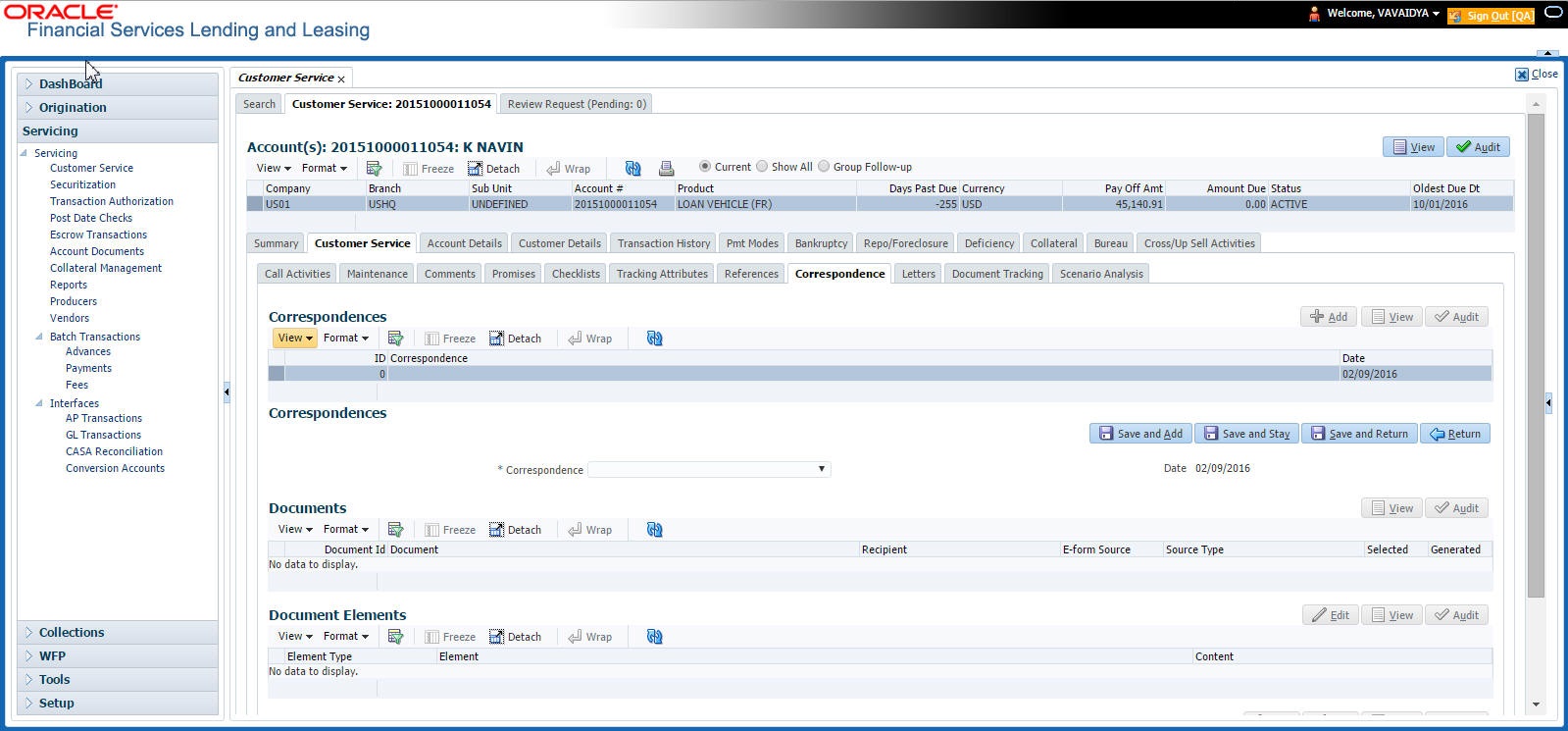
- In the Correspondence section, click Add. In the Correspondence section, use Correspondence field to select type of correspondence you want to generate. The system displays following information in the Correspondence screen for selected type of correspondence:
In this field:
View this:
Id
The correspondence id.
Correspondence
The correspondence which is to be generated.
Date
The correspondence generation date.
- In the Correspondence section, click Save. The Documents section displays all types of documents available for the type of correspondence you selected.
- In the Documents section, click View.View the following information for each document:
In this field:
View this:
Document Id
The document Id.
Document
The document description.
Recipient
The recipient description.
E-Form Source
The e-form source.
Source Type
The source type.
Generated
’Y’ indicates that Oracle Financial Services Lending and Leasing generated the document.
Selected
’Y’ indicates that this document is selected to be included in the correspondence.
- In the Documents section, select the correspondence you want to view.
- The Document Elements section displays elements of the system used to generate correspondence.
- Click All to view all elements in the correspondence.
- or -
- Click User Defined, to view user-defined elements in the correspondence. In the Document Elements section, view the following information:
In this field:
Do this:
Element Type
View the document element type.
Element
View the element description.
Content
Enter/view value of the element.
- In the Document Elements section, click User Defined and complete Content fields for Element fields you want to include in the correspondence.
- In the Document Elements section, click Save.
- In the Document Elements section, click View.
The system displays a PDF of the ad hoc correspondence.
4.5.9.1 Recipient Details Sub Tab
The recipient details sub tab facilitates you to send ad-hoc correspondence to Customers, Producers, and Others as an email.
To add recipient details
- Open the Customer Service screen and load the account you want to work with.
- Click Correspondence > Recipient Details.
- Perform any of the Basic Operations mentioned in Navigation chapter.
A brief description of the fields is given below:
Field: |
Do this: |
Recipient |
Select the recipient from the drop-down list. The list displays the following options: - Applicant - Customer - Producer - Others - Business |
Customer Type |
This field is enabled if you has selected the recipient as ‘Customer’. Select the type of customer relation from the drop-down list. The list is populated with all the customer relations linked to the account. |
Mode |
Select the mode of correspondence from the drop-down list. The list displays the following options: - Fax |
Type |
Based on the recipient selected, the following type of correspondence is listed for selection: When the recipient is selected as Customer / Producer, the Type is defaulted as ‘Email’ and associated email ID is selected for correspondence. You can also change the Type to ‘Adhoc’ and specify the required email ID. When the recipient is selected as ‘Others’ you can specify the email ID in Type field for correspondence. |
FAX/Email |
View the auto populated FAX/Email details or select from the drop-down list. Email and Fax details are auto populated if the recipient is selected as Customer / Producer / Business and the ‘Mode’ and ‘Type’ is selected as EMAIL. |
Comments |
Specify additional information as comments. |
- In the Recipient Details section, click Save.
- Click Send to email the correspondence details to the specified recipients.
System validates the correspondence details and generates a PDF document through BI Publisher with the Correspondence details. The same is emailed to the specified recipient as an attachment and a system generated comment is updated in ‘Comments’ Tab. The correspondence consists of following header details::
Alert |
Type & Subtype |
Comment |
Comment By |
Comment Date |
N |
System Generated |
<Type> <Correspondence type> sent to <Recipient Type> through < Mode> to <'Email' id> |
Logged in user |
Current System date with time stamp |
4.5.10 Letters sub tab
The Oracle Financial Services Lending and Leasing Customer Service screen’s correspondence address matters regarding customer service and collections for accounts. They also enable financial organizations to manage bulk mailings. The Letters screen enables you to create and view the following types of correspondence:
- Welcome letter
- Paid in Full letter
- PayOff quote letter
- Rate change intimation letter
- PDC renewal letter
- Collection:
- Collection Letter - 1
- Collection Letter - 2
- Collection Letter - 3
You can view format of all the above letter types by clicking ‘View Letter’ button. In case, the correspondence to a particular customer has been stopped using the Maintenance, ‘View Letter’ button will not be displayed and only Letters screen will be available.
To use the Letters screen
- Open the Customer Service screen and load the account you want to work with.
- Click the Customer Service tab, then click Letters sub tab.
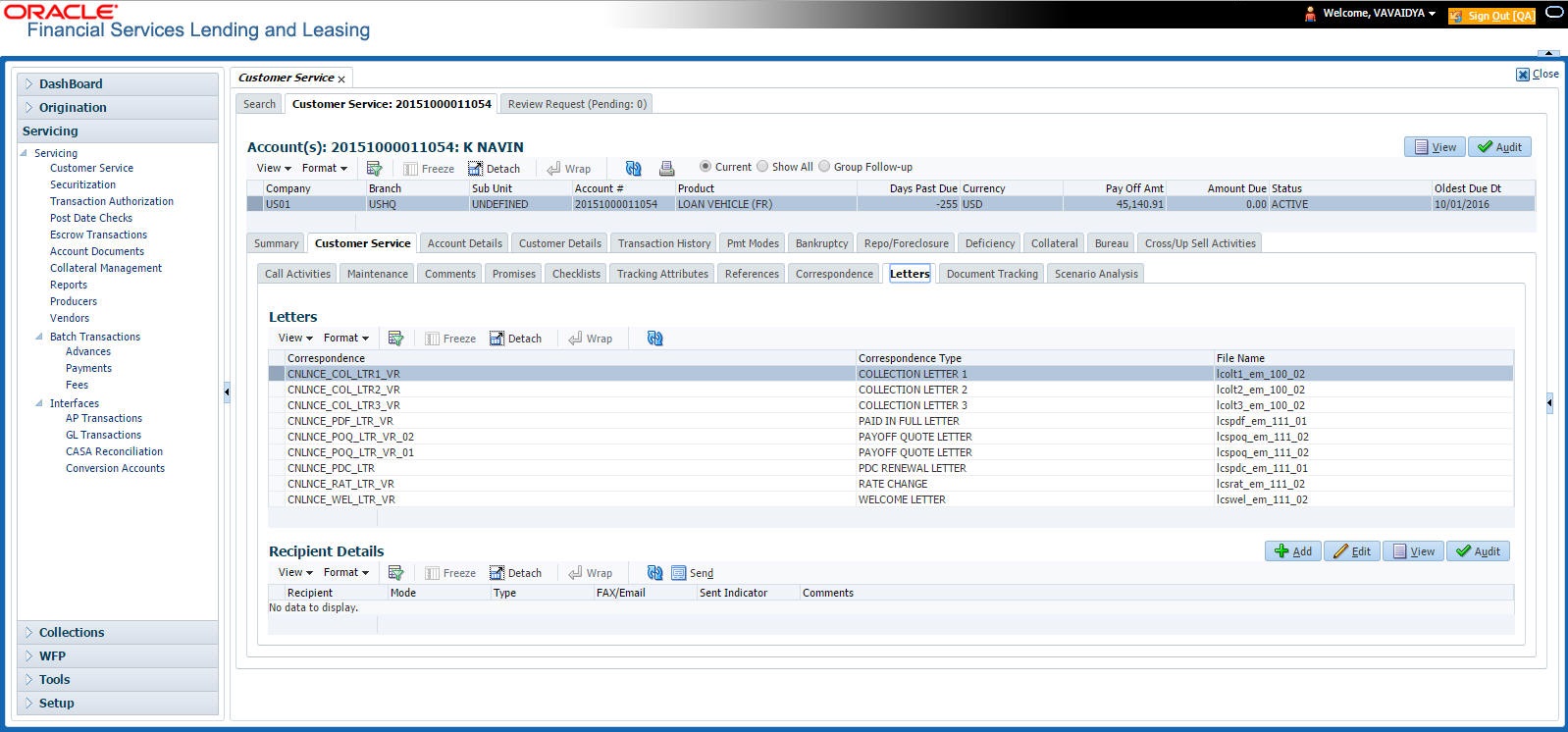
Recipient Details
In the Recipient Details section, you can maintain the recipient details to whom the letter should be sent. You can specify the following recipient details:
Field: |
Do this: |
Recipient |
Select the recipient from the drop-down list. The list displays the following options: - Applicant - Customer - Producer - Others - Business |
Customer Type |
This field is enabled if you has selected the recipient as ‘Customer’. Select the type of customer relation from the drop-down list. The list is populated with all the customer relations linked to the account. |
Mode |
Select the mode of correspondence from the drop-down list. The list displays the following options: - Fax |
Type |
Based on the recipient selected, the following type of correspondence is listed for selection: When the recipient is selected as Customer / Producer, the Type is defaulted as ‘Email’ and associated email ID is selected for correspondence. You can also change the Type to ‘Adhoc’ and specify the required email ID. When the recipient is selected as ‘Others’ you can specify the email ID in Type field for correspondence. |
FAX/Email |
View the auto populated FAX/Email details or select from the drop-down list. Email and Fax details are auto populated if the recipient is selected as Customer / Producer / Business and the ‘Mode’ and ‘Type’ is selected as EMAIL. |
Comments |
Specify additional information as comments. |
- In the Recipient Details section, click Save.
- Click Send to email the correspondence details to the specified recipients.
System validates the correspondence details and generates a PDF document through BI Publisher with the Correspondence details. The same is emailed to the specified recipient as an attachment and a system generated comment is updated in ‘Comments’ Tab. The correspondence consists of following header details:
Alert |
Type & Subtype |
Comment |
Comment By |
Comment Date |
N |
System Generated |
<Type> <Correspondence type> sent to <Recipient Type> through < Mode> to <'Email' id> |
Logged in user |
Current System date with time stamp |
4.5.10.1 Servicing: Welcome letter
The predefined loan Welcome letter is automatically sent a configurable number of days after an account is activated after the loan origination process.
The Welcome letter is available for loans (fixed and variable rate).
To generate the Welcome letter
- Open the Customer Service screen and load the account you want to work with.
- Click the Customer Service tab, then click Letters sub tab.
- On the Letters section, select Welcome Letter.
- Click View Letter to generate Welcome Letter - 3.
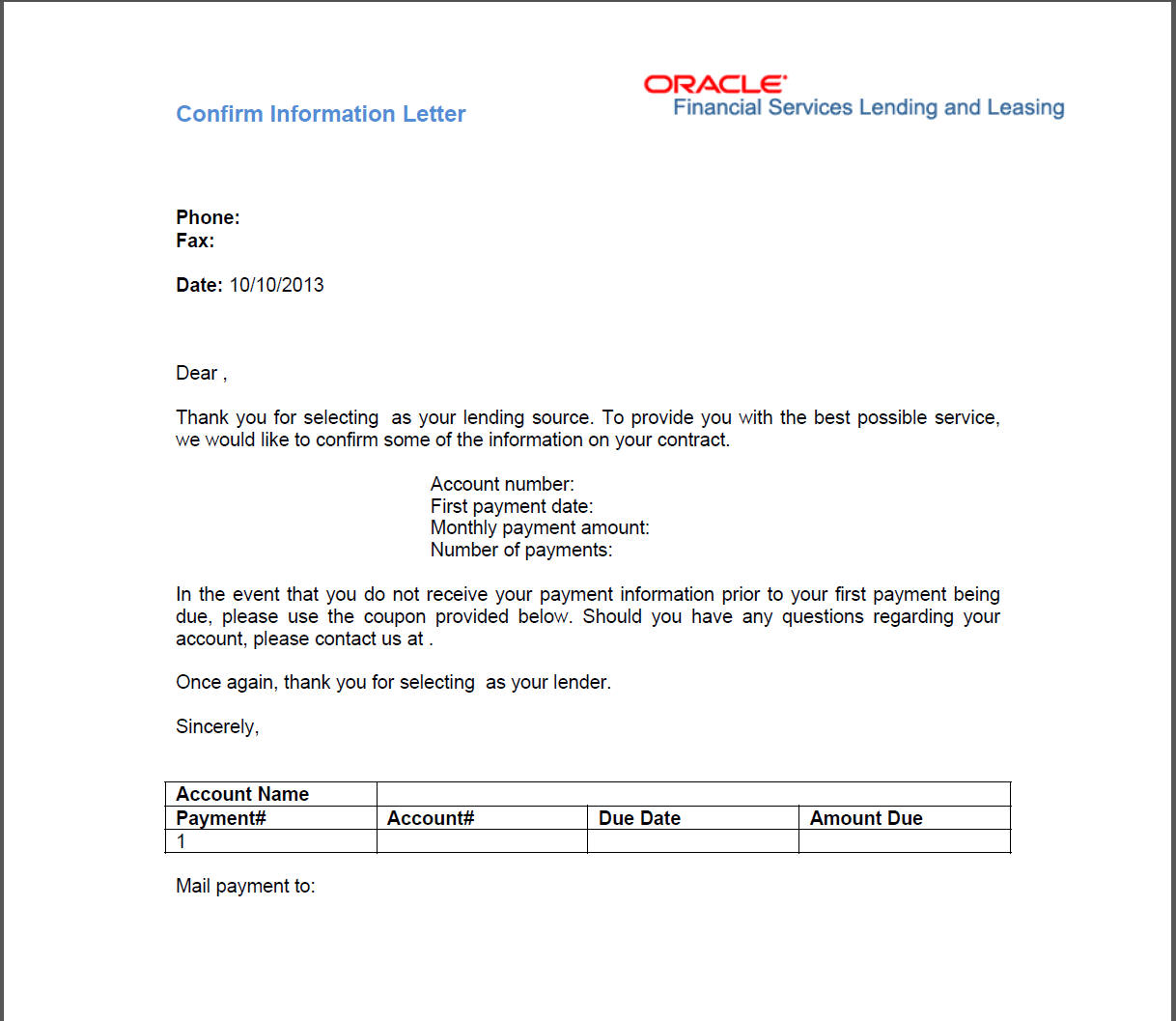
4.5.10.2 Servicing: Paid in Full letter
The predefined Paid in Full letter is automatically sent a configurable number of days after an account is fully paid off on the Customer Service screen.
The Paid in Full letter is available for loans.
To generate the Paid in Full letter
- Open the Customer Service screen and load the account you want to work with.
- Click the Customer Service tab, then click Letters sub tab.
- On the Letters section, select Paid in Full Letter.
- Click View Letter to generate Paid in Full Letter.
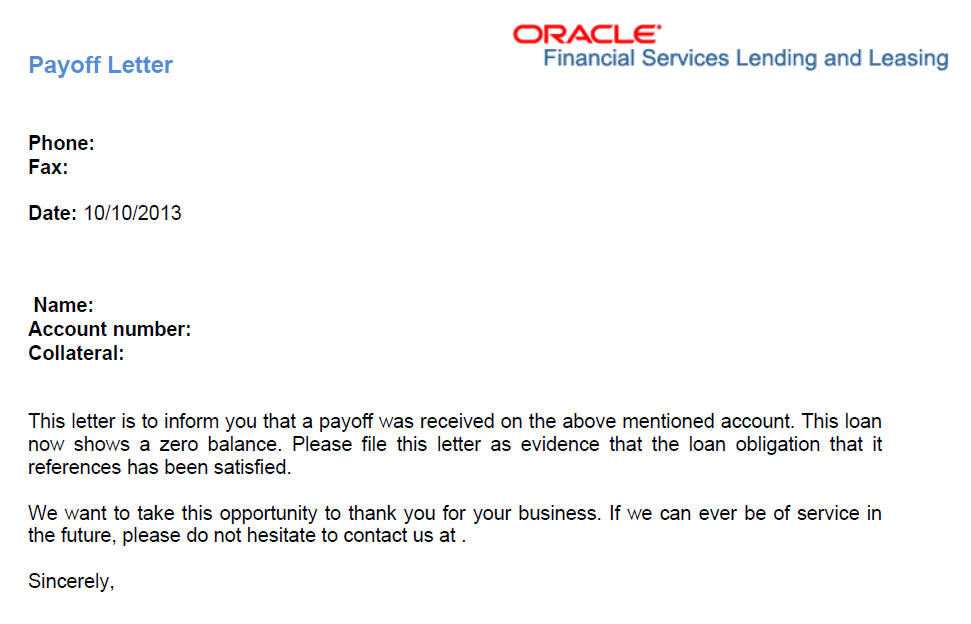
4.5.10.3 Servicing: Payoff Quote
The predefined Payoff Quote is sent if a payoff quote is requested for an account. Payoff quotes can be manually generated using Maintenance screen on the Customer Service screen with the monetary Payoff Quote transaction.
To generate a payoff quote letter
- Open the Customer Service screen and load the account you want to work with.
- Click the Customer Service tab, then click Letters sub tab.
- On the Letters section, select Payoff Quote Letter.
- Click View Letter to generate Payoff Quote Letter.
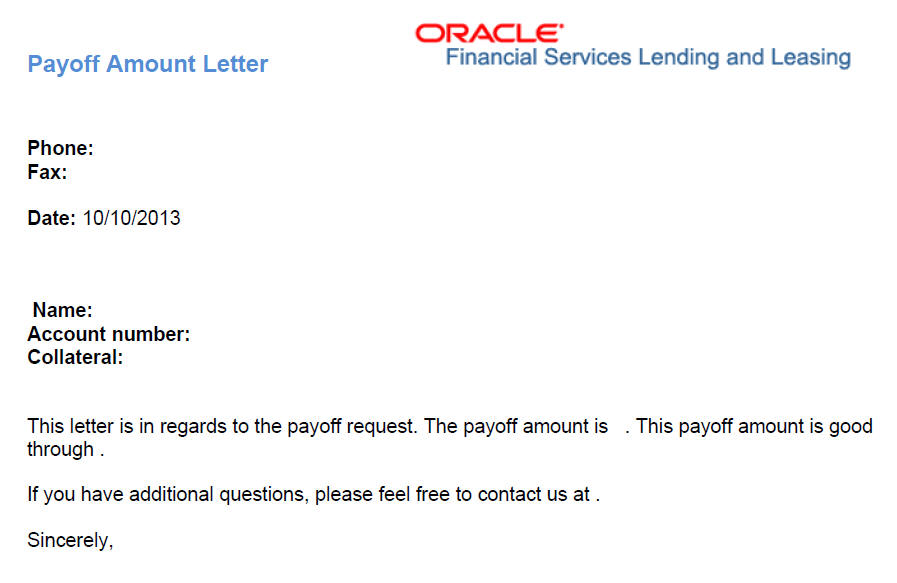
4.5.10.4 Collections: Collection letter 1
The predefined Collection letter 1 is automatically sent a configurable number of days after an account becomes delinquent (receives a condition of active: DELQ on the Customer Service screen).
The Collection letter 1 is available for Loan fixed and variable rate).
To generate the Collection letter 1
- Open the Customer Service screen and load the account you want to work with.
- Click the Customer Service tab, then click Letters sub tab.
- On the Letters section, select Collection Letter - 1.
- Click View Letter to generate Collection Letter - 1.

4.5.10.5 Collections: Collection letter 2
The predefined Collection letter 2 is automatically sent after a configurable number of days for a delinquent account (one with a condition of active: DELQ on the Customer Service screen).
The Collection letter 2 is available for Loan (fixed and variable rate).
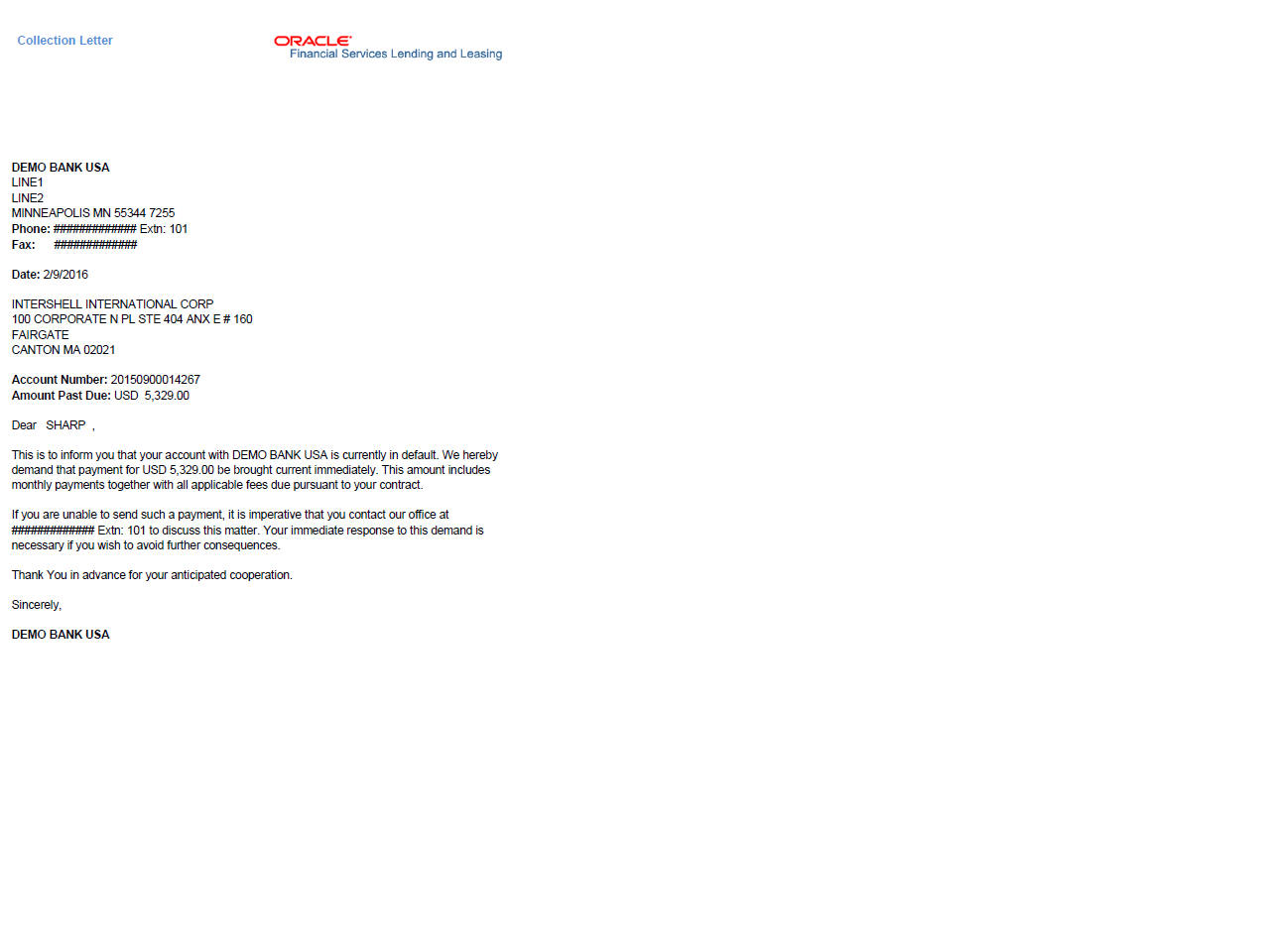
4.5.10.6 Collections: Collection Letter 3
To generate the Collections letter 3
- Open the Customer Service screen and load the account you want to work with.
- Click the Customer Service tab, then click Letters sub tab.
- On the Letters section, select Collection Letter - 3.
- Click View Letter to generate Collection Letter - 3.

4.5.11 Document Tracking sub tab
You can view the documents attached to a particular account by loading the account on Customer Service screen, then clicking the Document Tracking sub tab. You can also open the Document Tracking screen and select from a list of all accounts with documents attached on the Document Tracking screen.
To use the Document Tracking screen
- Open the Customer Service screen and load the account you want to work with.
- Click the Customer Service tab, then click Document Tracking sub tab.

- In the Documents section, select the document you want to view and view the following information:
In this field:
Do this:
Document Type
View the document type.
Comment
Specify comment.
- In the Account Document Details section, select the document you want to view and click Show in the Details column.
- In the Account Document Details section, click View to view the following information:
In this field:
Do this:
Document Type
View the document type.
Document Sub Type
View the document sub type.
Version
View the version. Version numbers will be incremental by batch job, first version will start with 1.0.
Page #
View the page number. In multiple paged documents, choose 1 in the Page # field on Account Document Details section to view all the pages in the document.
Choose a specific page number to view only that page.
Document File Type
View the document file type.
Status
View the status of the document.
Tracker #
View the tracking number of the document.
Docket #
View the docket number of the document.
Location
View the location of the document.
Received Dt
View the received date of the document.
Effective Dt
View the effective date of the document.
Expiry Dt
View the expiration date of the document.
Comment
Specify comment.
- Click View Document. The system opens a File Download dialog box.
- Click Open to view the document in the browser screen
-or-
- Click Save to download the document to a location of your choice.
- If you want, add comments to the Comments field in the Documents and Account Document Details sections.
- Save your entry.
4.5.12 Scenario Analysis sub tab
Oracle Financial Services Lending and Leasing enables you to reschedule customer payments with the Customer Service screen’s Scenario Analysis screen. You can simulate new payment schedule based on the customer’s request and also post the new schedule changes on to the linked Account.
To use the Scenario Analysis screen
- Open the Customer Service screen and load the account you want to work with.
- Click the Customer Service tab, then click Scenario Analysis sub tab.
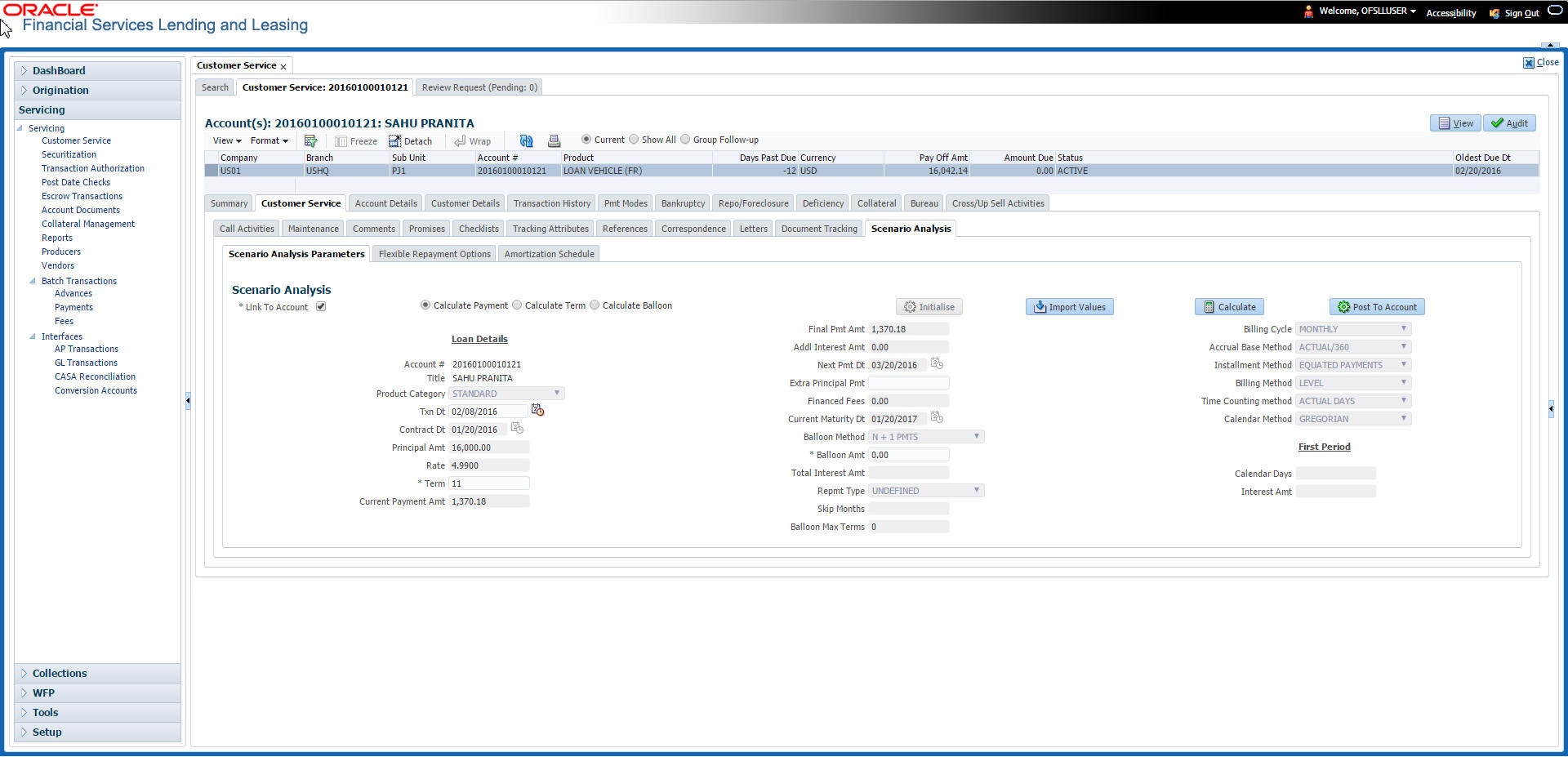
You can use the Scenario Analysis screen to calculate a change in the account’s
- Principal payment amount
- Term
- Balloon payment amount
Following are the options in Scenario Analysis screen:
- Clicking ‘Initialize’ button clears the field values.
- Clicking 'Import Values' button defaults the values from Account Details to scenario analysis screen.
- Clicking 'Calculate' button calculates values based on specified parameters.
- Clicking ‘Post To Account' post the rescheduled payment changes on to linked account (applicable to ‘Calculate Payment’ option only).
On determining the new payment schedule based on the customer’s request you can click Post to Account to replace existing schedule and update the account with new calculated amount.
The posted transaction can also be reversed in the Transactions screen (Customer Service > Transactions tab).
4.5.13 Access History
The Access History tab in Customer Service screen displays the list of users who have accessed a particular account in Oracle Financial Services Lending and Leasing application.
Irrespective of the action performed on the account or the way through which the account is accessed such as using search, queue/conditions, review requests and so on, system records every access and displays the user details in ‘Account Access History’ section.
Starting with the last user, the Account Access History section displays the list in descending order along with their logged-in User ID (Accessed By), date and time (Access Dt) of login in separate columns.
To view the account access history
- Open the Customer Service screen and load the account you want to work with.
- Click the Customer Service tab, then click Access History sub tab.
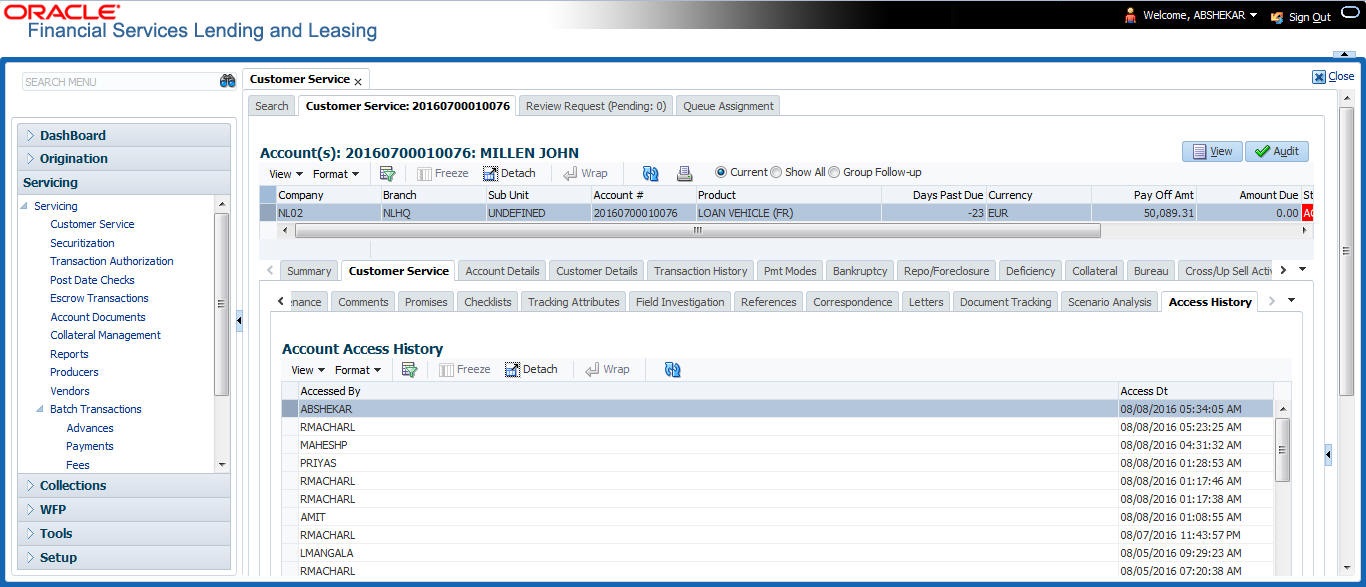
You can click  (refresh) to fetch the latest data.
(refresh) to fetch the latest data.
4.6 Customer Service screen’s Account Details tab
Open the Customer Service screen and load the account you want to work with. Click the Account Details tab to view the sections under it.
4.6.1 Account Details sub tab
Oracle Financial Services Lending and Leasing enables you to view account details using Account Details sub tab. In addition, you can use this screen to derive various account level business specific calculations and populate the computed values into the custom user defined fields.
Calculate Parameters
The ‘Calculate Parameters’ button is available in the Account Information header. Clicking on it calculates the Target parameters for Account and all Collaterals linked to the account and populates the computed values in the custom user defined fields.
However, for system to populate data in custom fields, the following setup is required:
- The custom user defined fields have to be enabled in Setup > Administration > User > Access > ‘Field Access Definition’ tab.
- User access to these custom fields are to be granted in ‘Security User Access Definition Details’ sub tab.
- If required, these fields can be customized in the ‘Label Configuration’ tab in Setup > Administration > System > Label Configuration screen.
- Further, the custom fields are to be configured to compute specific business calculations at Account level in Setup > Administration > System > User Defined Parameters screen.
For more information, refer to specific section in Setup guides.
In the Account Information section click View.
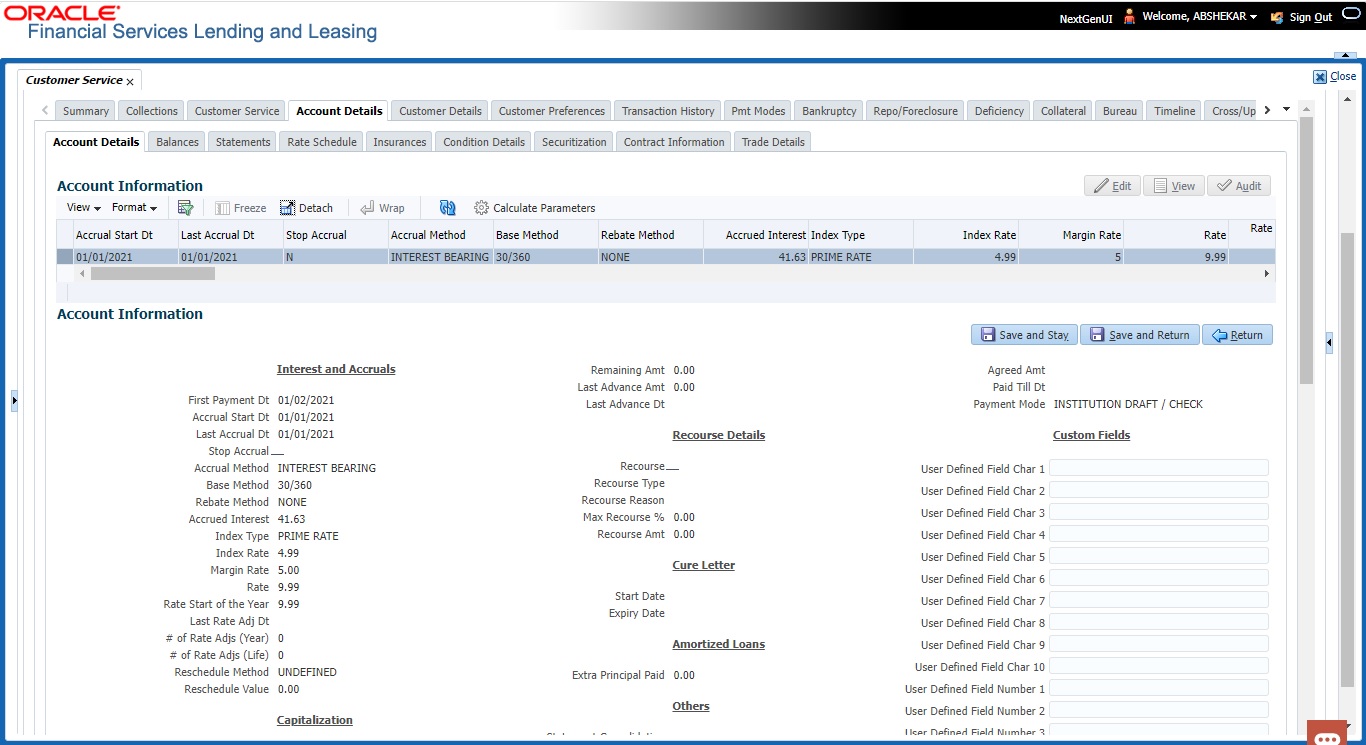
View the following information for Loan servicing product.
4.6.2 Balances sub tab
The Account Balances sub tab displays a list of different balances maintained for the account along with other details such as how the balance is derived in the system and capitalization details indicating when the balance is capitalized to the principal of account.
To view Account Balances
- Open the Customer Service screen and load the account you want to work with.
- Click the Account Details tab, then click Balances sub tab.
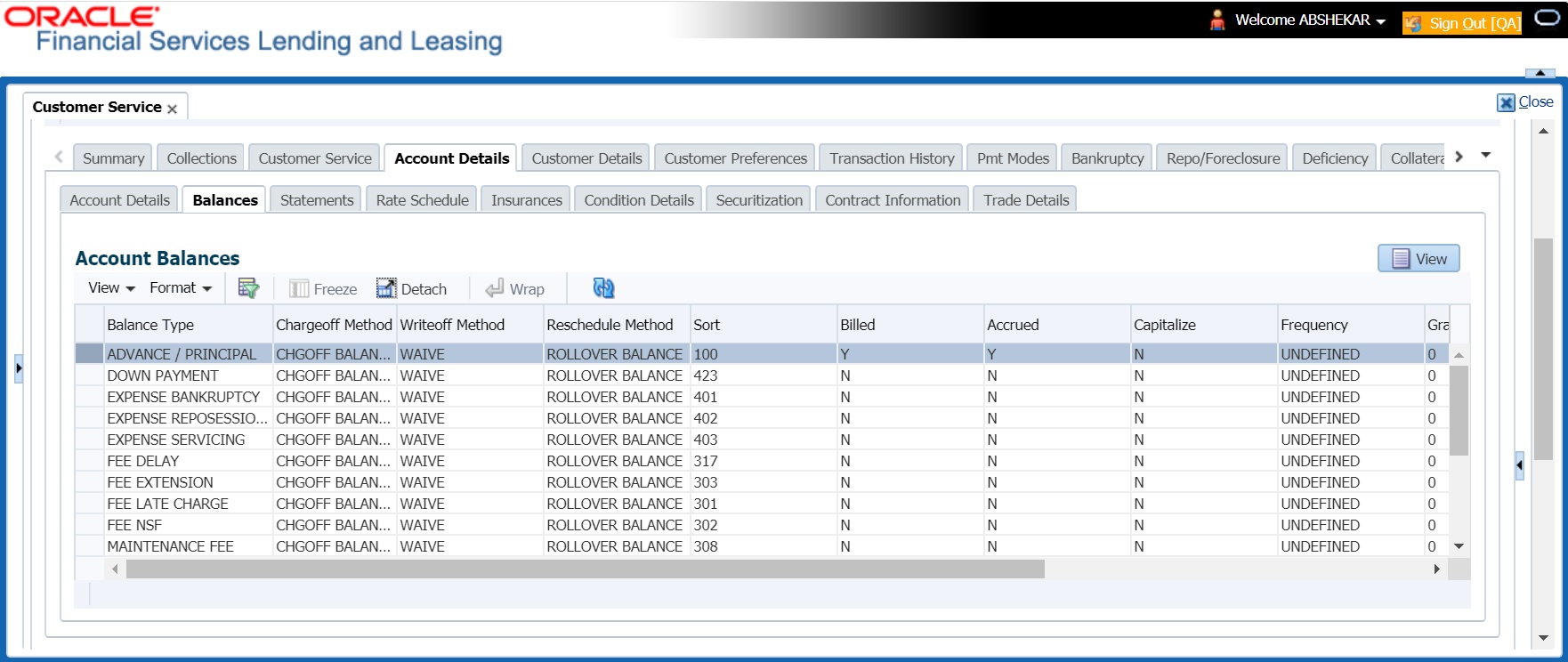
- In the Balances section, click View to view the following information:
In this field:
View:
Balance Type
The type of account balance maintained.
Chargeoff Method
The type of method to charge-off the balance.
Writeoff Method
The type of method to write-off the balance.
Reschedule Method
The applicable reschedule method.
Sort
The sort sequence maintained.
Billed
Y/N indicating if the balance is billable to customer.
Accrued
Y/N indicating if interest is accrued on the balance.
Non Performing Rollover
Rollover indicates that this balance is moved to non-performing balance.
Non Performing Balance Type
Indicated as NON PERFORMING if the balance is expected to be charged-off in the future.
Capitalize
Y/N indicating if the balance is capitalized to principal.
Frequency
The frequency with which the balance is capitalized.
Grace Days
The number of grace days allowed for capitalization.
Next Cap Run Date
The next scheduled balance capitalization date.
4.6.3 Statements sub tab
The Statements sub tab facilitates to view the list of statements generated for the account till date. In case of Master Account, you can view the list of consolidated statement of Master Account along with the associated accounts.
The Statements sub tab contains Statements, Transactions, and Messages sections. The Statements section displays a list of all statements generated during life of the account. The Transaction section displays monetary transactions applied to the account from closing date of the previous statement through closing date of the current statement. The Messages section displays user-defined message that appears in the statement.
To view the Statements screen
- Open the Customer Service screen and load the account you want to work with.
- Click the Account Details tab, then click Statements sub tab.
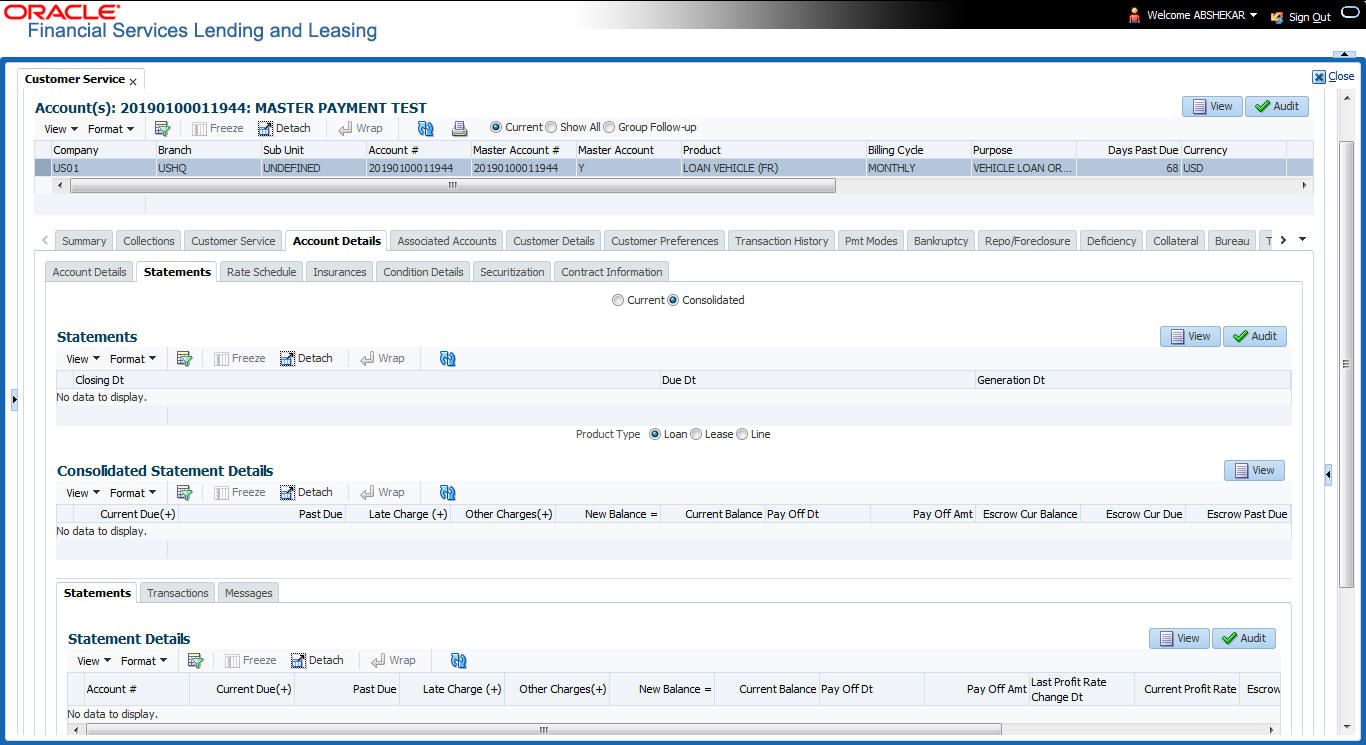
- Select either ‘Current’ or ‘Consolidated’ option.
Note the following:
- The ‘Current’ or ‘Consolidated’ option is available only for Master Account to filter and view the list of statements for current Master Account and consolidated statements of Master Account and Associated Accounts.
- On selecting ‘Consolidated’, an additional section ‘Consolidated Statement Details’ is enabled to display the list of consolidated statements for Associated Accounts having the ‘Statement Consolidation’ flag enabled in Account details.
- By default, only those accounts having the same currency of Master Account are displayed.
- The consolidated Account statements associated for each Master Account is generated on executing the batch job MASTER ACCOUNT STATEMENTS GENERATION in batch job set SET-ODD2.
- In the Statements section, click View.
View the following information:
In this field: |
View: |
Closing Dt |
The statement closing date. |
Due Dt |
The statement due date. |
Generation Dt |
The statement generation date. |
- In the Consolidated Statements Details section, select Loan / Line / Lease option to group and view the consolidated statements based on Product/Funding type. The default Product type is Master Account Product type.
- Click View and view the following information:
- In the Statements Details section, select the statement and click View.
View the following:
- Click Transactions sub tab and click View
- View the following information:
In this field:
View:
Account #
The Customer Account number.
Txn Dt
The transaction effective date.
Post Dt
The transaction posted date.
Transaction Type
The type of transaction.
Amount
The transaction amount.
Click Messages sub tab and click View.
- View the following information:
In this field:
View:
Account #
The Customer Account number.
Sequence
The sequence number.
Message
The message.
4.6.4 Rate Schedule sub tab
The Rate Schedule section contains information about rate adjustments, such as the sequence and number of adjustments.
To view the Rate Schedule screen
- Open the Customer Service screen and load the account you want to work with.
- Click the Account Details tab, then click Rate Schedule sub tab.
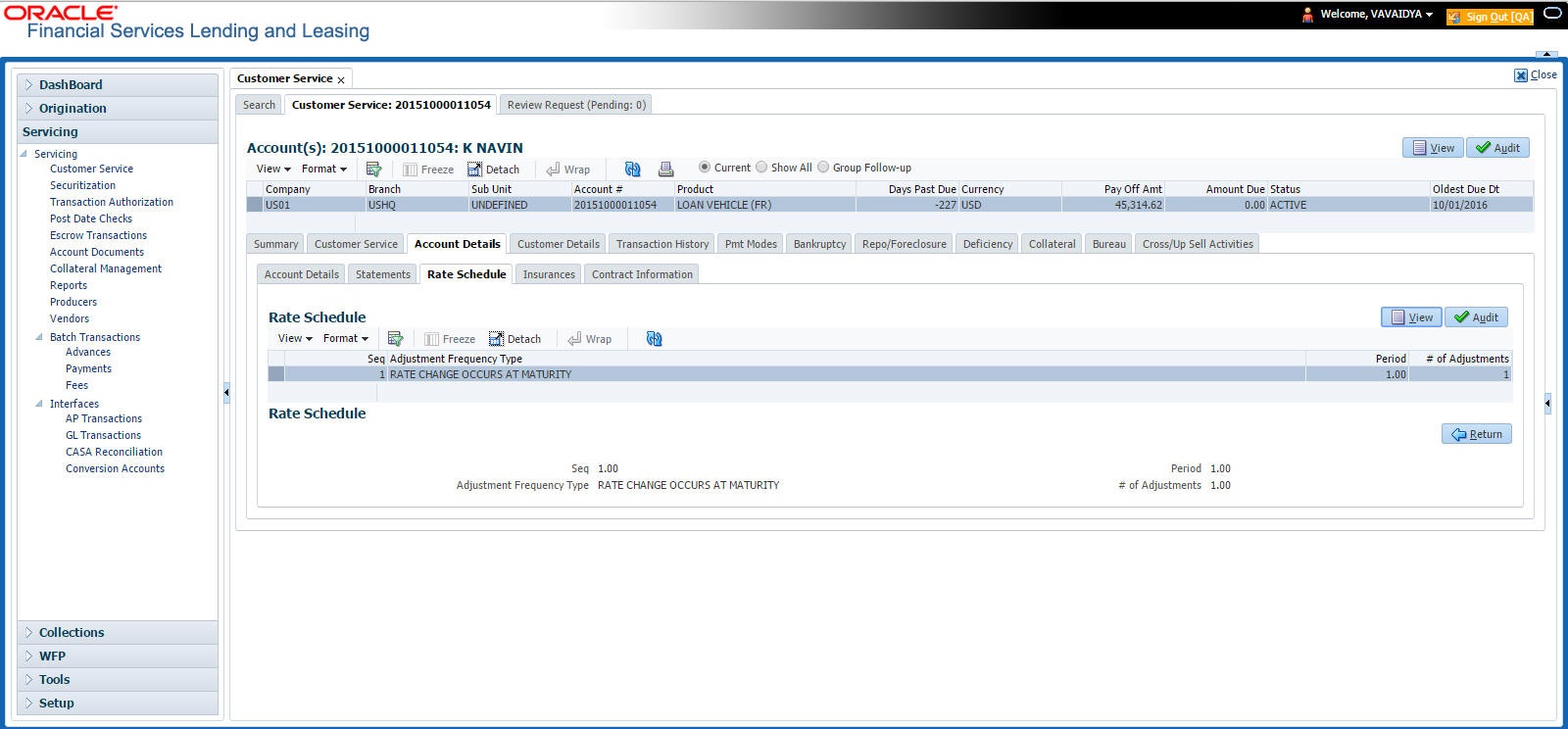
The Rate Schedule section only applies to variable rate loans.
- In Rate Schedule section, click View.
- View the following information:
In this field:
View this:
Seq
The sequence number for rate adjustment.
Adjustment Frequency Type
The rate adjustment frequency type.
Period
The rate adjustment period for the frequency.
# of Adjustments
The number of rate adjustments for the frequency.
4.6.5 Insurances sub tab
If insurance information was entered on Funding screen during Loan origination, you can view financed insurance information on the Customer Service screen’s Insurances screen. The Insurances screen displays the details of all financed insurances, including cancellation and refund information whenever applicable. It also displays the insurances that were financed after funding of Loan using the Customer Service screen’s Maintenance screen.
To view the Insurances screen
- Open the Customer Service screen and load the account you want to work with.
- Click the Account Details tab, then click Insurances sub tab.

- On the Insurances screen, view the following information in Insurance Information section:
In this field:
View:
Contractual
If selected, indicates that the insurance policy is required by contract.
Insurance Type
The insurance type.
Company
The insurance company.
Policy#
The insurance policy number.
Effective Dt
The insurance effective date.
Premium Amt
The insurance premium amount.
Term
The insurance term.
Status
The insurance status.
Click View and view the following information:
In this field: |
View: |
Policy Information section: |
|
Contractual |
If selected, indicates that the insurance policy is required by contract. |
Insurance Type |
The insurance type. |
Insurance Plan |
The insurance plan. |
Company |
The insurance company. |
Policy# |
The insurance policy number. |
Effective Dt |
The insurance effective date. |
Premium Amt |
The insurance premium amount. |
Commission Rule |
The rule of commission. |
Primary Beneficiary |
The primary beneficiary of the insurance. |
Secondary Beneficiary |
The secondary beneficiary of the insurance. |
Status |
The status. |
Sub Status |
The sub status. |
Insurance Mode |
The insurance mode. |
Phone |
The insurance company’s primary phone number. |
Phone 2 |
The insurance company’s alternate phone number. |
Itemization |
The contract itemization. |
Expiry Dt |
The insurance expiry date. |
Term |
The term of insurance. |
Commission Amt |
The insurance commission amount. |
Comments |
The comments regarding the insurance policy. |
Cancellation/Refund section: |
|
Policy Cancellation Dt |
The insurance cancellation date. |
Refund Allowed |
If selected, a refund is allowed. A selected box indicates that the insurance premium can be rebated to the customer in case of early payoff. |
Grace Days Cancellation Fee Allowed |
If selected, indicates that cancellation fees during grace period is allowed. |
Cancellation Fees |
View amount of the cancellation fee to be charged when the insurance is cancelled. |
Complete Refund |
If selected, a complete refund is allowed. |
Term Remaining |
The remaining term on the insurance at cancellation. |
Refund Calculation Method |
The refund calculation method. |
Grace Days |
View the number of grace days allowed for cancellation without charging a cancellation fee. |
Estimated Refund Amt |
The estimated insurance refund. |
Received Refund Amt |
The insurance refund received. |
Itemization |
The contract itemization. |
- In the Insurance Tracking section, click Create Tracking. The system loads insurance tracking parameters in the Insurance Tracking section.
- If you want to reduce the list of parameters, select a sub attribute in the unlabelled Sub Attribute box next to Create Tracking button.
If your system has been configured to use the Sub Attribute field, only attributes in a particular group appear in the parameter display. - Click Edit and complete the Parameter and Value fields.
- Click Save.
4.6.6 Condition Details sub tab
The Customer Service screen’s Condition Details tab displays the detailed log report of Account Vs Queue configuration changes i.e. every time an account has been changed from one queue/user/condition to another.
To view Condition Details
- Open the Customer Service screen and load the account you want to work with.
- Click Account Details tab, then click Condition Details sub tab.
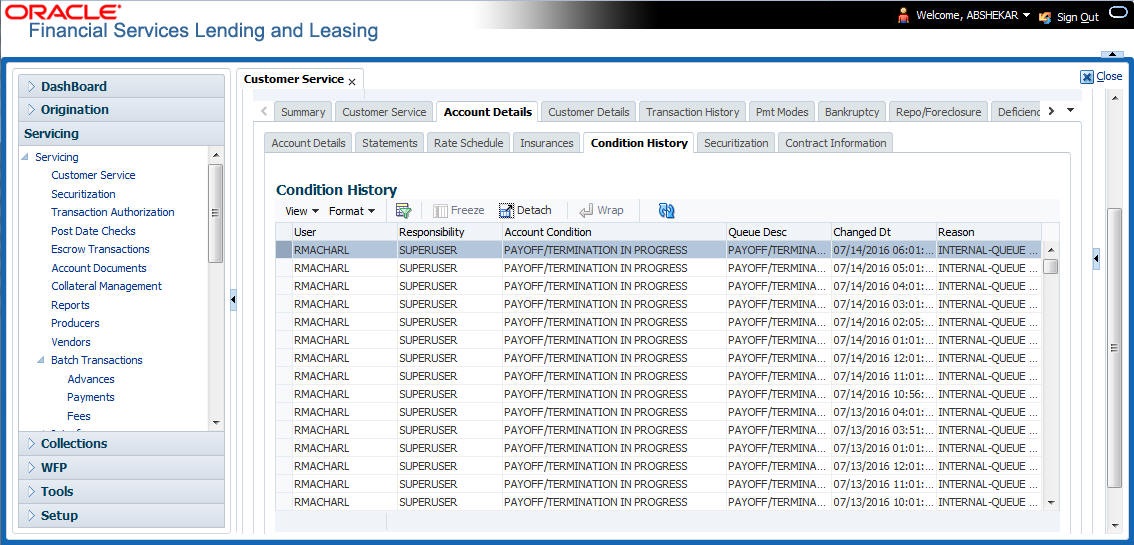
The Condition Details tab is further categorized into following sections:
- Condition/Queue
- Condition/Queue History
Condition/Queue
The Condition/Queue section displays the closed Conditions, Queues and User changes which were defined initially and later re-assigned to different Queues with Hard Assigned Users.
A current active Condition can be opened in any of the following cases:
- When a Call Activity is posted with Conditions on account
- When Conditions are posted by specific batch events
- When Conditions are posted by specific transactions (For example, Borrower on Military duty)
The Condition/Queue section displays the following information:
- User (Current Queue Assigned User If any)
- Responsibility (Current User Responsibility)
- Account Condition
- Queue Description
- Condition Start Dt
- Queue Start Dt
- User Start Dt
Condition/Queue History
The Condition/Queue section displays only the closed Conditions which were defined on the account and later was re-assigned to different Queues with Hard Assigned Users.
The Condition/Queue History section displays the following information:
- User (Old Queue Assigned User If any)
- Responsibility (Old User Responsibility)
- Account Condition
- Queue Description
- Start Date
- End Date
- Changed Date
- Change Reason
- Reason (specified in Queue Assignment tab)
In the Condition/Queue History section, select the required record and click ‘View’.
4.6.7 Securitization Sub Tab
The Securitization sub tab enables you to view the various Pool details of that account. A securitization pool is considered as ‘Super Pool’ when it is sold (i.e. status of pool is SOLD). If a Super Pool is not assigned to a pool, the ‘Super Pool’ details are displayed as ‘Undefined’ in Securitization sub tab.
When a pool with status NEW or OPEN is linked to a Super Pool and that Super Pool is sold, then Securitization tab displays the ‘Super Pool Id’ as existing Pool Id and newly added pool with previous Pool ID.
To view the securitization details
- Open the Customer Service screen and load the account you want to work with.
- Click Account Details tab, then click Securitization sub tab.
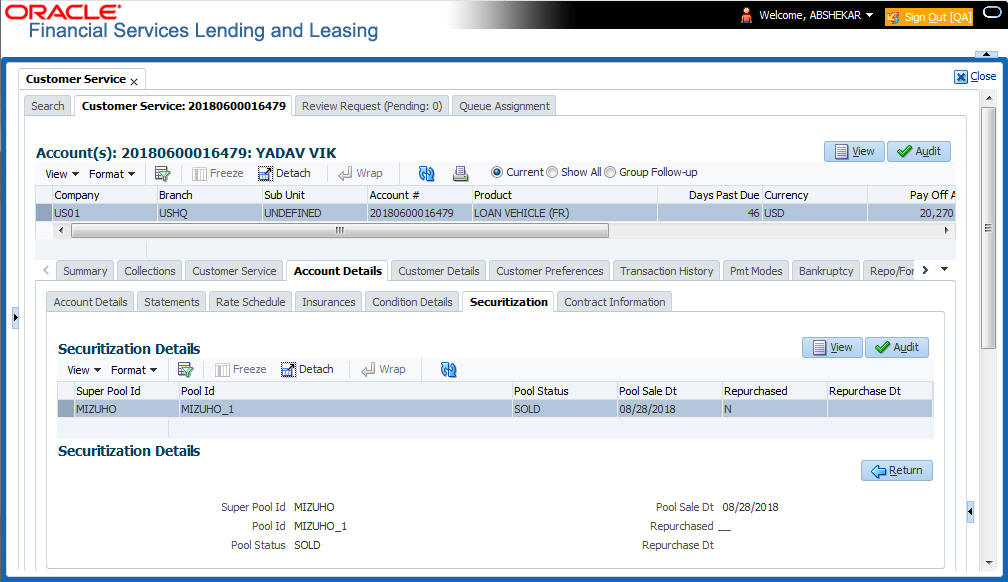
- On the Securitization sub tab, view the following Securitization details:
Securitization Details
Super Pool Id
View the Super Pool Id (Sold Securitization Pool). The same is displayed as 'Undefined' if ‘Super Pool Id’ is not configured for the pool.
Pool Id
The pool ID.
Pool Status
The pool status.
Pool Sale Dt
Pool Sale date.
Repurchased
If selected, indicates that it has been repurchased.
Repurchase Dt
The repurchase date.
4.6.8 Contract Information sub tab
The Customer Service screen Contract sub tab enables you to view contract and truth-in-lending information recorded during the funding process. It’s a display only version of the same information found on the Funding screen’s Contract screen.
To view an account’s contract information
- Open the Customer Service screen and load the account you want to work with.
- Click Account Details tab, then click Contract Information sub tab.
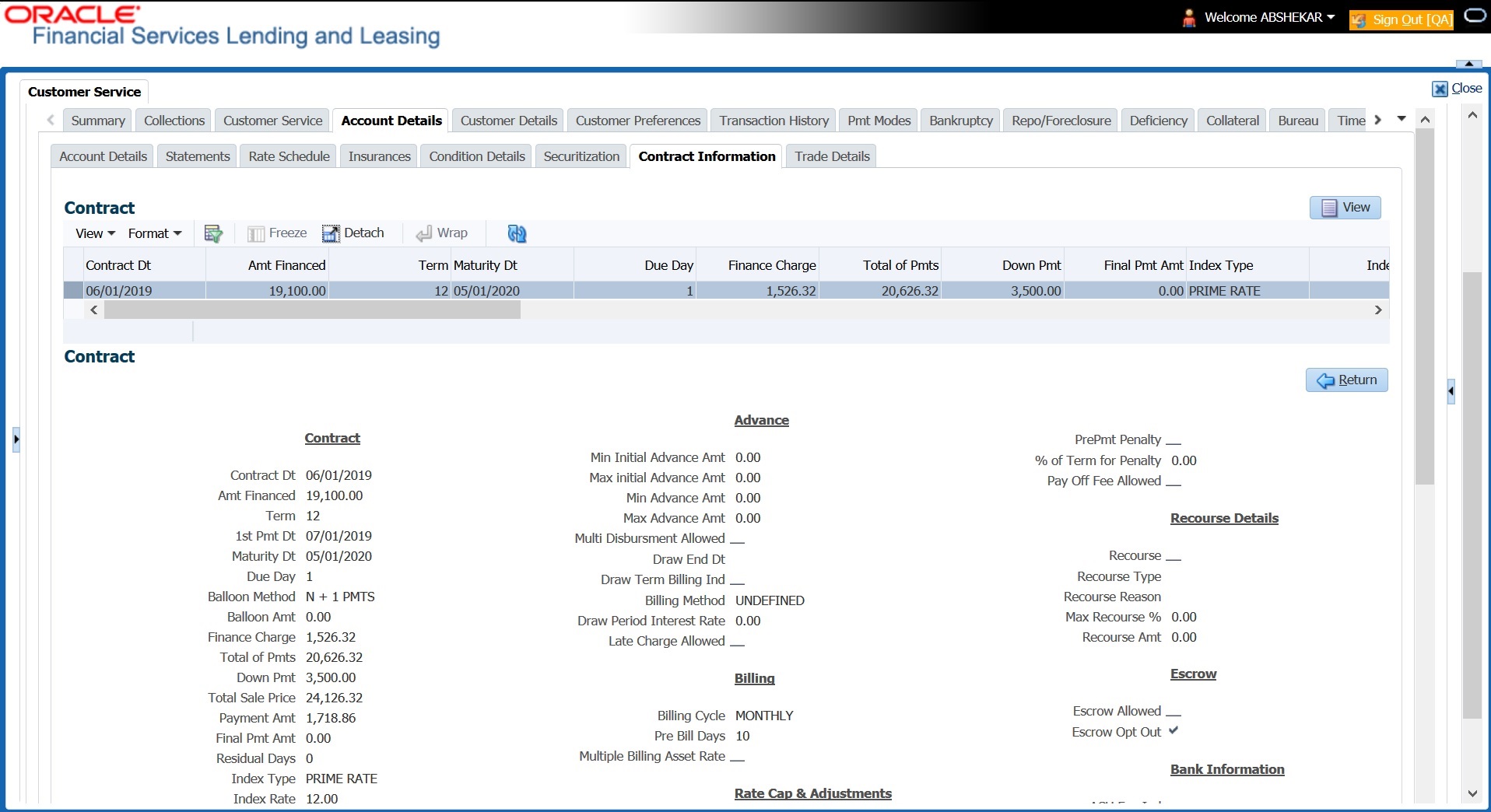
If you selected a Loan account with escrow, Escrow Analysis tab is available.
- Use the following sub tabs to view more information about the contract, if available:
- Contract
- Repayment
- Itemization
- Trade-In
- Insurances
- ESC
- Compensation
- Subvention
- Proceeds
- Disbursements
- Fees
- ACH
- Coupon
- PDC
- References
- Real Estate
For more information on the sub tabs of the Contract tab, refer the section Contracts tab in Funding chapter of the Origination User Guide.
4.6.9 Trade Details sub tab
Oracle Financial Services Lending and Leasing provides a end-to-end framework for trading of accounts and transfer of equity from an existing (old) account to a new account. To know in detail about process and workflow, refer to ‘Appendix - Trading of Accounts’ section.
The Trade Details sub tab in Account Details tab displays account level Trade related information. This is a ‘View-Only’ screen and consists of the following two sections:
- Trade Details - indicates ‘Trade Equity’ information with ‘Equity In’ and ‘Equity Out’ details on the traded accounts and Revenue Recognition information captured as part of batch job processing.
- Equity Transfer Details - indicates equity transfer between From and To accounts, the ‘Equity Transferred’ value and ‘Status’ of Trade.
To view the Trade details
- Open the Customer Service screen and load the account you want to work with.
- Click Account Details tab, then click Trade Details sub tab.
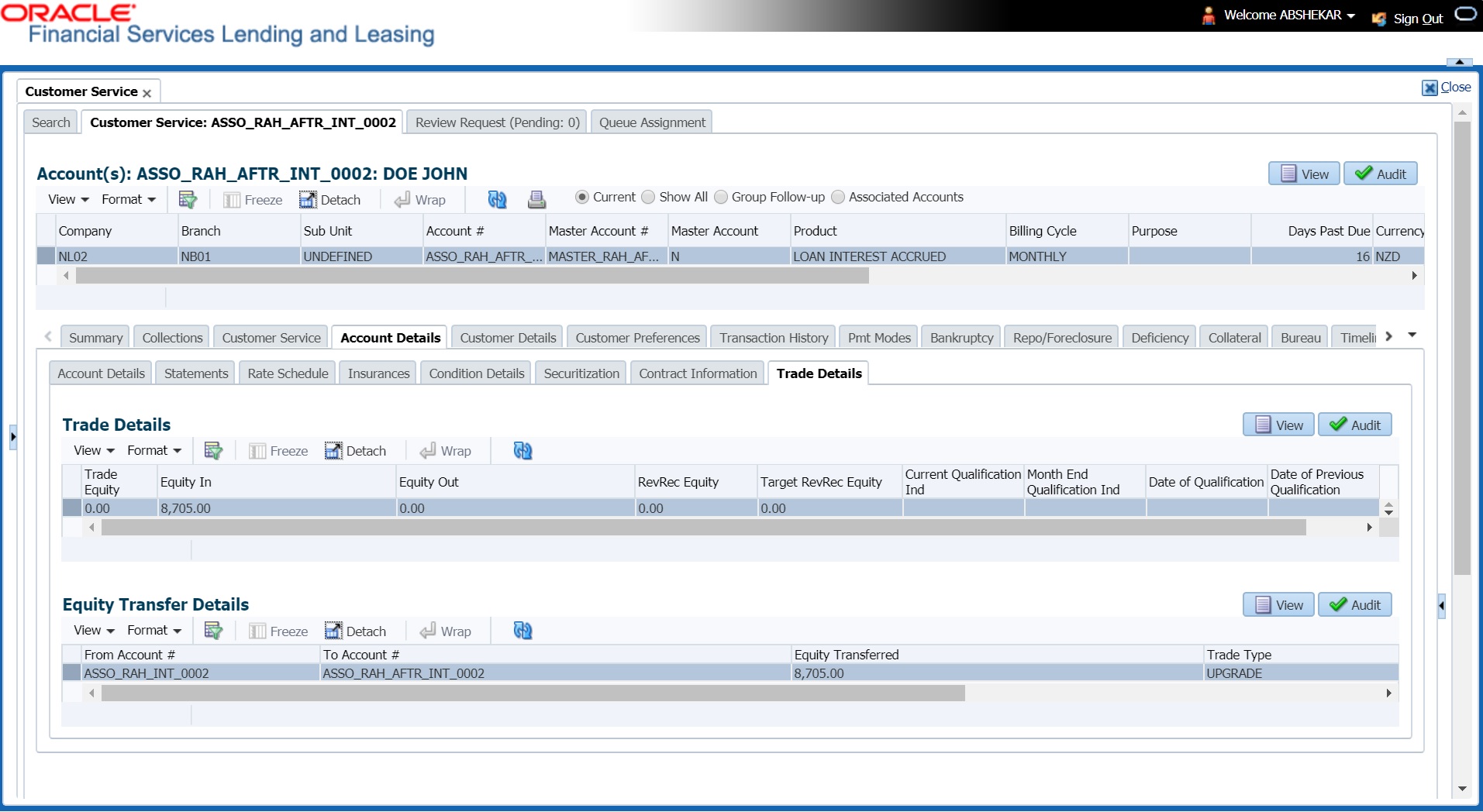
- In the Trade Details section, view the following details:
In this field:
View:
Trade Equity
View the value of current Account Trade Equity.
This is calculated using the configurable calculation value defined for ACC_EQUITY_AMT in Setup > User Defined Parameters screen.
This value is re-calculated during trade transaction.
Equity In
View the total of all Equity transferred ‘from’ different old account(s) contributing to trade.
This field is updated when ‘Equity In Transfer Transaction’ is processed during trade.
Equity Out
View the total of all Equity transferred ‘to’ different new account(s) as part of trade.
This field is updated when ‘Equity Out Transfer Transaction’ is processed during trade.
The below fields indicate the Revenue Recognition details of the Account and are populated on executing the ‘Revenue Recognition Processing Batch Jobs’.
Note: In Vacation Ownership Industry, Vendors recognize revenue when equity becomes greater than or equal to threshold value (X)% of net sale price of the asset on the contract. Once the revenue is recognized, Account is marked as Qualified (i.e. Target Revenue is recognized).
RevRec Equity
View the Account Revenue Recognition Equity Amount. The value is populated based on calculation defined in User Defined Parameters.
Target RevRec Equity
View the Account Target Revenue Recognition Equity Amount. The value is populated based on calculation defined in User Defined Parameters.
Current Qualification Ind
View the Account Revenue Recognition Qualifier indicator. Here ‘Y’ indicates that the Contract Equity is ‘greater than or equal to’ Account Revenue Recognition Equity.
Month End Qualification Ind
View the Account Revenue Recognition Qualifier Month End indicator. Here ‘Y’ indicates that account qualification is required at end of month.
Date of Qualification
View the Account Revenue Recognition Qualifier Date.
Date of Previous Qualification
View the Last Account Revenue Recognition Qualifier Date when the account was previously qualified.
4.6.9.1 Revenue Recognition Processing Batch Jobs
Following are the Revenue Recognition processing batch jobs:
Note that, both the batch jobs picks-up all the accounts only with ‘ACTIVE’ status, the Trade Equity greater than zero and Master Account indicator set as ‘N’.
- DAILY REVENUE RECOGNITION PROCESSING (SET-REV1 Batch Job Set)
This batch job is processed daily and is used to validate if Account Revenue Recognition Equity is ‘greater than or equal to’ Target Revenue Recognition Equity. If yes, the Current Qualification Indicator is set to ‘Y’. However, the above validation is ignored and Current Qualification Indicator is always set to ‘N’ if the account is having any condition listed in the lookup code REVREC QUALIFIER EXCLUSION ACCOUNT CONDITION.
- MONTH END REVENUE RECOGNITION PROCESSING (SET-REV2 Batch Job Set)
This batch job is processed monthly and is used to validate the status of ‘Account Revenue Recognition Qualifier indicator’ and update the following fields as indicated in below table.
- Account Revenue Recognition Qualifier Month End indicator (after month end processing)
- Account Revenue Recognition Qualifier Date
- Last Account Revenue Recognition Qualifier Date
Date of Processing
Account Revenue Recognition Qualifier indicator
Account Revenue Recognition Qualifier Month End indicator (after month end processing)
Account Revenue Recognition Qualifier Date
Last Account Revenue Recognition Qualifier Date
01-Jan-19
N
N
15-Jan-19
Y
N
31-Jan-19
Y
Y
31-Jan-19
01-Feb-19
N
Y
31-Jan-19
28-Feb-19
N
N
31-Jan-19
01-Mar-19
Y
N
31-Jan-19
31-Mar-19
Y
Y
31-Mar-19
01-Apr-19
Y
Y
31-Mar-19
30-Apr-19
Y
Y
31-Mar-19
01-May-19
N
Y
31-Mar-19
15-May-19
Y
Y
31-Mar-19
31-May-19
Y
Y
31-Mar-19
- In the Equity Transfer Details section, view the following details:
In this field:
View:
From Account #
Existing (old) account number or Source account number.
To Account #
New account number or Target account number.
Equity Transferred
Value of Equity transferred to new account as part to trade.
Trade Type
Type of Trade transaction processed as one of the following:
UPGRADE
SPLIT
COMBINE
For more details on Trade Type, refer to ‘Trade Transaction’ section.
Status
Status of Trade transaction processed as one of the following:
OPEN
COMPLETED
FAILED
- Click
 Refresh to update the latest details on screen.
Refresh to update the latest details on screen.
4.7 Customer Service screen’s Associated Accounts tab
The Associated Accounts screen displays all the accounts associated with the selected Master Account in the ‘Associated Account Details’ section along with a summary of rolled-up balances for the accounts being displayed.
In the ‘Associated Account Details’ you can use a combination of following type of filters to sort and display the matching account(s).
- Product Type - Here you can either select a specific product or select ‘All’ to display corresponding accounts in combination of Master and associated accounts. However, system defaults this option based on the product type of Master Account.
Command Button:
Action Performed:
Loan
If selected, system filters and displays all Loan accounts associated with Master Account. The ‘Summary’ section displays consolidated/rolled-up balance of all accounts including Master account if the same is also a ‘Loan’ account.
Line
If selected, system filters and displays all Line accounts associated with Master Account. The ‘Summary’ section displays consolidated/rolled-up balance of all accounts including Master account if the same is also a ‘Line’ account.
Lease
If selected, system filters and displays all Lease accounts associated with Master Account. The ‘Summary’ section displays consolidated/rolled-up balance of all accounts including Master account if the same is also a ‘Lease’ account.
All
If selected, system displays all accounts associated with Master Account of same currency. The ‘Summary’ section displays consolidated/rolled-up balance of all accounts including Master account.
- Statement Consolidation Only - If check box is selected, system filters and displays ALL or Product Type specific accounts having the Statement Consolidation indicator enabled. The ‘Summary’ section displays consolidated/rolled-up balance of all displayed accounts including Master account if the same also has the statement consolidation indicator enabled.
- By default this check box is not selected and system displays ALL/selected Product Type irrespective of the Statement Consolidation indicator (Enabled or Disabled).
- All Currencies - By default, system displays only those accounts having the same currency as that of Master Account. Clicking on this check box displays all the accounts associated with Master Account irrespective of the currency with which the account is operated. Also if checked, only the Accounts counters are updated in ‘Summary’ section and Dues are reset to zero.
- Agreement Number - This option provides a drop-down list with all unique agreement numbers present in the sorted list of account(s). On selecting any of the Agreement Number from the drop-down list, system filters and displays only those accounts associated with the selected agreement number.
At the bottom of the grid, you can view the Count with total number of records displaying in Associated Account Details.
To view associated account details
- Open the Customer Service screen and load the account you want to work with.
- Click ‘Associated Accounts’ sub tab.
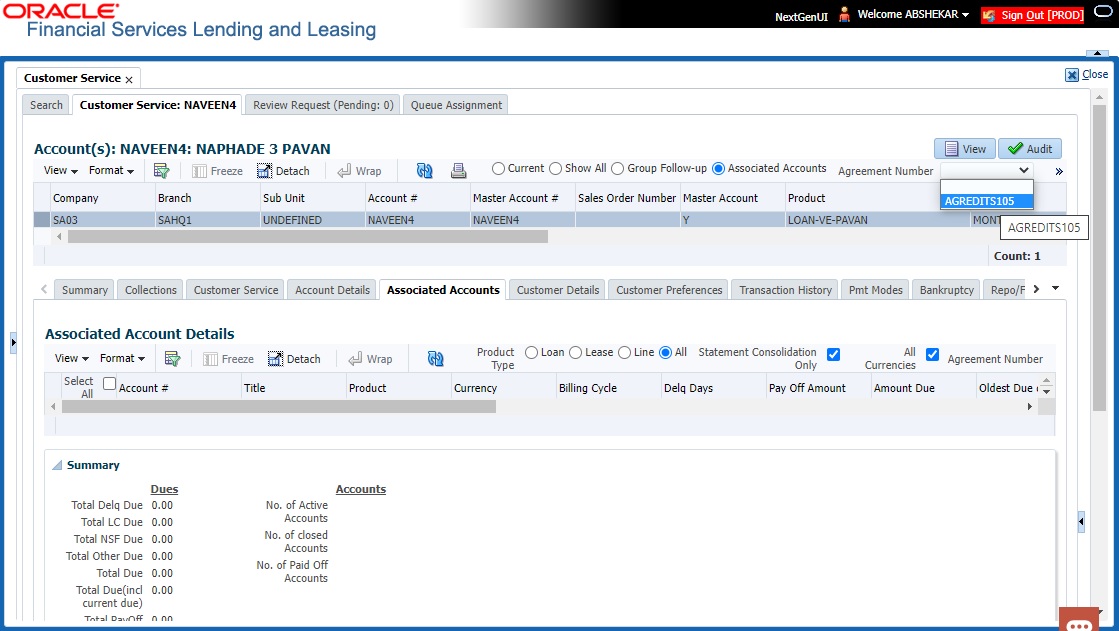
A brief description of ‘Associated Account Details’ are given below:
In this field: |
View this: |
Account # |
The account number. Clicking on the hyperlink opens the respective account in Customer Servicing screen. |
Title |
The title of the account. |
Product |
The type of product associated with the account. |
Currency |
The disbursement currency. |
Billing Cycle |
The billing frequency. |
Delq Days |
The number of days the account has been delinquent. |
Pay Off Amount |
The total pay off amount on the account. |
Amount Due |
The total amount due on the account. |
Oldest Due Dt |
The oldest payment due date on the account. |
Status |
The status of the account. |
Asset Type |
The type of asset associated with the account. |
Asset Sub Type |
The asset sub type. |
Collateral Description |
Details of primary collateral associated with account. In case of Home Collateral, no Collateral Description is displayed. |
Identification # |
The identification number of the asset. |
Company |
The portfolio company. |
Branch |
The portfolio branch. |
Statement Consolidation |
If checked, this account will be part of Consolidated ‘MASTER CUSTOMER/BUSINESS STATEMENT’ generated at Master Account. Else, this account is not included in Consolidated ‘MASTER CUSTOMER/BUSINESS STATEMENT. |
Linked Account |
The linked Account number. The same is displayed as UNDEFINED if the account is neither marked as ‘Master Account’ nor ‘Linked to Existing Associated Account’. |
The ‘Summary’ section displays the rolled-up balances of the following fields in all accounts displayed:
In this field: |
View this: |
Dues section - This section displays the total number of accounts available for the selected filter combination of Master and Associated accounts. |
|
Total Delq Due |
The total of delinquent amount due on all the filtered accounts at Associated Account Details tab. |
Total LC Due |
The total non-sufficient fee due amount on all the accounts. |
Total NSF Due |
The total of non-sufficient funds fee due on all the accounts. |
Total Other Due |
The total of any other dues pending on all the accounts. |
Total Due |
The total of all dues including payment amount and all applicable fees on all the accounts. |
Total Due (incl current due) |
The total of additional due of current month (included based on pre-bill days) on all accounts. |
Total PayOff Amount |
The total amount payable by the borrower of all accounts if the same is to be paid off as per the current date. |
Accounts section - This section displays the total number of accounts available for the selected filter combination of Master and Associated accounts. |
|
No. of Active Accounts |
Total Number of Active accounts. |
No. of closed Accounts |
Total Number of Closed accounts. |
No. of Paid Off Accounts |
Total Number of Paid Off accounts. |
4.8 Customer Service screen’s Customer/Business Details tab
Open the Customer Service screen and load the account you want to work with. Click the Customer/Business Details tab to view the sections under it.
If the selected account belongs to an individual Customer, this tab is displayed as ‘Customer Details’ and if there is no customer linked and only a business is involved in the account, this tab is displayed as ‘Business Details’. In case both Customer and Business are involved in the account, this is still displayed as ‘Customer Details tab’ and both the sub tabs ‘Customer’ and ‘Business’ are displayed.
Customer/Business Details screen displays the information gathered on application entry process regarding the customer and customer’s address, employment data, phone numbers and credit score. Using this screen, you can update or add to a customer’s address, employment information, or phone listing. Whenever you add or edit the details, a system generated comment will be posted in the account to keep record of old and new details.
Note that the ‘Edit’ option on this screen has user level security defined and based on your responsibility, you can either edit a few or all of the fields. The difference is that, you may either have access to edit only non-PII (Personal Identifiable Information) fields or edit all possible fields as per the customer maintenance transaction.
The list of possible editable fields in both these scenarios is given below:
Edit non-PII fields |
All editable fields |
Marital Status |
Birth Date |
Language |
Marital Status |
Education |
Language |
Mother's Maiden Name |
Education |
Class Type |
Mother's Maiden |
Class Type |
|
Stop Correspondence |
|
Disability |
Stop Correspondence |
Skip |
Disability |
Privacy opt out |
Skip |
Existing CIF |
Privacy Optout |
|
Existing CIF |
|
Identification Details like |
|
Passport |
|
Issue Date |
|
Expiry Date |
|
Visa # |
|
Nationality |
|
National ID |
|
SSN |
|
License # |
|
License State |
4.8.1 Customer sub tab
Using the Customer sub tab, you can view and update the existing Customer details. When an existing record is updated and saved, the same becomes the current/primary details of the customer and the current indicator is set to ‘Y’ by default. In such a case, the previous customer details are disabled (set to N). You can select the ‘Show All’ check box in Customer Information section to view the disabled records along with current record.
To view or edit customer information
- Open the Customer Service screen and load the account you want to work with.
- Click Customer Details sub tab.

- In the Customer Information section, click ‘Edit’. You can also perform any of the Basic Operations mentioned in Navigation chapter. A brief description of the fields are given below:
In this field:
View this:
Customer Information section
Customer #
Customer number.
Relation
Customer ‘s relation with the bank.
ECOA
The Equal Credit Opportunity Act code.
Name
Customer’s name.
Birth Dt
Customer’s date of birth.
Marital Status
Customer’s marital status.
Enabled
Status of the account.
Language
Customer’s language.
Education
Customer’s education.
Mother’s Maiden Name
Customer’s mother’s maiden name.
Class Type
Customer’s class type.
Email
Customer’s e-mail address.
Stop Correspondence
Customer’s stop correspondence indicator. If selected, this indicates that the system will not send the customer any correspondence, such as monthly statements. This is selected using the Maintenance screen.
Disability
Customer’s disability indicator.
Skip
Customer’s skip indicator. If selected, this indicates that the customer is a skip debtor. This is selected using the Maintenance screen.
Bankruptcy
Customer’s bankruptcy indicator.
Privacy Opt-Out
Privacy opt-out indicator. If selected, indicates that the applicant has elected to refrain from the non-public sharing of information.
Insurance Opt Out
Insurance Opt Out indicator. If selected, indicates that the applicant has elected to refrain from insurance related inquiries.
Marketing Opt Out
Marketing Opt Out indicator. If selected, indicates that the applicant has elected to refrain from marketing related inquiries.
Share Credit Opt Out
Share Credit Opt Out indicator. If selected, indicates that the applicant has elected to refrain from financial information and share credit related inquiries.
Existing CIF
If selected, indicates that the customer is an existing CIF.
Update Customer Info
If selected, indicates that the system was allowed to override the existing customer information with the latest address and communication details during account creation.
Identification Details section
Passport #
Customer’s passport number.
Issue Dt
Passport issue date.
Expiry Dt
Passport expiry date.
Visa #
Customer’s visa number.
Nationality
Customer’s nationality.
National ID
Customer’s national identification.
SSN
Customer’s social security number. If the organizational parameter UIX_HIDE_RESTRICTED_DATA is set to Y, this appears as a masked number; for example, XXX-XX-1234.
License #
Customer’s licence number.
License State
State where the licence was issued.
Payment Hierarchy
The payment hierarchy is auto-populated by the system based on following conditions:
- While funding an application with new customer details, the payment hierarchy is populated with value specified in system parameter PMT_HIERARCHY_CODE.
- While funding an application with existing customer details, the same payment hierarchy selected for existing customer record is populated.
The auto populated payment hierarchy can be modified by selecting the required value from the drop-down list. This list is populated based on the hierarchy definitions maintained in Setup > Administration > User > Payment Hierarchy screen.
Military Service
Active Military Duty
Active military duty indicator. If selected, indicates that customer is on active military duty and may qualify for rates in accordance with the Service members Civil Relief Act of 2003 (SCRA).
Effective Dt
The effective date
Order Ref #
The order reference number.
Release Dt
The release date.
Customer Decease Date
The deceased date of the customer. You can also post a non monetary transaction to indicate if a customer is deceased. Refer to section Mark Customer as Deceased for more information.
KYC section
Reference #
Specify the reference number of KYC document.
Status
Select the status of KYC document from drop-down list.
FATCA section
Birth Place
Specify the birth place of the applicant.
Birth Country
Select the country of birth of the applicant from drop-down list.
Permanent US Resident Status
Check the box to indicate if the applicant has permanent US resident status.
Power of Attorney section
Power of Attorney
Check the box to indicate that the applicant holds Power if Attorney.
Holder Name
Specify the holder name of the power of attorney.
Address
Specify the address of the attorney holder.
Country
Select the country of the power of attorney holder from drop-down list.
Nationality
Select the country of the power of attorney holder from drop-down list.
Telephone Number
Specify the telephone number of the power of attorney holder.
Credit Limit Details section
Max Limit
View the maximum credit limit amount sanctioned for this customer.
Total Utilized Amt
View the total credit limit amount utilized.
Available Amt
View the credit limit available amount from the sanctioned limit.
Hold Amt
View the credit limit amount on Hold.
Suspended Amt
View the credit limit amount suspended.
Grade
View the grade of the customer.
Max Late Charge
View the maximum amount of late charge that can be levied for this customer. However, there is no system validation performed based on the amount specified.
Limit Expiry
View the credit limit expiry date.
Limit Next Renewal
View the date when credit limit has to be renewed.
Utilization Details
% of Utilization
View the percentage of credit limit used to fund the account against the customer.
Utilization Amount
View the amount of credit limit contribution of customer towards Account current balance.
- Perform any of the Basic Actions mentioned in Navigation chapter.
When military duty transaction is posted on an account, the system does the following:
- Restricts the user from posting repossession/ foreclosure and bankruptcy activities on the account.
- Posts “DO NOT CHARGE OFF” condition on that account to exclude the account from Auto Charge Off process.
4.8.1.1 Addresses sub tab
- In the Address sub tab, click ‘Add’. You can also perform any of the Basic Operations mentioned in Navigation chapter. A brief description of the fields are given below:
In this field:
View this:
Type
The address type.
Current
If selected, indicates that this is the customer’s current address.
Confirmed
Check this box to indicate that the address is confirmed by the customer.
Mailing
Check this box to indicate that this is the customer’s mailing address.
Permission to Call
Check this box if customer has provided permission to contact through the specified phone number.
Permission to Text
Check this box if customer has provided permission to contact through text message.
Country
The country.
Postal Address Type
The postal address type.
Address #
The address.
Street Pre
The street pre.
Street Name
The street name.
Street Type
The street type.
Street Post
The street post.
Apt #
The apartment number.
Address 1
The customer’s address.
Address 2
The customer’s address.
Address 3
The customer’s address.
Zip
The zip code.
Zip Extn
The zip code extension.
City
The city.
State
The state code.
Phone
The phone number.
Address
The address.
Time Zone
View the customer time zone auto populated form TIME_ZONE_CD lookup code.
Census Tract/BNA Code
The census tract/BNA code.
MSA Code
The metropolitan statistical area (MSA) code.
Comment
Comments regarding the address.
- Perform any of the Basic Actions mentioned in Navigation chapter.
4.8.1.2 Telecoms sub tab
When you add new Telecom details or update existing details and save the record, the same becomes the current/primary Telecom of the customer and the current indicator is set to ‘Y’ by default. In such a case, the previous Telecom details are disabled (set to N).
- In the Telecom sub tab, click ‘Add’. You can also perform any of the Basic Operations mentioned in Navigation chapter. A brief description of the fields are given below:
In this field:
Do this:
Type
Select the telecommunication type.
Phone
Specify the phone number.
Extn
Specify the phone extension.
Current
Select if this telecom number is current.
Permission to Call
Check this box if customer has provided permission to contact through the specified phone number.
Permission to Text
Check this box if customer has provided permission to contact through text message.
Time Zone
Select the applicant’s time zone.
Start Time
Specify the best time to call start time.
End Time
Specify the best time to end the call.
Period
Specify the time period.
Best day to call
Select the preferred day of the week to contact the customer from the drop-down list.
End Time
Specify the best time to end the call.
Period
Select the time period for the best time to call end time, am or pm, from the drop-down list.
- Perform any of the Basic Actions mentioned in Navigation chapter.
4.8.1.3 Employments sub tab
- In the Employment sub tab, click ‘Add’. You can also perform any of the Basic Operations mentioned in Navigation chapter. A brief description of the fields are given below:
In this field:
View this:
Current
If selected, indicates that this is the customer’s current address.
Permission to Call
Check this box if customer has provided permission to contact through the specified phone number.
Permission to Text
Check this box if customer has provided permission to contact through text message.
Type
The occupation.
Employer
The employer’s name.
Occupation
The occupation.
Title
The title.
Department
The department of the employment.
Country
The country.
Address #
The address line.
Address Line 1
The employer’s address.
Address Line 2
The employer’s address.
Zip
The zip code.
Zip Extn
The zip code extension.
City
The city.
State
The state.
Phone
The work phone number.
Extn
The work phone number extension.
Comment
Comments regarding the employment.
Pay Day
View or select the payment day of the month using the adjoining calendar.
For OFSLL generated accounts, system propagates the Pay Date defined in Origination > Application Entry > Applicant Tab > Employments Sub Tab and is editable.
For conversion accounts, you need to select the payment day.
Next Pay Day
The next payment day is auto populated based on the Pay Day and Frequency specified. When ‘Pay Day’ is selected, system posts a non-monetary transaction - EMPLOYMENT ADDRESS MAINTENANCE to calculate the next payment day after the current date has elapsed.
Frequency
Select the income frequency from the drop-down list.
- Perform any of the Basic Actions mentioned in Navigation chapter.
4.8.1.4 Tracking Attributes sub tab
You can add tracking attribute information to an application at any time on the Customer Details screen’s Customer Tracking Attributes section.
The Tracking Attributes for Line of credit accounts in this screen can also be loaded in bulk through file upload process. While doing so, ensure that the input data file definitions are in sync with attribute names. Before processing the bulk upload, system validates if the Tracking Attributes are already loaded. If not, system loads the Tracking Attributes and then updates the details.
In the Tracking Attributes section, click Edit
When you click Create Tracking, the system loads the tracking parameters.
- If you want to reduce the list of parameters, select a sub-attribute in the Sub Attribute box.
- If your system has been configured to use the Sub Attribute field, only attributes in a particular group appear in the Parameter display.
- specify the requested parameter in the Value field and click Save.
Save any changes you made to the account.
4.8.1.5 Customer Score
Customer score or FICO score, also referred to as ‘Fair Isaac & Company’ credit score is a numeric summary of credit history compiled by the three major credit bureaus - Equifax, Trans Union, and Experian. This is obtained during Credit bureau pull and is one of the indicator for a customer (SSN) in the entire credit report.
The Customer Score tab displays all the customer FICO score data maintained in the system. Though the customer score is recorded while funding, the same can be captured and updated regularly during the life cycle of Loan to get a snapshot of credit score movements in recent history.
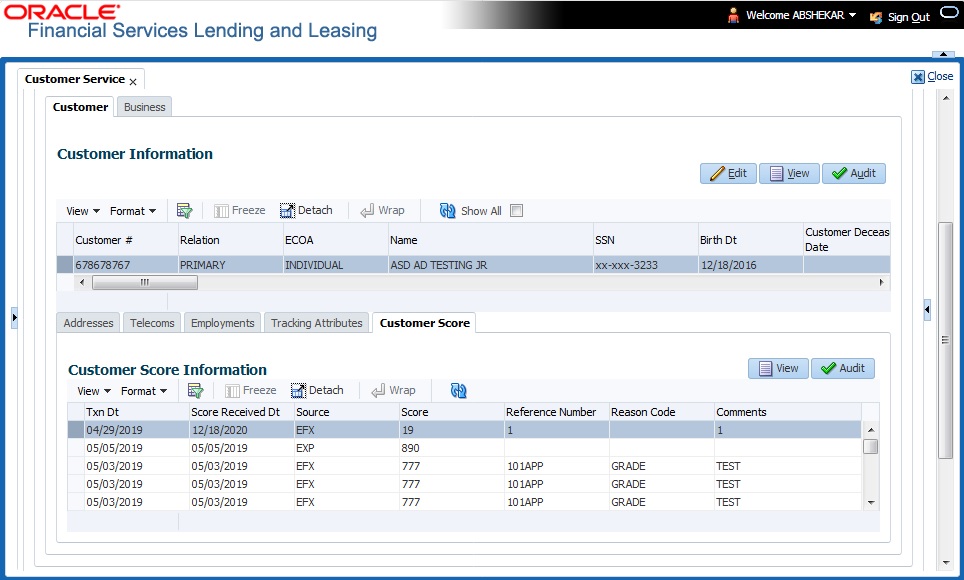
The customer score can be updated on required intervals by posting ‘Customer Credit Score Update’ non-monetary transaction and the data is populated into this screen. For more information, refer to Customer / Business Credit Score Update section.
In the ‘Customer Score Information’ section, select the required record and click ‘View’.
A brief description of the fields are given below:
In this field: |
View this: |
Txn Dt |
View the transaction posted date. |
Score Received Dt |
View the date when customer score was received from credit bureau. |
Relation Type Code |
View the account relation type (Primary, Spouse, and so on) which are attached to account. |
Source |
View the name of credit bureau from where the credit score is received. |
Score |
View the customer credit score value. |
Reference Number |
View the reference number associated with the credit score. |
Reason Code |
View the reason for posting this transaction. |
Comments |
Additional information if any. |
4.8.2 Business sub tab
If this is a SME or Business Loan, information gathered on the application entry process regarding the business and business’s address, partners data, affiliates data, phone numbers and business credit score appears on the Customer Service screen’s Business sub tab.
Using the Business sub tab, you can add new business details to an account and/or update the existing business’s address, partners and affiliates information, or phone listing. New business details can be added even after an account is created and is usually done in case when the existing business is taken over by another business.
When you add new business or update existing details and save the record, the same becomes the current/primary business of the customer and the current indicator is set to ‘Y’ by default. In such a case, the previous business details are disabled (set to N). You can select the ‘Show All’ check box in Business Details section to view the disabled records along with current business details.
On adding a new business, the Business # is auto generated by the system and other details such as business’s Addresses, Telecoms, Partners, credit score and so on are to be manually updated. Also, if there is a pre-defined Customer Credit Limit allocation to an existing business, the same is reinstated to new business automatically.
You can also add/update business details by posting a non monetary transaction. For more information, refer to Add/Update Business Customer Details section in Appendix chapter.
To add or edit business information
- Open the Customer Service screen and load the account you want to work with.
- On the Customer Service screen, click the Customer Details tab and then click Business.

- In the Business Details section, click ‘ADD’. You can also perform any of the Basic Operations mentioned in Navigation chapter. A brief description of the fields are given below:
In this field:
View this:
Current
‘Y’ indicates that it is the current / primary business of customer associated with the account. ‘N’ indicates a non primary Business.
Business #
View the system generated business number. This field is displayed only while you update existing Business details.
Organization Type
Select the Organization type from the drop-down list.
Type of Business
Select the Type of the business from the drop-down list.
Business Category
Select the Business category from the drop-down list.
Name of the Business
Specify the name of business.
Legal Name
Specify the legal name of the business.
Tax Id #
Specify the Tax identification number.
Start Dt
Select the Business start date from adjoining calendar.
# of Employees (Cur)
Specify the current number of employees at the business.
# of Employees
Specify the number of employees at the business after financing.
Contact Person
Specify the contact person at the business.
Business Checking Bank
Specify the bank name of the business’s checking account.
Bank Acc #
Specify the bank account number of the business.
Avg Checking Balance
Specify the average checking balance.
# of Locations
Specify the number of locations where the business is established.
Management Since
Specify the year the current management was established.
Payment Hierarchy
The payment hierarchy is auto-populated by the system based on following conditions:
- While funding an application with new customer details, the payment hierarchy is populated with value specified in system parameter PMT_HIERARCHY_CODE.
- While funding an application with existing customer details, the same payment hierarchy selected for existing customer record is populated.
The auto populated payment hierarchy can be modified by selecting the required value from the drop-down list. This list is populated based on the hierarchy definitions maintained in Setup > Administration > User > Payment Hierarchy screen.
Stop Correspondence
Stop correspondence indicator. If selected, Oracle Financial Services Lending and Leasing will not send correspondence to the business.
Skip
Business’s skip indicator. If selected, indicates that the Business has debts and the customer is a skip debtor.
Bankruptcy
Business’s bankruptcy indicator.
Privacy Opt-Out
Privacy opt-out indicator. If selected, indicates that the business has elected to refrain from the non-public sharing of information.
Insurance Opt Out
Insurance Opt Out indicator. If selected, indicates that the business has elected to refrain from insurance related inquiries.
Marketing Opt Out
Marketing Opt Out indicator. If selected, indicates that the business has elected to refrain from marketing related inquiries.
Share Credit Opt Out
Share Credit Opt Out indicator. If selected, indicates that the business has elected to refrain from financial information and share credit related inquiries.
Update Business Info
Value is auto populated and if selected, indicates that the system was allowed to override the existing business details with the latest address and communication details during account creation.
Email
Business’s e-mail address.
- The below fields are displayed only while editing the details of an existing business and information within the fields are populated from Origination > Customer Credit Limit section:
Credit Limit Details section
Max Limit
View the maximum credit limit amount for the account.
Total Utilized Amt
View the total credit limit amount utilized.
Available Amt
View the credit limit available amount from the sanctioned limit.
Hold Amt
View the credit limit amount on Hold.
Suspended Amt
View the credit limit amount suspended.
Grade
View the grade of the business.
Max Late Charge
View the maximum amount of late charge that can be levied for this business. However, there is no system validation performed based on the amount specified.
Limit Expiry
View the credit limit expiry date.
Limit Next Renewal
View the date when credit limit has to be renewed.
Utilization Details
% of Utilization
View the percentage of credit limit used to fund the account against the business.
Utilization Amount
View the amount of credit limit contribution of Business towards Account current balance.
- Perform any of the Basic Actions mentioned in Navigation chapter.
4.8.2.1 Addresses sub tab
- In the Address sub tab, click ‘Add’. You can also perform any of the Basic Operations mentioned in Navigation chapter. A brief description of the fields are given below:
In this field:
View this:
Current
If selected, indicates that this is the customer’s current address.
Permission to call
Check this box if customer has provided permission to contact through the specified phone number.
Permission to Text
Check this box if customer has provided permission to contact through text message.
Confirmed
Check this box to indicate that the address is confirmed by the customer.
Mailing
Check this box to indicate that this is the customer’s mailing address.
Address Type
Address type.
Country
Country code.
Address #
Address number.
Postal Type
Postal type.
Pre
Pre
Street Name
Name of street.
Street Type
Type of street.
Post
Post box number.
Apt #
Apartment number.
Address 1
Address.
Address Line 2
Address Line 2
Zip
Zip code.
Zip Extn
Zip extension.
City
City.
State
State.
Phone
Phone number.
Ownership
Ownership type.
Time Zone
View the business time zone auto populated form TIME_ZONE_CD lookup code.
Comment
Additional comments.
- Perform any of the Basic Actions mentioned in Navigation chapter.
4.8.2.2 Telecoms sub tab
When you add new Telecom details or update existing details and save the record, the same becomes the current/primary Telecom of the business and the current indicator is set to ‘Y’ by default. In such a case, the previous Telecom details are disabled (set to N).
- In the Telecom sub tab, click ‘Add’. You can also perform any of the Basic Operations mentioned in Navigation chapter. A brief description of the fields are given below:
In this field:
View this:
Permission to call
Check this box if customer has provided permission to contact through the specified phone number.
Permission to Text
Check this box if customer has provided permission to contact through text message.
Telecom Type
Select the Telecommunication type from the drop-down list.
Phone
Enter the business phone number.
Ext
Enter the phone extension.
Current
Check this box to indicate that this is the current record.
Best day to call
Select the preferred day of the week to contact the business from the drop-down list.
Start Time
Specify the start time after when you can contact the business.
Period
Select the period as AM/PM from drop-down list.
End Time
Specify the end time before which you can contact the business.
Period
Select the period as AM/PM from drop-down list.
- Perform any of the Basic Actions mentioned in Navigation chapter.
4.8.2.3 Partners sub tab
- In the Partners sub tab, click ‘Add’. You can also perform any of the Basic Operations mentioned in Navigation chapter. A brief description of the fields are given below:
In this field:
View this:
Permission to call
Check this box if customer has provided permission to contact through the specified phone number.
Permission to Text
Check this box if customer has provided permission to contact through text message.
First Name
Partner’s first name.
MI
Partner’s middle name.
Last Name
Partner’s last name.
Suffix
Partner’s suffix.
SSN
Partner’s social security number.
Birth Dt
Partner’s birth date.
Birth Place
Partner’s birth place.
Director Ind
If selected, indicates that partner is the director of the business.
Networth
Partner’s net worth.
Gross Income
Partner’s gross income.
Language
Partner’s language.
Nationality
Partner’s nationality.
Title
Partner’s title.
Ownership (%)
Percentage of ownership held by the partner.
Email
Partner’s e-mail.
Phone
Partner’s phone.
Extn
Partner’s phone extension.
- Perform any of the Basic Actions mentioned in Navigation chapter.
4.8.2.4 Affiliates sub tab
- In the Affiliates sub tab, click ‘Add’. You can also perform any of the Basic Operations mentioned in Navigation chapter. A brief description of the fields are given below:
In this field:
View this:
Organization Type
Affiliate’s organization type.
Legal Name
Affiliate’s legal name.
Name of the Business
Affiliate’s business name.
Tax ID #
Affiliate’s tax identification.
Ownership (%)
Affiliate’s percentage of ownership.
# of Employees
Affiliate’s number of employees.
NAICS CODE
Affiliate’s North American Industry Classification System code.
- Perform any of the Basic Actions mentioned in Navigation chapter.
4.8.2.5 Tracking Attributes sub tab
You can add tracking attribute information to an application at any time on the Business Details screen’s Business Tracking Attributes section.
The Tracking Attributes for Line of credit accounts in this screen can also be loaded in bulk through file upload process. While doing so, ensure that the input data file definitions are in sync with attribute names. Before processing the bulk upload, system validates if the Tracking Attributes are already loaded. If not, system loads the Tracking Attributes and then updates the details.
In the Tracking Attributes section, click Edit
When you click Create Tracking, the system loads the tracking parameters.
- If you want to reduce the list of parameters, select a sub-attribute in the Sub Attribute box.
- If your system has been configured to use the Sub Attribute field, only attributes in a particular group appear in the Parameter display.
- specify the requested parameter in the Value field and click Save.
Save any changes you made to the account.
4.8.2.6 Business Score
Business score or business credit score is a numeric summary of business credit history compiled by the three major credit bureaus - Equifax, Trans Union, and Experian. This is obtained during Credit bureau pull and is one of the indicator for a business account in the entire credit report.
The Business Score tab displays all the business score data maintained in the system. Though the business score is recorded while funding, the same can be captured and updated regularly during the life cycle of business Loan to get a snapshot of credit score movements in recent history.

The business score can be updated on required intervals by posting ‘Business Credit Score Update’ non monetary transaction and the data is populated into this screen. For more information, refer to Customer / Business Credit Score Update section.
In the ‘Business Score Information’ section, select the required record and click ‘View’.
A brief description of the fields are given below:
In this field: |
View this: |
Txn Dt |
View the transaction posted date. |
Score Received Dt |
View the date when business score was received from credit bureau. |
Source |
View the name of credit bureau from where the credit score is received. |
Score |
View the business credit score value. |
Reference Number |
View the reference number associated with the credit score. |
Reason Code |
View the reason for posting this transaction. |
Comments |
Additional information if any. |
4.9 Customer Service screen’s Customer/Business Preferences tab
The Customer/Business Preferences tab allows you to define the customer communication preferences at an account level for each relation type associated with the account. The details of this tab are populated to Customer Service > Collections tab for further action.
If the selected account belongs to an individual Customer, this tab is displayed as ‘Customer Preferences’ and if there is no customer linked and only a business is involved in the account, this tab is displayed as ‘Business Preferences’. In case both Customer and Business are involved in the account, this is still displayed as ‘Customer Details tab’.
However, if any of the following transactions are posted on the account the defined customer communication preferences are disabled and can be manually enabled in specific conditions:
- Customer marked as ‘Deceased’
- Changed relation to primary customer
- Disabled/enabled non primary customer relationship
- Swapped relationship
To view or edit customer/business preferences
- Open the Customer Service screen and load the account you want to work with.
- Click Customer/Business Preferences sub tab.
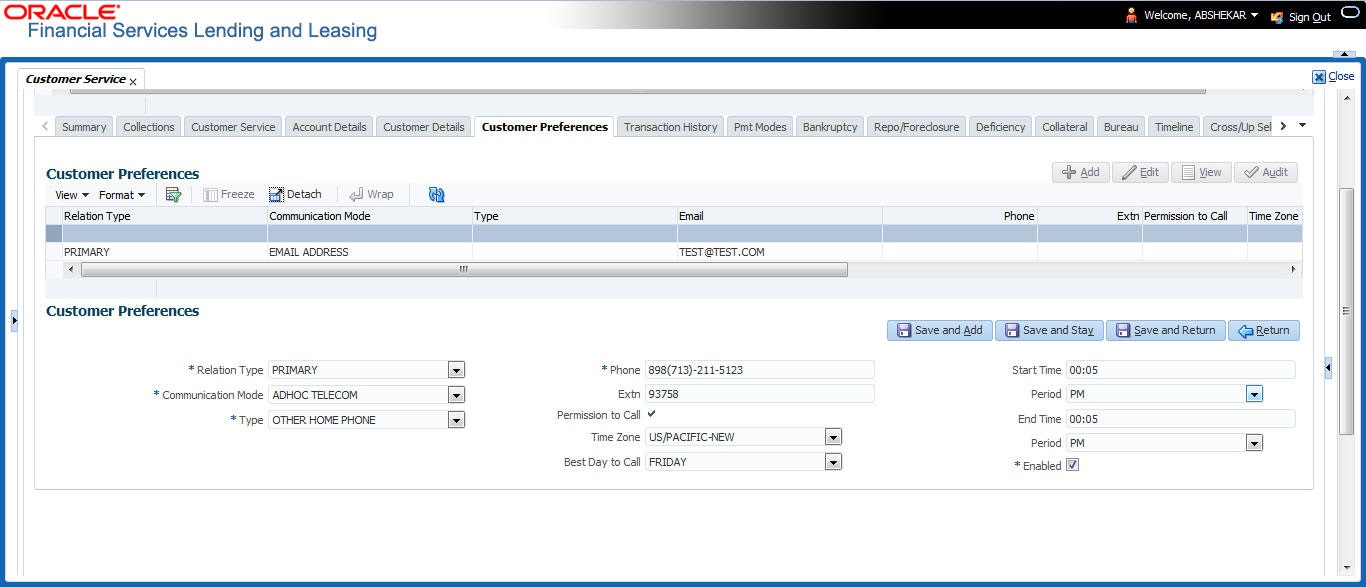
- In the Customer/Business Preferences section, click ‘ADD’. You can also perform any of the Basic Operations mentioned in Navigation chapter. A brief description of the fields are given below:
In this field:
View this:
Relation Type
Select the account relation type from the drop-down list. The list displays only those relationship types which are attached to account and are enabled (excluding deceased customer relations).
Communication Mode
Select the preferred mode of communication as one of the following from the drop-down list.
EMAIL ADDRESS - if selected, system displays the email ID associated with the selected contact in view mode and allows you to enable/disable the customer preference record.
TELECOM - if selected, you can further select the type of communication option as Telecom type, Address or Employment for which the permission to call indicator is ‘Y’. On selection, the other details are auto-populated based on the details maintained in Customer Service > Telecom, Address and Employment tabs. You can also enable/disable the customer preference record.
ADHOC TELECOM - if selected, you can specify the following field information.
Type
Select the preferred type of communication option from the drop-down list. The list displays the options maintained in TELECOM_TYPE_CD lookup.
Phone
Specify the phone number of the selected contact.
Note: On saving the record, system updates the specified phone number into ‘Telecom’ tab by internally posting a non-monetary transaction ‘EMPLOYMENT ADDRESS MAINTENANCE’.
Extn
Specify the extension (if any) for the selected contact.
Permission to Call
This check box is selected by default and indicates that the customer has provided permission to contact through the specified phone number.
Time Zone
Select the contact’s time zone.
Best Day to Call
Select the preferred day of the week to contact the customer from the drop-down list.
Start Time
Specify the start duration after which the contact can be called.
Period
Specify the time period (AM/PM).
End Time
Specify the end duration before which the contact can be called.
Period
Specify the time period (AM/PM).
Enabled
Check this box to enable the customer preference record.
Note: You can always enable only one record of a particular communication mode and for a particular relation type at any given point.
- Perform any of the Basic Actions mentioned in Navigation chapter.
Note
Clicking ‘EDIT’ in the Customer/Business Preferences section allows you to only enable or disable the customer preference record.
4.10 Customer Service screen’s Transaction History tab
Open the Customer Service screen and load the account you want to work with. Click the Transaction History tab to view the sections under it.
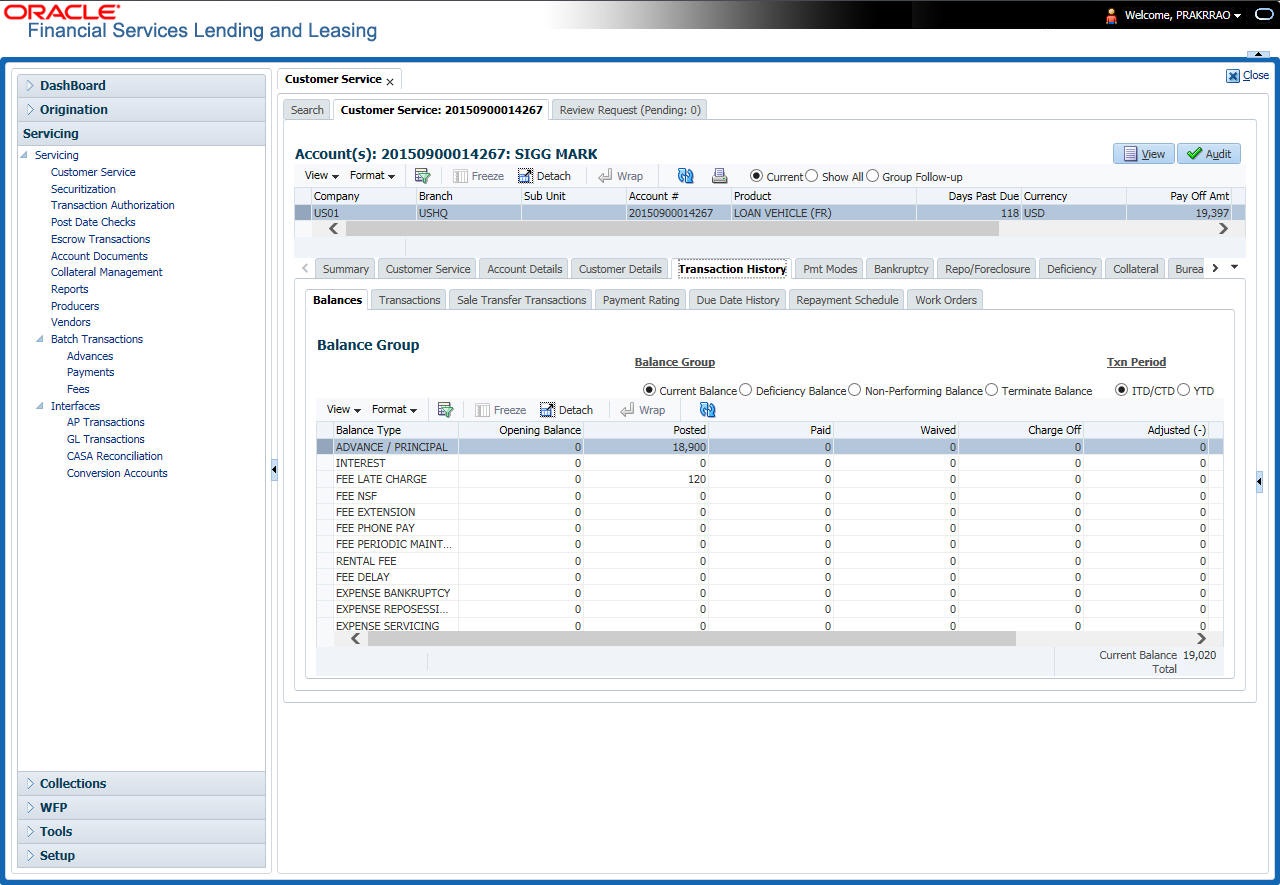
4.10.1 Balances sub tab
Details of an account balance can be viewed on the Balances sub tab.
The Balance Group in Balances section consists of the following four action buttons:
- Current Balance
- Deficiency Balance
- Non-Performing Balance
- Terminate Balance
By default, the Current Balance option is selected. In case the status of an account is ‘Charged Off’, then the system defaults to ‘Deficiency Balance’ option.
Depending on which one you select, a different set of balance information appears. In all cases, the Balance screen can be viewed in the following two transaction period modes:
- ITD/CTD (Inception-to-date/Cycle-to-date)
- YTD (year-to-date)
To view account balance information
- Open the Customer Service screen and load the account you want to work with.
- Click Transaction History tab, then click Balances sub tab
- In the Balance Group section, select the balance you want to view.
Current Balance displays the current balances for accounts with an status of ACTIVE.
In this field: |
View: |
Balance Type |
The balance type. |
Opening Balance |
The opening balance amount. |
Posted |
The amount posted (in addition to the opening balance). |
Paid Balance |
The amount paid. |
Waived |
The amount waived. |
Charged Off |
The amount charged off. |
Adjusted (-) |
The amount adjusted (negative adjustments). |
Adjusted (+) |
The amount adjusted (positive adjustments). |
Capitalized (-) |
The capitalization amount deducted from specific balance. |
Capitalized (+) |
The capitalization amount added to principal balance. |
Balance |
The current (closing) balance. The total active balance of the account is displayed at the bottom. |
Deficiency Balance displays the current balances for accounts with an status of charged off. If you click Deficiency Balance, the following information appears:
In this field: |
View: |
Balance Type |
The balance type. |
Opening Deficiency |
The opening deficiency balance. |
Chg off Posted |
The additional charged off amounts posted. |
Recovery |
The amount of deficiency balance paid. |
Deficiency Balance |
The current (closing) deficiency balance. The total deficiency balance of the account is displayed at the bottom. |
Non-Performing Balance displays the current balance for accounts with status as non-performing. Non-Performing accounts fall between Charged Off accounts and Active accounts. These accounts are treated as active when dealing with the customer, but for accounting purposes are treated differently as they are expected to charge off in the future. Fee and interest balances are not expected to be collected in full and therefore are not recognized as income. If you click Non-Performing Balance, the following information appears:
In this field: |
View: |
Balance Type |
The balance type. |
Opening Non-Performing |
The opening non performing balance. |
Paid / Terminate |
The amount of non performing balance paid or terminated. |
Paid Excess |
The additional non performing amounts posted. |
Waived |
The amount waived. |
Adjusted (-) |
The amount adjusted (Negative adjustments). |
Adjusted (+) |
The amount adjusted (Positive adjustments). |
Balance |
The current (Closing) non performing balance. The total non-performing balance of the account is displayed at the bottom. |
Terminate Balance displays the current balance for accounts with a status of TERMINATE. Selecting Terminate Balance option displays the following account details.
In this field: |
View: |
Balance Type |
The balance type. |
Opening Balance |
The opening non performing balance. |
Posted |
The balance amount posted on the account. |
Paid |
The amount of non performing balance paid. |
Waived |
The amount waived. |
Charge Off |
The additional charged off amounts. |
Adjusted (-) |
The amount adjusted (Negative adjustments). |
Adjusted (+) |
The amount adjusted (Positive adjustments). |
Capitalized (-) |
The capitalization amount deducted from specific balance. |
Capitalized (+) |
The capitalization amount added to principal balance. |
Balance |
The current (closing) balance. The total active balance of the account is displayed at the bottom. |
- In the Txn Period Balance section, select how you want to view the balance:
Select ITD/CTD to view transactions by Inception-to-date /Cycle-to-date:
-or-
Select YTD to view the transactions by year to date.
4.10.2 Transactions sub tab
The Transactions screen displays all transactions that have occurred over the life of account. Transactions can be sorted by when the transaction was created (Post Dt) or the effective date of transaction (Txn Dt). You can choose to view all transactions, filter System / User posted transactions, export account transaction details to a file, or reverse certain transactions. This information comes from the payments and advances applied to the account, maintenance tasks, and nightly processes such as billing.
To view the transaction history of an account
- Open the Customer Service screen and load the account you want to work with.
- Click Transaction History tab, then click Transactions sub tab.

- In the View Options section, select type of transactions in this account’s history you want to view on the Transactions screen.
If you select this:
The system displays:
Good Payments
All valid payments that was neither voided nor reversed.
All Payments
All transaction involving payments.
Good Fees
All valid fees that was neither voided nor reversed.
All Fees
All transaction involving fees.
Good Txns
All transactions that was neither voided nor reversed.
All Txns
All transactions.
- In the View section, you can further filter the list of transactions which are posted by System or User. Selecting ALL transactions displays all the transactions.
If you select this:
The system displays:
System
All system posted transactions filtered based on View option selection are displayed.
User
All User posted transactions filtered based on View option selection are displayed.
All Txns
All posted transactions filtered based on View option selection are displayed.
- In the Sort Option section, choose Post Dt to sort entries on in Transactions section in order of when the transaction was made effective.
-or-
- Select Txn Dt to sort the entries on in Transactions section in order of when the transaction was created.
- In View Option section, click View to view the following information:
In this field:
View:
Transactions section
Post Dt
The transaction posting date.
Txn Dt
The transaction effective date.
Description
The transaction details.
Currency
The currency of the transaction.
Amount
The transaction amount.
Details
The transaction details.
Balance Amt
The balance amount. This is the principal balance, not the total balance amount.
Payment Currency
The payment currency.
Payment Amount
The payment amount.
Payment Type
The payment type.
Reference
The reference number associated with the transaction.
Mode
The mode of the transaction.
Reason
The reason for the transaction.
Posted By
Indicates if the transaction is either system posted (marked as INTERNAL) or user posted (marked with User ID)
Allocation Details
Txn
The transaction allocation details.
Amt
The transaction allocation amount.
4.10.2.1 To Reverse (or Void) a Transaction
- Open the Customer Service screen and load the account you want to work with.
- On the Customer Service screen, click Transaction History tab and then click Transactions.
- In the Transactions section, select the transaction you want to reverse.
- Click Reverse. A confirmation dialog is displayed.
- Click ‘Yes’ to reverse the transaction. On confirmation, the reversal is posted for processing.
Some transactions cannot be reversed. If a transaction cannot be reversed, the Reverse button will be dimmed when transaction is selected. If the Reverse button is unavailable, the transaction anniversary cannot be reversed.
Access to the Reverse button can be restricted by user responsibility and account’s product type using the PAYMENT_REV transaction code (Super Group: ACCOUNT MONETARY TXN) on the Administration screen.
(For more information, see Txn Codes tab (Transaction Super Group screen) section of the Administration (System) Setup chapter in the Oracle Financial Services Lending and Leasing Setup Guide).
4.10.2.2 Voiding an Account
To void an account
Oracle Financial Services Lending and Leasing can be configured to void an account using the Reverse button on the Transaction screen.
- Open the Customer Service screen and load the account you want to work with.
- On the Customer Service screen, click Transaction History tab and then click Transactions.
- In the Transactions section, select Active entry in the Description field.
- Click Reverse.
On the Transactions screen, Oracle Financial Services Lending and Leasing creates an entry of Reverse Active and reverses all transactions. The system also changes status of the account to Closed: Void and changes status of the application to approved-void (or whatever the account’s last status was before funding).
To use this feature, active _rev transaction code must be enabled and set to manual on the Transaction Super Group screen for your user responsibility and account’s product type. (For more information, see the Txn Codes tab (Transaction Super Group screen) section of the Administration (System) Setup chapter in the Oracle Financial Services Lending and Leasing Setup Guide).
In case of migrated accounts maintained in the system, OFSLL has a dummy ACTIVE transaction created by the automated batch job process. Reversing this transaction posts RECESSION / VOID transaction and updates all balances to zero. Any Good Transactions posted after the ACTIVE transaction are reversed as part of RESCISSION / VOID process.
However, this behaviour of creating a dummy ACTIVE transaction is controlled based on system parameter AUTO_GEN_ACTIVE_TXN_CONV (AUTO GENERATE ACTIVE TRANSACTION FOR CONVERSION PROCESS). If the parameter is enabled, the scheduled batch job process creates a dummy ACTIVE transaction record with the transaction date as conversion date. Also both the indicators - TXN_PRIMARY_IND and TXN_BACKDATE_ALLOWED_IND are set to ‘Y’ facilitating for RESCISSION /VOID posting on the migrated account. If the parameter is not enabled, RECESSION / VOID is not allowed on migrated accounts since there is no active transaction.
4.10.2.3 Export Account Transaction Details
In the Transactions sub tab, you can export the required account transactions and allocation details to a file.
To export account transaction details
- Open the Customer Service screen and load the account you want to work with.
- On the Customer Service screen, click Transaction History tab and then click Transactions.
- In the Transactions section, select the required transaction.
- Click Export to Excel. The details are exported to a .xls file with options to save or open.
4.10.3 Sale Transfer Transactions
When an existing Sub Unit (referred to as the entity which is the source of funds for the credit application/Account) is transferred to a new Sub Unit, the balance in accounts are moved to the new Sub Unit by posting contra or reverse transactions and the same is re-posted to GL.
The sale transfer transaction sub tab displays all Sub Unit Transfer transactions from Old Sub Unit to New Sub Unit.
To view the Sale Transfer Transaction
- Open the Customer Service screen and load the account you want to work with.
- Click Transaction History tab, then click Sale Transfer Transactions sub tab.
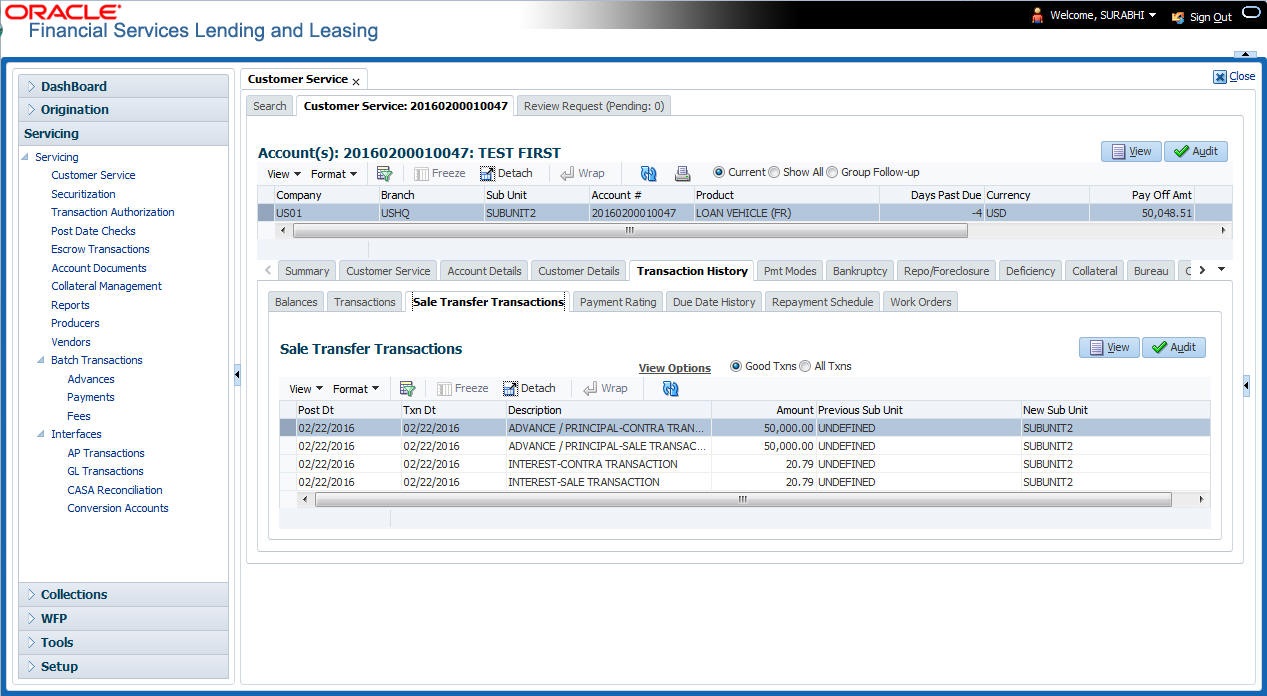
View the following information:
In this field: |
View: |
Post Dt |
View the transaction post date. |
Txn Dt |
View the transaction date. |
Description |
View the description of the posted transaction. |
Amount |
View the balance amount in previous sub unit. |
Previous Sub Unit |
View the name of previous sub unit. |
New Sub Unit |
View the name of the new sub unit. |
- You can view the following type of sub unit transfer transactions:
- Select Good Txns - System displays the Sub Unit Transfer transactions from Old Sub Unit to New Sub Unit which includes Contra Transactions.
- Select All Txns - System displays the Sub Unit Transfer transactions from Old Sub Unit to New Sub Unit which includes Contra Transactions and Reverse Transactions.
4.10.4 Payment Rating sub tab
To view the transaction history of an account
- Open the Customer Service screen and load the account you want to work with.
- Click Transaction History tab, then click Payment Rating sub tab.
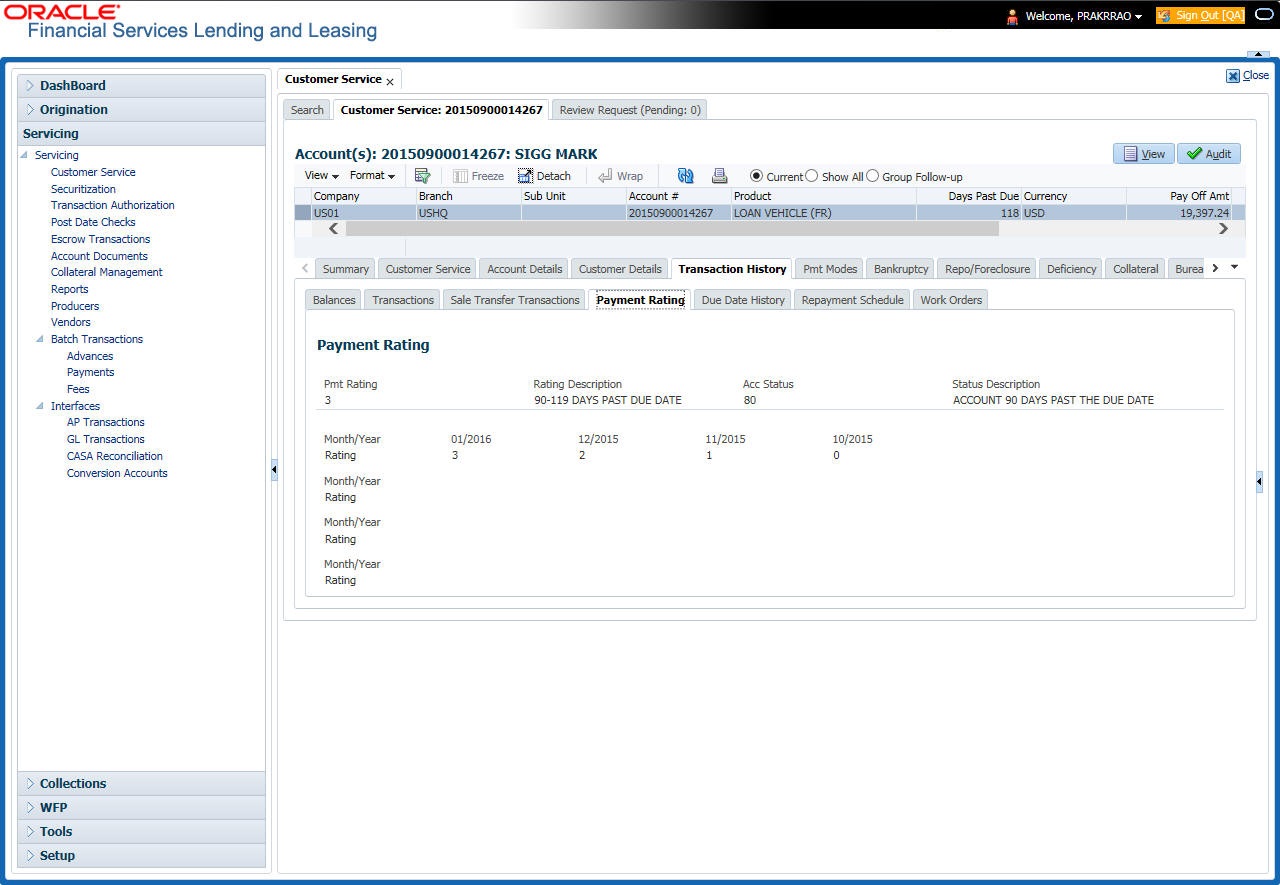
The Payment Rating section displays month and year of payment and rating reported to credit bureaus through Metro 2 file for the past 24 months, including the following:
In this field: |
View this: |
Pmt Rating |
The payment rating. |
Rating Description |
The payment rating description. |
Acc Status |
The credit bureau account status. |
Status Description |
The credit bureau account status description. |
Month/Year Rating |
The month/year of payment rating. |
4.10.5 Due Date History sub tab
The Due Date History tab provides a delinquency history, by payment, by displaying a history of all due dates, along with when actual payment was made for that due date and the subsequent balance. If a payment was delinquent, Due Date History section displays the number of days the customer was delinquent against each due date.
Due Date History sub tab displays all the dues that have crossed the system date and also the history that is currently available in Transaction History > Due Date History sub tab.
- Open the Customer Service screen and load the account you want to work with.
- Click Transaction History tab, then click Due Date History sub tab.
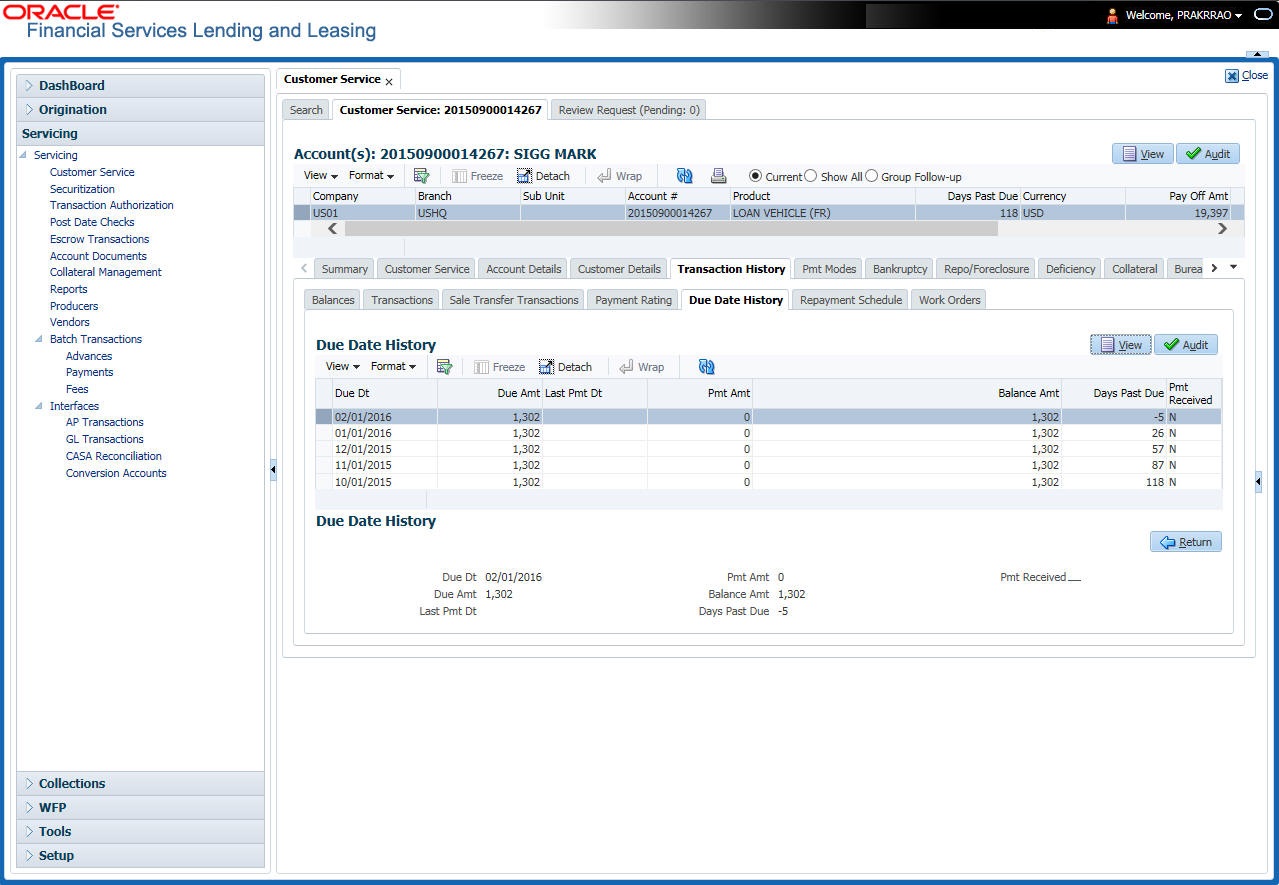
In Due Date History section, click View
View the following:
In this field: |
View this: |
Due Dt |
The due date. |
Due Amt |
The due amount. |
Last Pmt Dt |
The last payment date. |
Pmt Amt |
The payment amount. |
Balance Amt |
The balance amount. |
Days Past Due |
The days past due. |
Pmt Received |
If selected, indicates the payment was received. |
4.10.6 Repayment Schedule sub tab
The Repayment Schedule section contains information about schedule of repayment such as the date and payment amount.
- Open the Customer Service screen and load the account you want to work with.
- Click Transaction History tab, then click Repayment Schedule sub tab.

View the following information:
In this field: |
View this: |
Repayment Schedule section |
|
Seq |
The payment sequence number. |
Date |
The repayment date. |
# of Pmts |
The number of payments. |
Pmt Amt |
The payment amount. |
Generated |
If selected, indicates that the repayment schedule has been generated. |
Repayment Schedule Details section |
|
Date |
The repayment date. |
Payment Amt |
The payment amount. |
Principal Amt |
The amount paid to principal. |
Interest |
The amount paid to interest. |
Balance Principal |
The balance of the principal. |
4.10.7 Work Order sub tab
To expedite repossessions and foreclosures, the display only Vendor Work Order screen enables you to view all the work orders issued to different vendors for an account.
To view the vendor work order screen
- Open the Customer Service screen and load the account you want to work with.
- Click Transaction History tab, then click Work Order sub tab.

In the Vendor Work Order section, click View
View the following display only information:
In this field: |
View this: |
Work Order Type |
The assigned work order type. |
Dt |
The assignment date. |
Estimated |
The estimated dollar amount of work order. |
Vendor |
The vendor number and name. |
Status |
The assigned status. |
Total Amt |
The total estimated dollar amount of all work orders. |
You can create/view and maintain vendor work orders related to an account.
- To create and maintain vendor work orders, click Create Work Order. The system opens Vendor Management screen. You can perform tasks and record additional information, such as changing the work order’s status and adding comments in the Work Orders section.
If vendor screen is already opened in the main screen and user tries to create new work order or open an existing work order, system displays the warning message as “Vendor management screen is already open. Please close it and retry”.
- To view more detailed information about vendor work order, select the work order you want to view and click View Work Order. The View Work Order button appears faded if the responsibility does not allow access to the Vendor Work Order screen.
- Click Close on the Vendor Management screen to return to the Customer Service screen.
For more information about using the Vendor Management screen, please refer to the Vendor chapter in the User Guide.
4.11 Customer Service screen’s Pmt Modes tab
Open the Customer Service screen and load the account you want to work with. Click the Pmt Modes sub tab to view the sections under it.
4.11.1 ACH sub tab
If used, the ACH section displays information about automated clearing house and electronic fund transfers.
To view the ACH information screen
- Open the Customer Service screen and load the account you want to work with.
- Click Pmt Modes tab, then click ACH sub tab.
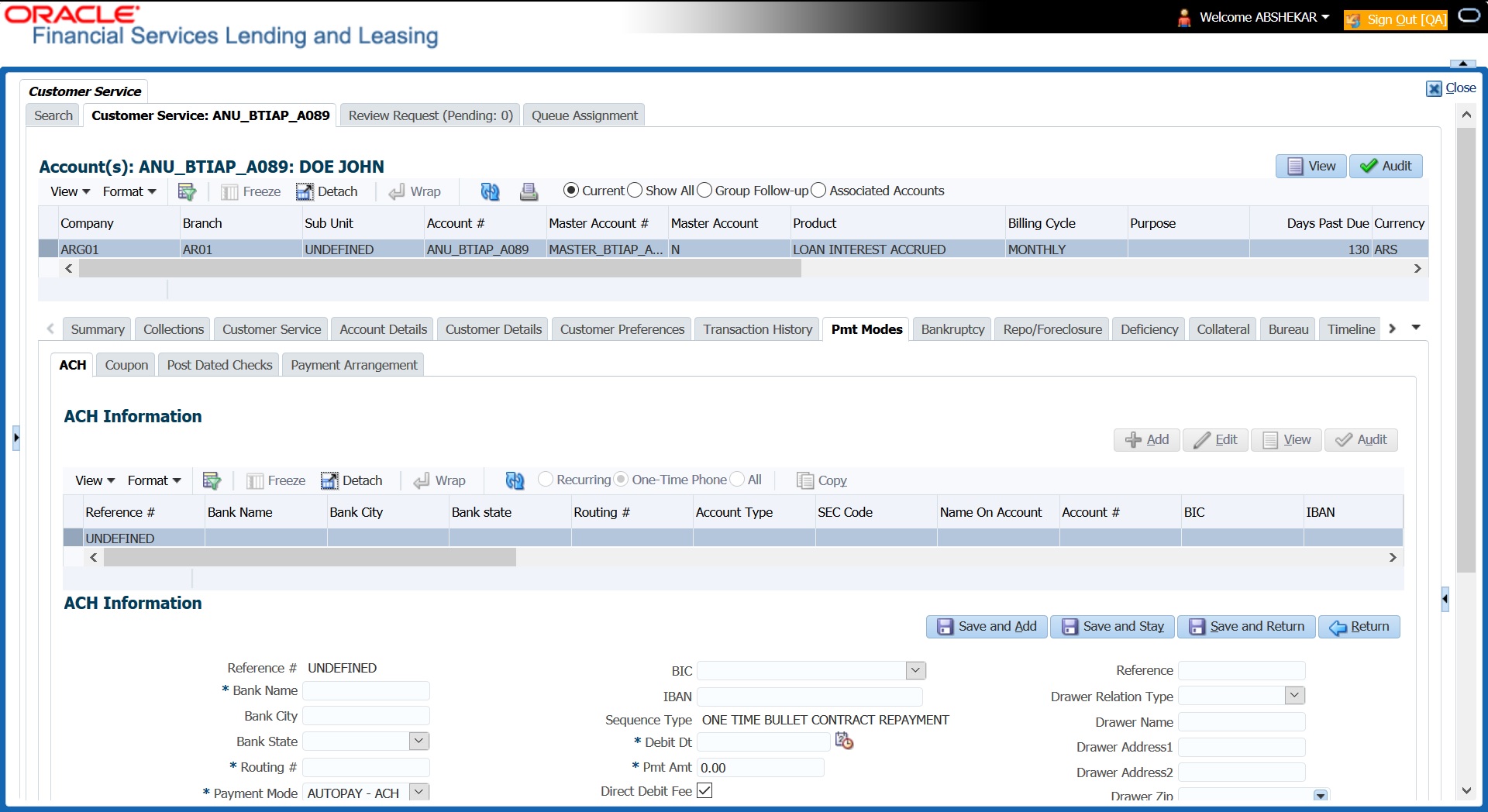
The system displays the ACH details depending on the following option selected:
- Recurring - Select ‘Recurring’ to display all the Recurring ACH details.
- One-Time Phone - Select this option to display one time ACH details.
- All - Select ‘All’ to display both recurring and one-time phone ACH details.
If you have selected ‘Recurring’ or ‘One-Time Phone’ option, you can further Add, Edit, or Copy the details and perform any of the Basic Operations mentioned in Navigation chapter. On save, the system will automatically post the transaction capturing the current transaction date along with a comment as 'Direct Record Update' for the particular ACH transactions.
If you have selected ‘Recurring’ option, the following fields are displayed:
In this field: |
View this: |
Reference # |
The unique reference number. |
Bank Name |
The bank name. |
Bank City |
Specify the city where the bank exist. |
Bank State |
Select the state where the bank exist form the drop-down list. |
Routing # |
The routing number. |
Payment Mode |
For an active Recurring ACH record, the payment mode selected in Contract tab is automatically populated. If not, select the type of repayment mode to indicate the type of ‘Autopay/Direct Debit’ using any of the following option from the drop-down list. The list is populated from REPAYMENT_PMT_MODE_CD lookup code. - AUTOPAY (ACH) - AUTOPAY (CREDIT CARD) - AUTOPAY (DEBIT CARD) For an AUTO PAY type of Payment Mode, ensure that at least one active ACH record exist and for CHECK type of Payment Mode, there are NO active ACH records. |
Account Type |
The type of account. |
Name On Account |
Specify the name of the account. |
Account # |
The account number. If the organizational parameter UIX_HIDE_RESTRICTED_DATA is set to Y, this appears as a masked number; for example, XXXXX1234. |
BIC |
Select the Business Identifier Code from the drop-down list. The list displays the BIC codes defined in the system. |
IBAN |
Specify the IBAN (International Bank Account Number). IBAN is used for identifying bank accounts across national borders with a minimal of risk of propagating transcription errors. Ensure that value entered satisfies the check-digit validation based on modulo 97. On save, system automatically validates the IBAN number length based on country code, characters, white spaces, and checksum. Validation is also done during posting non-monetary transaction (ACH Maintenance). You can maintain the IBAN length and other details required as per the country code in the user defined table (Setup > Administration > System > User Defined Tables). Note: IBAN for 'NL' country code (IBAN_FORMAT_NL) is defined by default with length of IBAN as 18. |
Sequence Type |
System displays the current Sequence Type of the selected account. Depending on the nature of direct debit, the sequence type can be one of the following: - First - First time direct debit - Recurrent - Subsequent repayments after first direct debit - Final - Final repayment - One-off - One time bullet contract repayment However, during the life cycle of the payment processing, the direct debit sequence type for an account can change. |
Pmt Day |
The payment day. |
Pmt Amt |
The Payment amount. |
Pmt Amt Excess |
The excess payment. |
Pmt Freq |
The payment frequency. |
Fee Amt |
The amount charged as fees. |
Direct Debit Fee |
If selected indicates that the fees is debited directly. |
Start Dt |
The date the system began using ACH payments for this account |
End Dt |
The ACH end date. |
Default |
If selected indicates that this ACH is the default ACH for the account. |
Status |
The status of the account. |
Note
This information can be edited using the Maintenance screen and the non monetary transaction ACH MAINTENANCE.
If you have selected ‘One-Time Phone’ or ‘All’ option, the following fields are displayed:
In this field: |
View this: |
Reference # |
The unique reference number. |
Bank Name |
The bank name. |
Bank City |
The bank city. |
Bank State |
List of available states. |
Routing # |
The routing number. |
Payment Mode |
For an active ‘One-Time Phone’ or ‘All’ ACH record, the payment mode selected in Contract tab is automatically populated. If not, select the type of repayment mode to indicate the type of ‘Autopay/Direct Debit’ using any of the following option from the drop-down list. The list is populated from REPAYMENT_PMT_MODE_CD lookup code. - AUTOPAY (ACH) - AUTOPAY (CREDIT CARD) - AUTOPAY (DEBIT CARD) For an AUTO PAY type of Payment Mode, ensure that at least one active ACH record exist and for CHECK type of Payment Mode, there are NO active ACH records. |
Account Type |
The type of account. |
Name On Account |
The account name. |
Account # |
The account number. If the organizational parameter UIX_HIDE_RESTRICTED_DATA is set to Y, this appears as a masked number; for example, XXXXX1234. |
BIC |
Select the Business Identifier Code from the drop-down list. The list displays the BIC codes defined in the system. |
IBAN |
Specify the IBAN (International Bank Account Number). IBAN is used for identifying bank accounts across national borders with a minimal of risk of propagating transcription errors. Ensure that value entered satisfies the check-digit validation based on modulo 97. On save, system automatically validates the IBAN number length based on country code, characters, white spaces, and checksum. Validation is also done during posting non-monetary transaction (ACH Maintenance). You can maintain the IBAN length and other details required as per the country code in the user defined table (Setup > Administration > System > User Defined Tables). Note: IBAN for 'NL' country code (IBAN_FORMAT_NL) is defined by default with length of IBAN as 18. |
Sequence Type |
System displays the current Sequence Type of the selected account. - First - First time direct debit - Recurrent - Subsequent repayments after first direct debit - Final - Final repayment - One-off - One time bullet contract repayment However, during the life cycle of the payment processing, the direct debit sequence type for an account can change. |
Debit Dt |
The debit date. |
Pmt Amt |
The Payment amount. |
Direct Debit Fee |
If selected indicates that the fees is debited directly. |
Secret Question |
Select the secret question from the drop down list. |
Provided To Whom |
The person to whom the ACH is concerned. |
Reference |
Additional reference if any. |
Drawer Relation Type |
The withdrawer relation to ACH. |
Drawer Name |
The name of withdrawer. |
Drawer Address1 |
Address of withdrawer, |
Drawer Address2 |
Address of withdrawer, |
Drawer City |
City of withdrawer, |
Drawer State |
State of withdrawer, |
Drawer Zip |
Zip of withdrawer, |
Status |
The status of the account. |
Note
This information can be edited using the Maintenance screen and the non monetary transaction ACH MAINTENANCE.
Copying ACH Details
You can copy and maintain ACH details from Pmt Modes sub tab of Customer Service screen. Copy option is available only when you have selected the ACH option as either Recurring or One-Time Phone.
To copy the ACH details
- Select a record and click Copy.
- A confirmation message is displayed as ‘Do you want to Copy ACH Record?’. Click OK to copy and create a new record.
On confirmation, the system creates a new row with new reference number, Status as ‘Active’, Default as ‘N’, Start Dt as ‘System Dt + Pre note days’ and all the other details as maintained in the copied record. When a new record is created using the Copy function, the system will post a ‘New ACH Transaction’ capturing the current transaction date along with a comment as 'Direct Record Update'.
4.11.2 Coupon sub tab
The Coupon section displays information regarding coupons associated with the account.
To view the coupon screen
- Open the Customer Service screen and load the account you want to work with.
- Click Pmt Modes tab, then click Coupon sub tab.
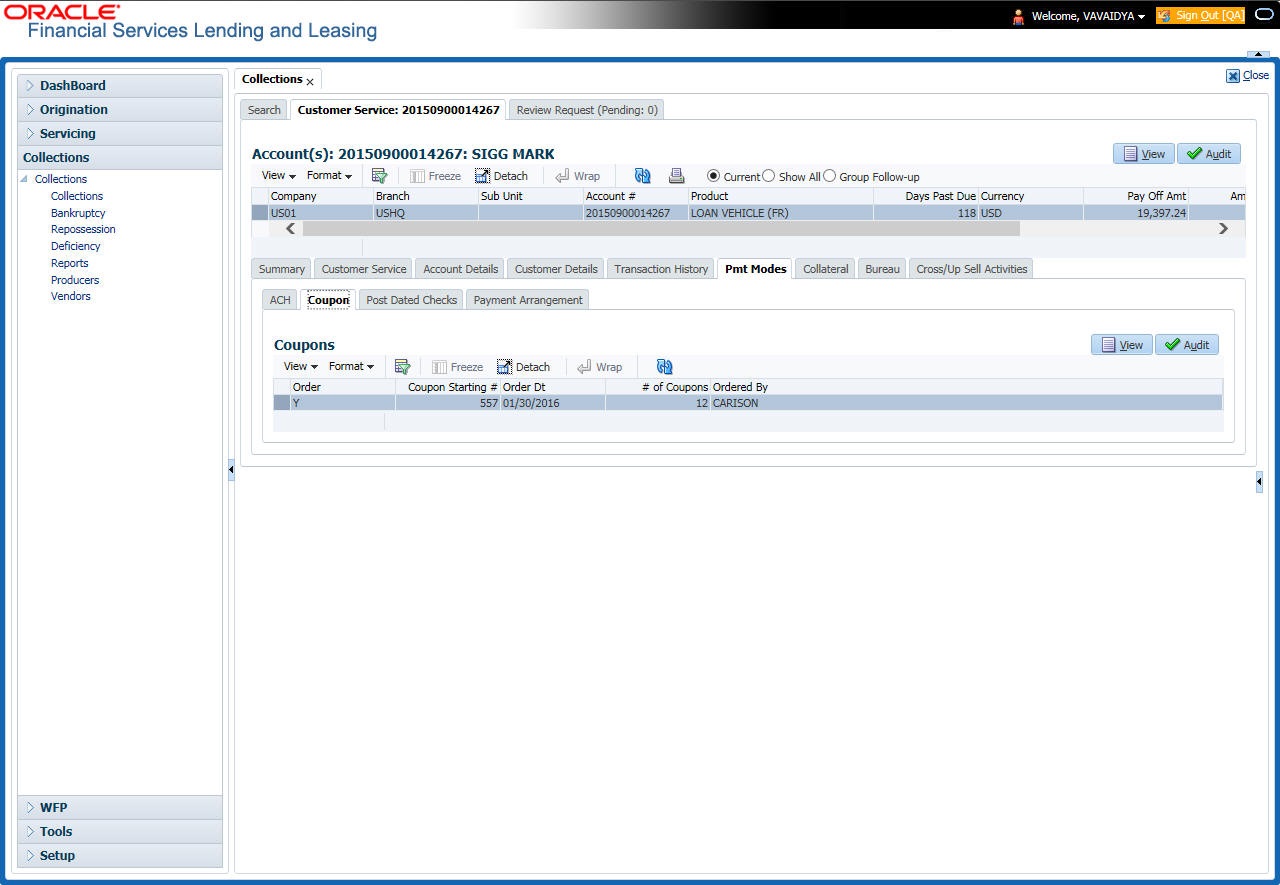
View the following:
In this field: |
View this: |
Order |
If the coupons are ordered for the selected account. |
Coupon Starting # |
The starting number of coupon ordered for the customer. |
Order Date |
The order date of the coupon. |
# of Coupons |
The total number of coupons ordered for the customer. |
Ordered By |
The person who ordered the coupons |
4.11.3 Post Dated Checks sub tab
The Post Date Check section enables you to view any post dated check information for the account, if PDC is a method of repayment.
To view the post dated checks details screen
- Open the Customer Service screen and load the account you want to work with.
- Click Pmt Modes tab, then click Post Dated Checks sub tab.

View the following:
In this field: |
View this: |
PDC Type |
The type of post dated check in use. |
Status |
The status of the post dated check. |
Check # |
The check number of the post dated check. |
Check Dt |
The check date of the post dated check. |
Check Amt |
The check amount of the post dated check. |
Bank Name |
The bank name of the post dated check. |
Account Type |
The account type of the post dated check. |
Account # |
The account number of the post dated check. |
Comments |
Additional information as comments, if any. |
4.11.4 Payment Arrangement sub tab
The Payment Arrangement section enables you to define and calculate the payment amount for the account with status Charge-off. An alert message will be displayed in the Customer Service screen when the user tries to view the payment arrangement for account other than charged off status.
To view the Payment Arrangement details screen
- Open the Customer Service screen and load the account you want to work with.
- Click Pmt Modes tab, then click Payment Arrangement sub tab.
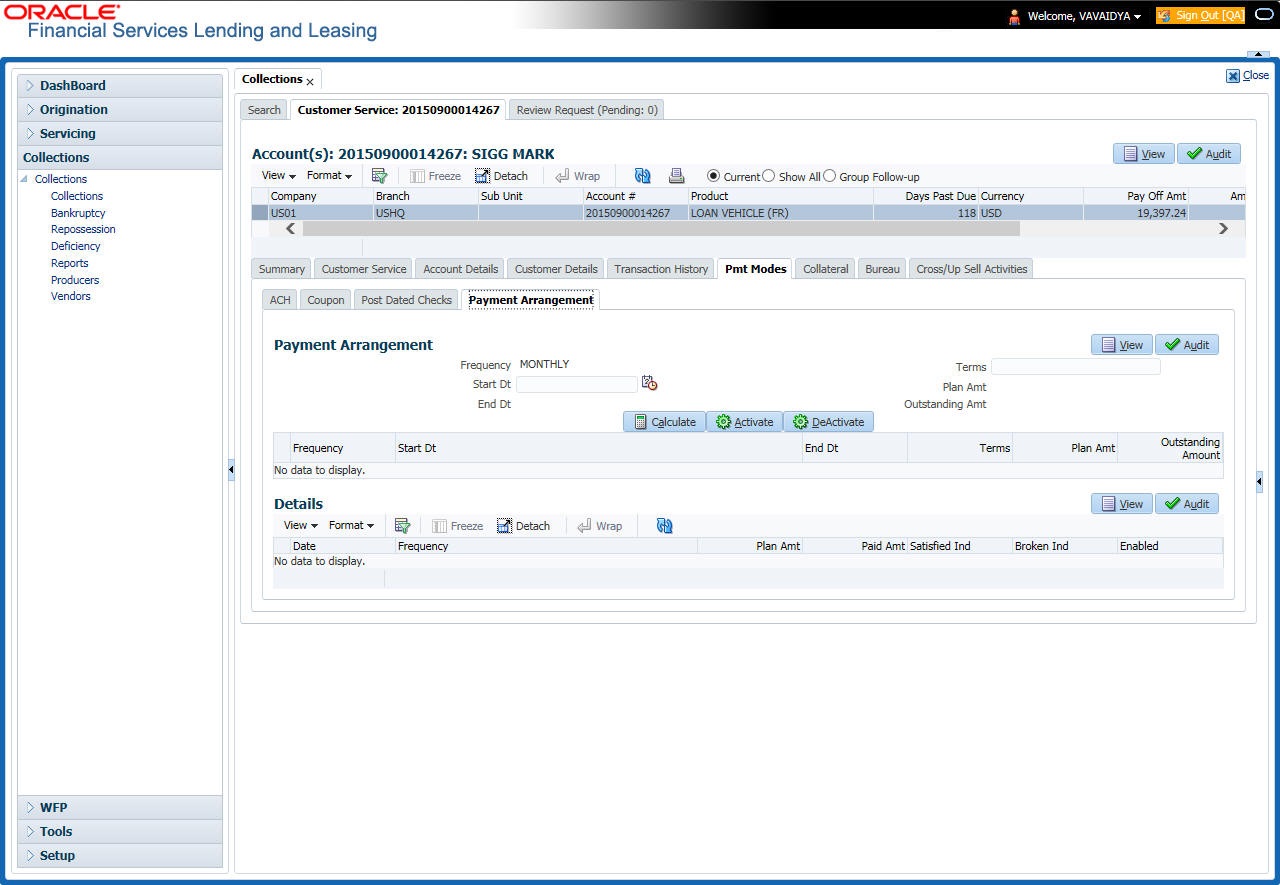
The Payment Arrangement section is enabled only when the Payment Arrangement Batch job is posted.
- In the Payment Arrangement section, click View to view the following details:
In this field:
Do this:
Frequency
Displays the payment frequency.
Start Date
Enter the start date from when the customer pays.
Terms
Enter the number of payments. Note that if the term is specified as zero “0”, an error message is displayed.
End Date
View the end date of the payment.
Plan Amount
View the payment amount which the customer plans to pay.
Outstanding Amount
View the outstanding amount.
- In the Details section, click View to view the following details:
In this field:
View this:
Date
View the start date of the payment plan.
Frequency
View the payment frequency.
Plan Amount
View the planned payment amount.
Paid Amount
View the paid amount.
Satisfied Ind
Indicates that the customer done the payment arrangements.
Broken Ind
Indicates that the customer did not make the payment arrangement.
Enabled Ind
Indicates that the arrangement is active
On Clicking Deactivate, the account will be deactivated.
To add a new payment rearrangement plan, previous plan has to be manually deactivated otherwise the system displays an error message. This condition applies to the payment arrangement previous plan even when the 'Broken Indicator' is selected.
Only one Payment arrangement plan can exist at a time. If a schedule broken by the customer make another payment arrangement, the first payment arrangement has to be deactivated and only then, the other payment can be added.
4.12 Customer Service screen’s Bankruptcy tab
The Bankruptcy screen enables you to record the details of a bankruptcy. This information usually is supplied from the customer/business or customer’s/business attorney. You can track each stage of the bankruptcy process based on its follow-up date and record information using the Details and Tracking sections.
As there are occasions when a borrower files bankruptcy more than once during tenure of the Loan, you can record information for multiple bankruptcies. The Add button enables you to create a new bankruptcy record with different start and end dates. You can also use the Bankruptcy screen to view previous bankruptcy record using Next and Previous buttons in Detail section. The Current box in Detail section indicates the current bankruptcy details.
When a Bankruptcy condition is opened on an account, the system defaults a detailed tracking record with ‘Current’ field enabled and ‘Follow up date’ defaulted to system date. The ‘Disposition’ is defaulted as ‘NEWLY RECEIVED’. The system only adds a new detail tracking record. No processing will be done with respect to detail tracking record when the bankruptcy condition is closed.
To enter bankruptcy details for an account
- Open the Customer Service screen and load the account you want to work with.
- Click Bankruptcy tab.
- In the Bankruptcy Details section, select the bankruptcy record you want to work with.
-or-
- Select Add to refresh the Bankruptcy screen to create a new record.
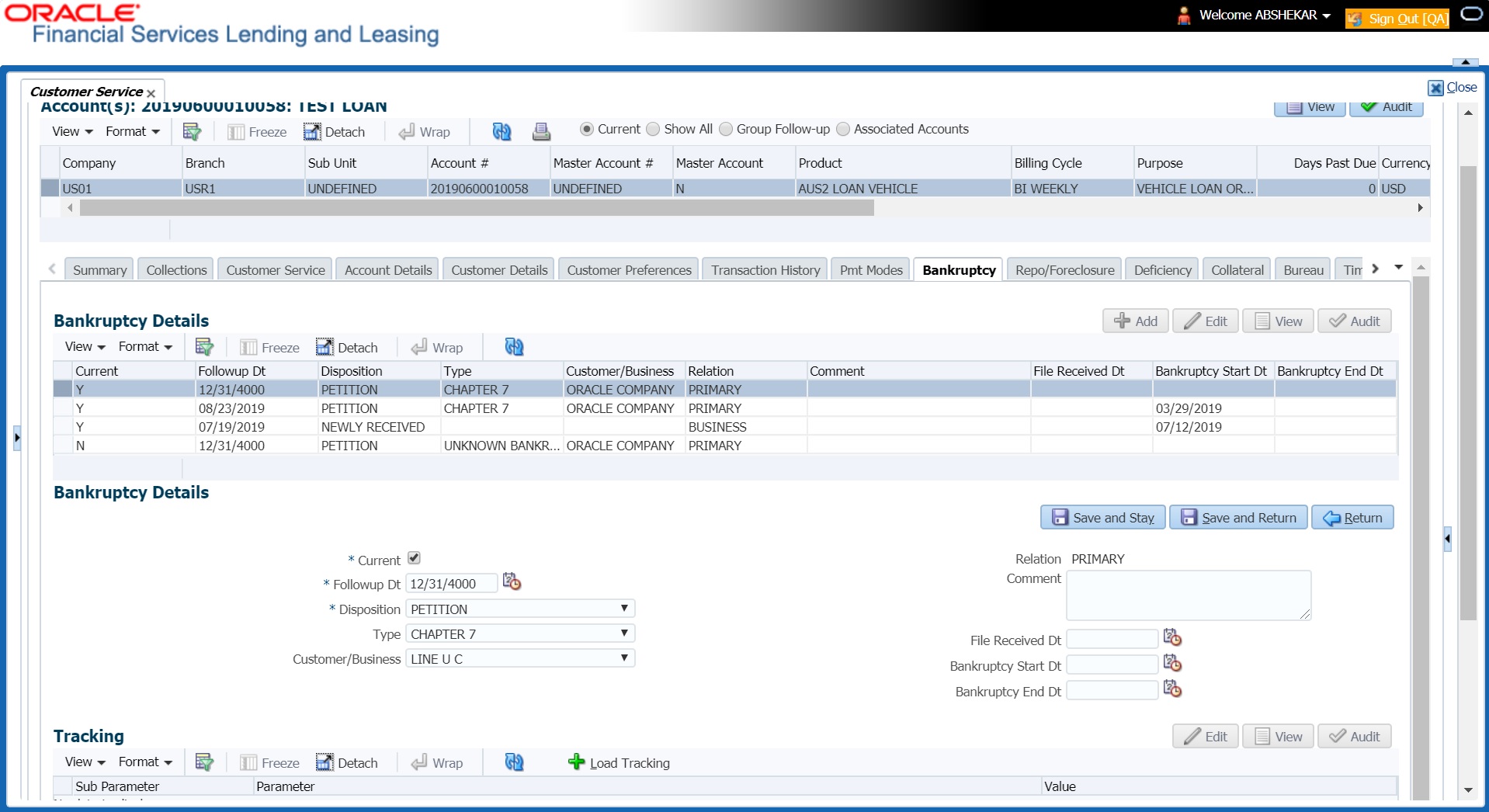
- In the Bankruptcy Details section, enter, view or edit the following information:
Field:
Do this:
Current
Select to indicate this is the current bankruptcy record.
If selected, system disables the current indicator for any previous record for the same relation.
Follow up Dt
Enter the follow-up date for the bankruptcy.
Disposition
Select the bankruptcy disposition.
Type
Select the bankruptcy type.
Customer/Business
Select the customer/business from the drop-down list
Relation
Based on Customer/Business selected, system displays either the type of customer relation or as business relation associated to account.
Comment
Enter a comment.
File Received Dt
Select the file received date for the bankruptcy.
Bankruptcy Start Dt
Select the bankruptcy start date.
Bankruptcy End Dt
Select the bankruptcy end date.
-
Field:
Do this:
Current
Select to indicate this is the current bankruptcy record.
Follow up Dt
Enter the follow-up date for the bankruptcy.
Disposition
Select the bankruptcy disposition.
Type
Select the bankruptcy type.
Customer
Select the customer from the drop-down list
Relation
The system displays relation of the customer
Comment
Enter a comment.
File Received Dt
Select the file received date for the bankruptcy.
Bankruptcy Start Dt
Select the bankruptcy start date.
Bankruptcy End Dt
Select the bankruptcy end date.
- Click Save.
- In the Tracking section, click Load Tracking. The system loads the bankruptcy tracking parameters.
- If you want to reduce the list of parameters, select a sub attribute in the Sub Attribute field. If your system has been configured to use the Sub Attribute field, only attributes in a particular group appear in parameter display.
- Complete the Create Tracking section by entering information regarding bankruptcy in the Value field for each corresponding Parameter, click Save on the Bankruptcy screen.
4.12.1 Call Activities sub tab
Call activity section includes calls from customer, calls you make regarding the account or changes to the condition of the account. Entries in the Call Activities section are listed in reverse chronological order of follow-up date.
For details on how to Record a Call Activity, refer Call Activities sub tab section in “Customer Service screen’s Customer Service tab” section.
4.12.2 Comments sub tab
Oracle Financial Services Lending and Leasing enables you to record comments on the Customer Service screen using Comments tab. These comments also appear under the Comments sub tab.
For details on how to Record a Comment, refer Comments sub tab section in “Customer Service screen’s Customer Service tab” section.
4.12.3 Due Date History sub tab
The Due Date History tab section provides a delinquency history, by payment, by displaying a history of all due dates, along with when actual payment was made for that due date and the subsequent balance. If a payment was delinquent, Due Date History section displays the number of days the customer was delinquent against each due date.
For more details, refer Due Date History sub tab section in “Customer Service screen’s Transaction History tab” section.
4.13 Customer Service screen’s Repo/Foreclosure tab
The Repossession/Foreclosure screen enables you to record information regarding repossessions/foreclosure in a manner similar to how bankruptcies are recorded on the Bankruptcy screen. You can track each stage of repossession/foreclosure process based on the follow-up date and record information using the Details and Tracking section.
4.13.1 Repossession sub tab
On occasion, a lender performs multiple repossessions for the same Loan. The Create New Repossession button on the Repossession screen enables you to create a new repossession record for a different collateral and different start and end dates. You can also use the Repossession screen to view previous repossession information using the Next and Previous buttons in the Details section. The Current box in Details section indicates the current repossession record for each asset.
This tab will be available only when the collateral type associated with the Loan account is a Vehicle.
You can update the current record, but previous records cannot be modified.
When the REPO call activity is posted, system defaults the primary collateral details and current status will be checked.
When a Repossession condition is opened on an account, the system defaults a detailed tracking record with ‘Current’ field enabled and ‘Follow up date’ defaulted to system date. The ‘Disposition’ is defaulted as ‘NEWLY RECEIVED’. The system only adds a new detail tracking record. No processing will be done with respect to the detail tracking record when the repossession condition is closed.
To Specify repossession details for an account
- Open the Customer Service screen and load the account you want to work with.
- Click the Repo/Foreclosure sub tab, then click Repossession.
- In the Repossession Details section, select the repossession record you want to work with.
-or-
- Click Add to refresh the Repossession screen to create a new record.

- In the Details section, add view or edit the following information:
In this field:
Do this:
Current
Select the check box to indicate if this is the current repossession record.
Followup Dt
Specify the follow-up date for the repossession from the adjoining calendar.
Type
Select the repossession type.
Collateral
Select the collateral involved in the repossession.
Disposition
Select the repossession disposition.
File Received Dt
Select the file received date for the repossession.
Repo Dt
Select the repossession start date.
Repo End Dt
Select the repossession end date.
Comment
Specify a comment.
Case Repo Details - This section displays the following details based on the case response received from the interfaced third party system.
Case#
Displays the case number of the repossession.
National Forwarder
If checked, indicates that National Forwarder carrier is equipped in the repossession.
Condition Report Status
If checked, indicates that the condition report exist.
Condition Report Recd Dt
Displays the date when condition report was received.
Mileage
Displays the mileage of the vehicle.
Key Status
Indicates if the vehicle key(s) is available.
Field Agent Name
Displays the name of the field agent involved in the repossession.
Address
Displays the address of the field agent.
Phone
Displays the contact number of the field agent.
Storage Location
Displays the location where the vehicle is currently stored.
Repo Location
Displays the repossession location.
Police Dept Name
Displays the name of police department involved in repossession.
- In the Tracking section, click Load Tracking. The system loads the repossession tracking parameters.
- If you want to reduce the list of parameters, select a sub attribute in the Sub Attribute box.
If your system has been configured to use the Sub Attribute field, only attributes in a particular group appear in the parameter display. - Complete the Tracking section by entering information regarding repossession in the Value field for each corresponding Parameter, then click Save.
4.13.2 Foreclosure sub tab
The Foreclosure screen enables you to record information regarding foreclosure in a manner similar to how bankruptcies are recorded on the Bankruptcy screen. You can track each stage of the repossession process based on follow-up date and record information using Details and Tracking section.
A lender can perform multiple foreclosures for the same Loan. The Create New Foreclosure button on the Foreclosure screen enable you to create a new foreclosure record for a different collateral and different start and end dates. You can also use the Foreclosure screens to view the previous foreclosure information using Previous and Next buttons in Details section. The Current box in Details section indicates the current foreclosure record for each asset.
This tab will be available only when the Collateral type associated with the Loan account is home.
You can update the current record, but previous records cannot be modified.
To enter foreclosure details for an account
- Open the Customer Service screen and load the account you want to work with.
- Click the Repo/Foreclosure sub tab, then click Foreclosure.
- In the Foreclosure Details section, select the foreclosure record you want to work with.
-or-
- Click Add to refresh the Foreclosure screen to create a new record.
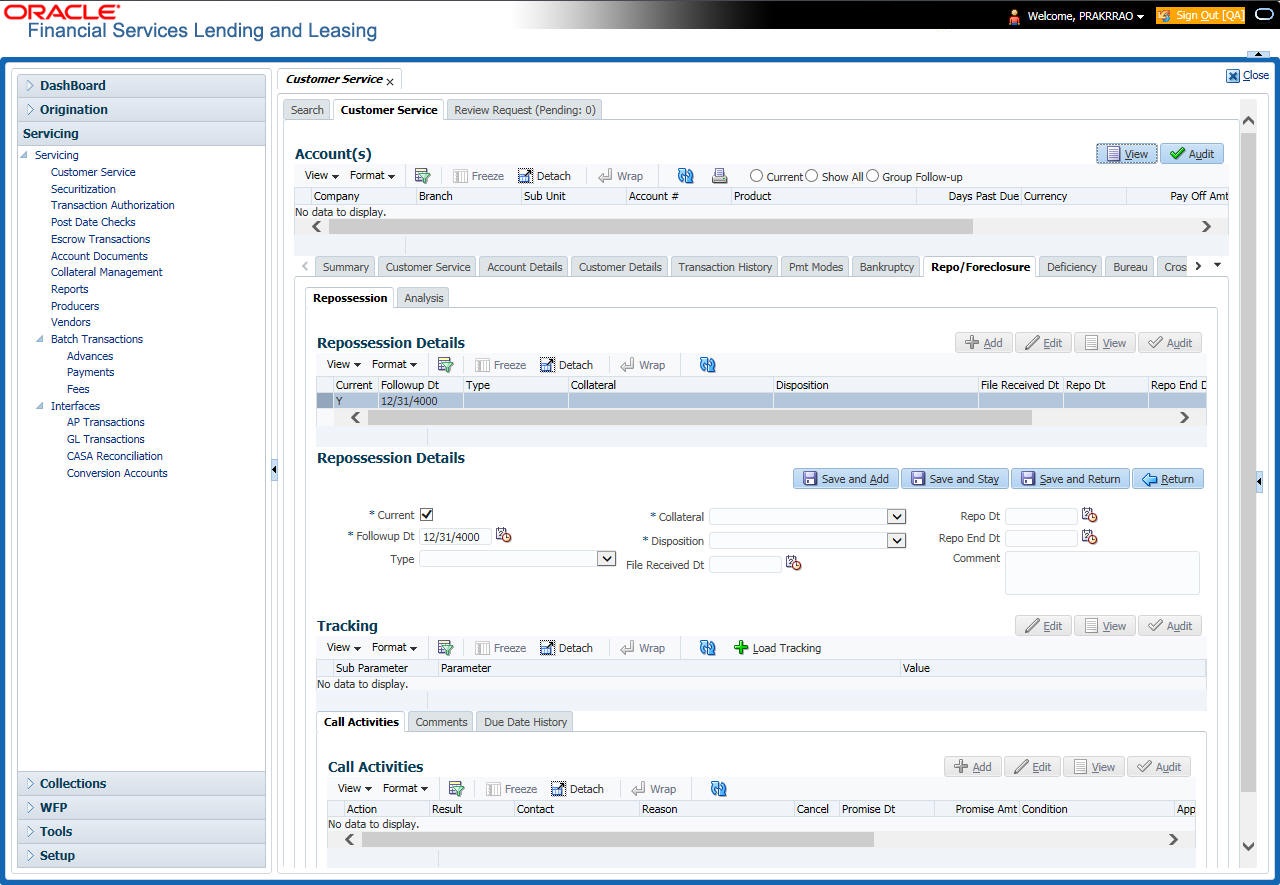
- In the Foreclosure Details section, enter view or edit the following information:
In this field:
Do this:
Current box
Select to indicate this is the current repossession/foreclosure record.
Followup Dt
Select the follow-up date for the repossession/foreclosure.
Disposition
Select the foreclosure disposition.
Type
Select the foreclosure type.
Collateral
Select the foreclosure asset.
File Received Dt
Enter the file received date for the foreclosure.
Foreclosure Start Dt
Enter the foreclosure start date.
Foreclosure End Dt
Enter the foreclosure end date.
Comment
Enter a comment.
- In the Tracking section, click Load Tracking. The system loads the foreclosure tracking parameters.
- If you want to reduce the list of parameters, select a sub attribute in the Sub Attribute box.
If your system has been configured to use the Sub Attribute field, only attributes in a particular group appear in the parameter display. - Complete the Tracking section by entering information regarding foreclosure in the Value field for each corresponding Parameter, then click Save.
4.13.3 Analysis sub tab
The Analysis screen enables you to create and analyze possible scenarios for re marketing and sale of the asset. This enables you to calculate the possible gain or loss in the sale of an asset. Expenses already incurred on the asset are displayed on Expenses sub screen. You can change the numbers if you expect more expenses by the time asset is sold. You can have up to three Repo/Foreclosure and three Sales analyzes on each Analysis screen.
To complete a repossession/foreclosure analysis or sales analysis for an account
- Open the Customer Service screen and load the account you want to work with.
- On the Customer Service screen, click Repo/Foreclosure tab and then click Analysis.
- In the Analysis section, select the analysis record you want to work with and click Load.
-or-
- Click Add to refresh the Foreclosure screen to create a new record.

- In the Analysis section, select the Current box if you wish to indicate that this is current analysis worksheet.
- In the Analysis section, use the Level field to select analysis level you want to use, account or asset.
- Select Account if you want analysis to use value of the entire account.
- or -
- Select Asset if you want analysis to use the value of a particular asset.
- In the Analysis section, enter, view, or edit the following information:
In this field:
Do this:
Current Ind
Current Indicator. Select the check box if analysis is current.
Level
Select the Analysis level from the drop down list.
Balance %
Specify balance allocation percentage.
Analysis Dt
View the analysis date.
Current Value
View the asset current total value.
Asset
If you want to perform an analysis for a particular asset, select the asset.
Comment
Specify comment associated with the analysis.
- Specify all the required information in Analysis or Bid section, depending on the type of incident you are analyzing.
- Complete the details in Expenses and Refunds sub screens, corresponding to analyze or bid number on the Analysis screen. The data here is loaded to the analysis and bid columns as ‘expenses’ and ‘refunds’.
- To complete the Expenses sub screen:
In this field:
Do this:
Expense Type
Select the expense type.
Manual
Indicates that the expense was entered manually.
Analysis1 Amt
Specify the expense amount for analysis1.
Analysis2 Amt
Specify the expense amount for analysis2.
Analysis3 Amt
Specify the expense amount for analysis3.
Bid1 Amt
Specify the expense amount for bid1.
Bid2 Amt
Specify the expense amount for bid2.
Bid3 Amt
Specify the expense amount for bid3.
- To complete the Refunds sub screen:
In this field:
Do this:
Refund Type
Select the refund type.
Manual
Indicates that the refund was entered manually.
Analysis1 Amt
Specify the refund amount for analysis1.
Analysis2 Amt
Specify the refund amount for analysis2.
Analysis3 Amt
Specify the refund amount for analysis3.
Bid1 Amt
Specify the refund amount for bid1.
Bid2 Amt
Specify the refund amount for bid2.
Bid3 Amt
Specify the refund amount for bid3.
- Select the Corresponding Analysis/Bid to Load details Maintained in the Expense and Refund sections.
- Repeat steps 4 to 8 with information regarding other repossession/foreclosure or sales analysis.
- In Status field, select status of the analysis: Approved or Rejected.
- When you have decided which analysis or which sale bid you want to approve, select your choice in either the Final Analysis or Final Bid section.
Note
You can approve only one analysis. Based on Analysis approved on ‘Save And Return’ Corresponding Radio button will be enabled in the Final section of Analysis details.
- Click Save.
4.13.4 Remarketing sub tab
In the Remarketing sub tab you can trigger remarketing request and auto generate resale work orders. A collateral remarketing request is an instruction to the vendor of third party auctioning system to pick-up the repossessed asset from the storage location and proceed with auction.
In the Remarketing sub tab, you can do the following:
- Define Remarketing request
- View Remarketing Proceed Details
- Maintain Status History, Tracking Attributes, Expenses and Refunds.
For detailed information about the process of collateral remarkeing, refer to ‘Remarketing’ chapter in Collections User Guide.
4.13.5 Call Activities sub tab
Call activity section includes calls from customer, calls you make regarding the account or changes to the condition of the account. Entries in the Call Activities section are listed in reverse chronological order of follow-up date.
For details on how to Record a Call Activity, refer Call Activities sub tab section in “Customer Service screen’s Customer Service tab” section.
4.13.6 Comments sub tab
Oracle Financial Services Lending and Leasing enables you to record comments on the Customer Service screen using Comments tab. These comments also appear under the Comments sub tab.
For details on how to Record a Comment, refer Comments sub tab section in “Customer Service screen’s Customer Service tab” section.
4.13.7 Due Date History sub tab
The Due Date History tab section provides a delinquency history, by payment, by displaying a history of all due dates, along with when actual payment was made for that due date and the subsequent balance. If a payment was delinquent, Due Date History section displays the number of days the customer was delinquent against each due date.
For more details, refer Due Date History sub tab section in “Customer Service screen’s Transaction History tab” section.
4.14 Customer Service screen’s Deficiency tab
The Deficiency screen enables you to record information about deficiency accounts i.e. accounts that are no longer collectable. You can create and track specific details on status of the charged-off account for timely follow-up and analysis. You can also track each stage of the deficiency process based on its follow-up date and record information using the Details and Tracking sections.
The Add button enables you to create a new deficiency record with different start and end dates. You can also use the Deficiency Details screen to view deficiency information. The Current field in Deficiency Details section indicates the current bankruptcy details. To view the balance of a charged off account, click the Transaction History tab on Customer Service screen, then click Balances. On the Account Details screen’s Balance Group section, click Deficiency. For more information on Deficiency Balance, see Balances sub tab section in this chapter.
When a Deficiency condition is opened on an account, the system defaults a detailed tracking record with ‘Current’ field enabled and ‘Follow up date’ defaulted to system date. The ‘Disposition’ is defaulted as ‘NEWLY RECEIVED’. The system only adds a new detail tracking record. No processing will be done with respect to the detail tracking record when the deficiency condition is closed.
To enter deficiency details for an account
- Open the Customer Service screen and load the account you want to work with.
- Click Deficiency tab.
- In the Deficiency Detail section, select the deficiency record you want to work with
-or-
- Click Add to refresh the Deficiency screen to create a new record.
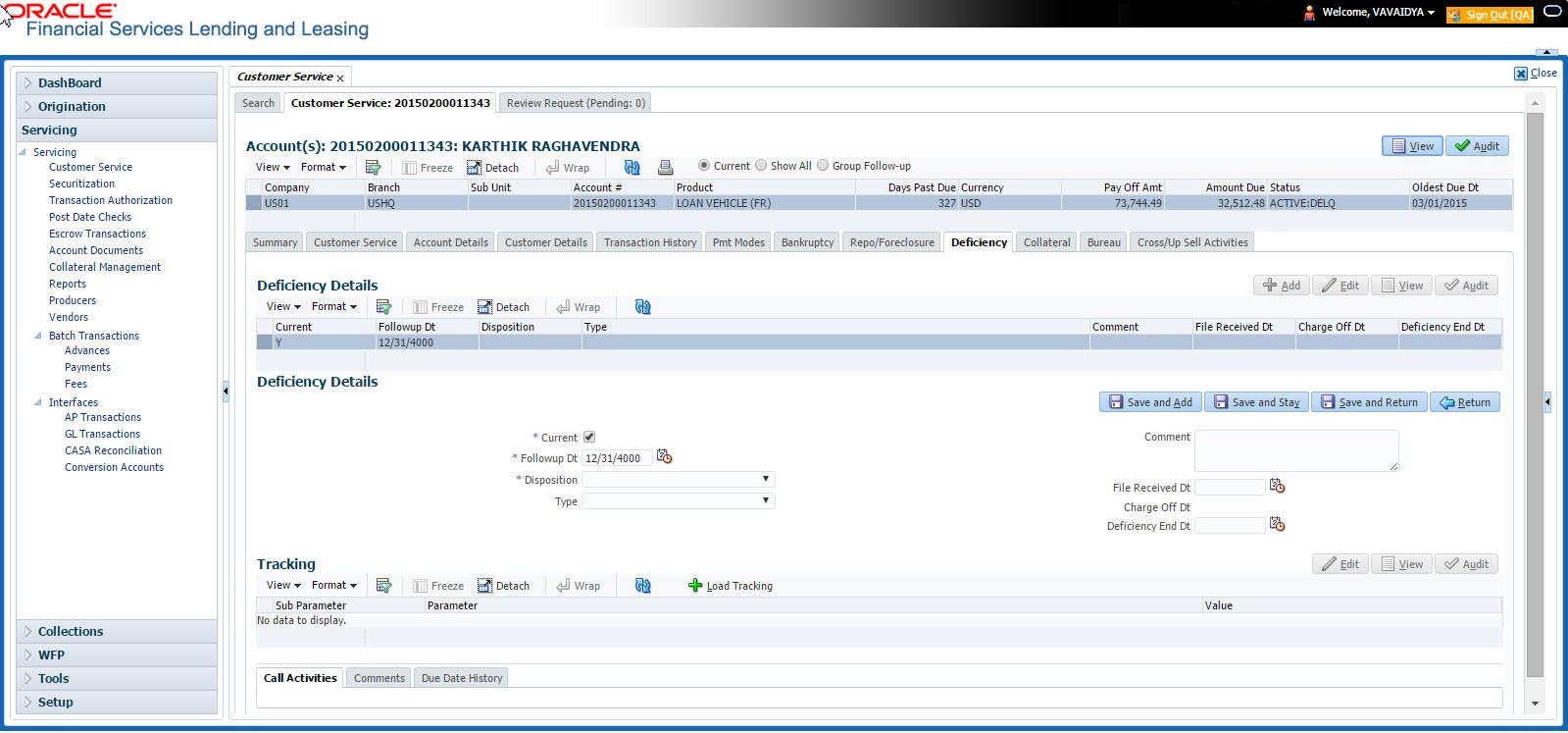
- In the Deficiency Detail section, enter, view, or edit the following information:
In this field:
Do this:
Current
Select to indicate this is the current deficiency record.
Followup Dt
Specify the follow-up date for the deficiency.
Disposition
Select the deficiency disposition.
Type
Select the deficiency type.
Comment
Specify a comment.
File Received Dt
Specify the file received date for the deficiency.
Charge Off Dt
Specify the deficiency start date.
Deficiency End Dt
Specify the deficiency end date.
- Click Save.
- In the Tracking section, click Load Tracking. The system loads deficiency tracking parameters that track actions taken to collect on the account.
- If you want to reduce the list of parameters, select a sub attribute in the Sub Attribute field. If your system has been configured to use the Sub Attribute field, only attributes in a particular group appear in the parameter display.
- Complete the Tracking section by entering information regarding deficiency in the Value field for each corresponding Parameter, then click Save.
4.14.1 Call Activities sub tab
Call activity section includes calls from customer, calls you make regarding the account or changes to the condition of the account. Entries in the Call Activities section are listed in reverse chronological order of follow-up date.
For details on how to Record a Call Activity, refer Call Activities sub tab section in “Customer Service screen’s Customer Service tab” section.
4.14.2 Comments sub tab
Oracle Financial Services Lending and Leasing enables you to record comments on the Customer Service screen using Comments tab. These comments also appear under the Comments sub tab.
For details on how to Record a Comment, refer Comments sub tab section in “Customer Service screen’s Customer Service tab” section.
4.14.3 Due Date History sub tab
The Due Date History tab section provides a delinquency history, by payment, by displaying a history of all due dates, along with when actual payment was made for that due date and the subsequent balance. If a payment was delinquent, Due Date History section displays the number of days the customer was delinquent against each due date.
For more details, refer Due Date History sub tab section in “Customer Service screen’s Transaction History tab” section.
4.15 Customer Service screen’s Collateral tab
The Collateral screen displays collateral information regarding any assets associated with an account. Collateral can be a vehicle, home, or something else, such as household goods. The Collateral screen contains the Vehicle/Home/Other and Seller sub tabs. The Vehicle and Other sub tabs further consists of Valuation and Tracking sub tabs. The Collateral tab appears only for the secured loan accounts.
To view the collateral details
- Open the Customer Service screen and load the account you want to work with.
- Click Collateral tab. System displays the following screen:
If the account’s collateral is a vehicle, the Collateral screen opens at Vehicle tab: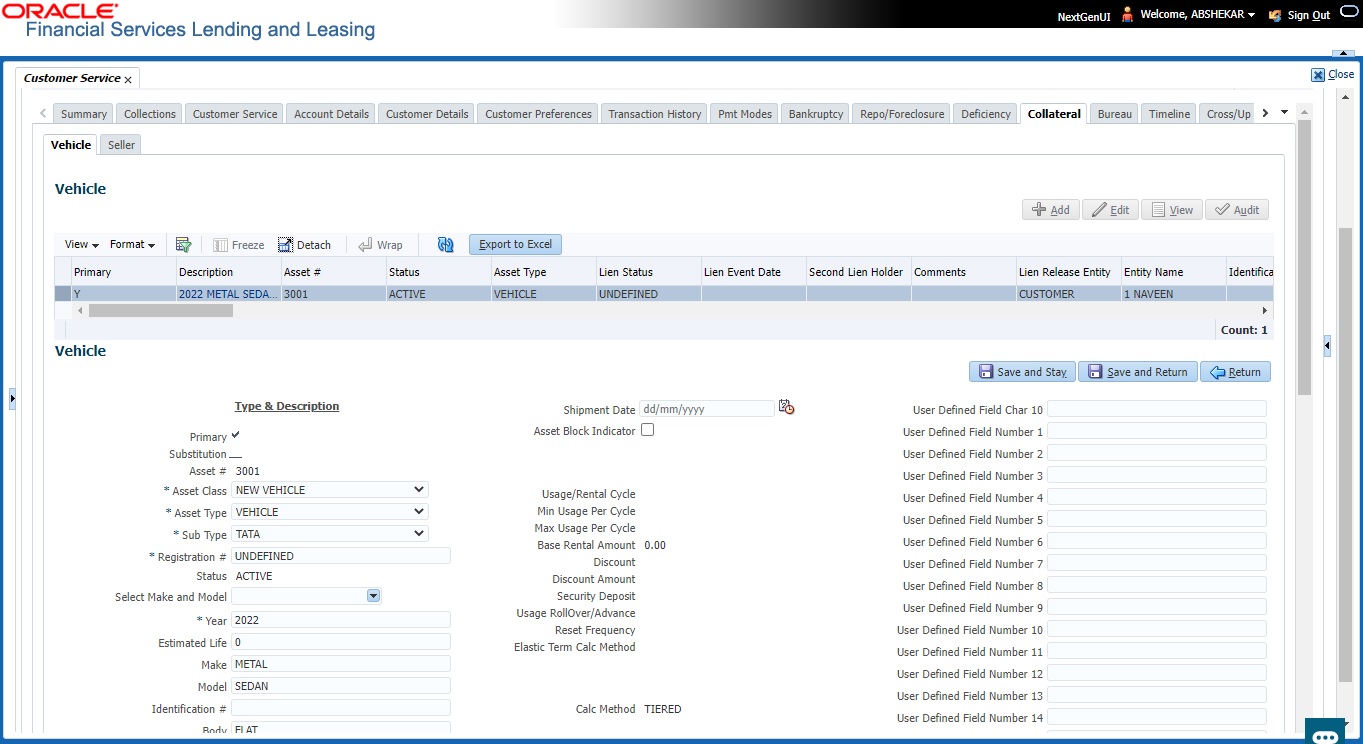
- If account’s collateral is a home, the Collateral screen opens at the Home tab:

- If account’s collateral is neither a vehicle nor a home, the Collateral screen opens at the Other Collateral:
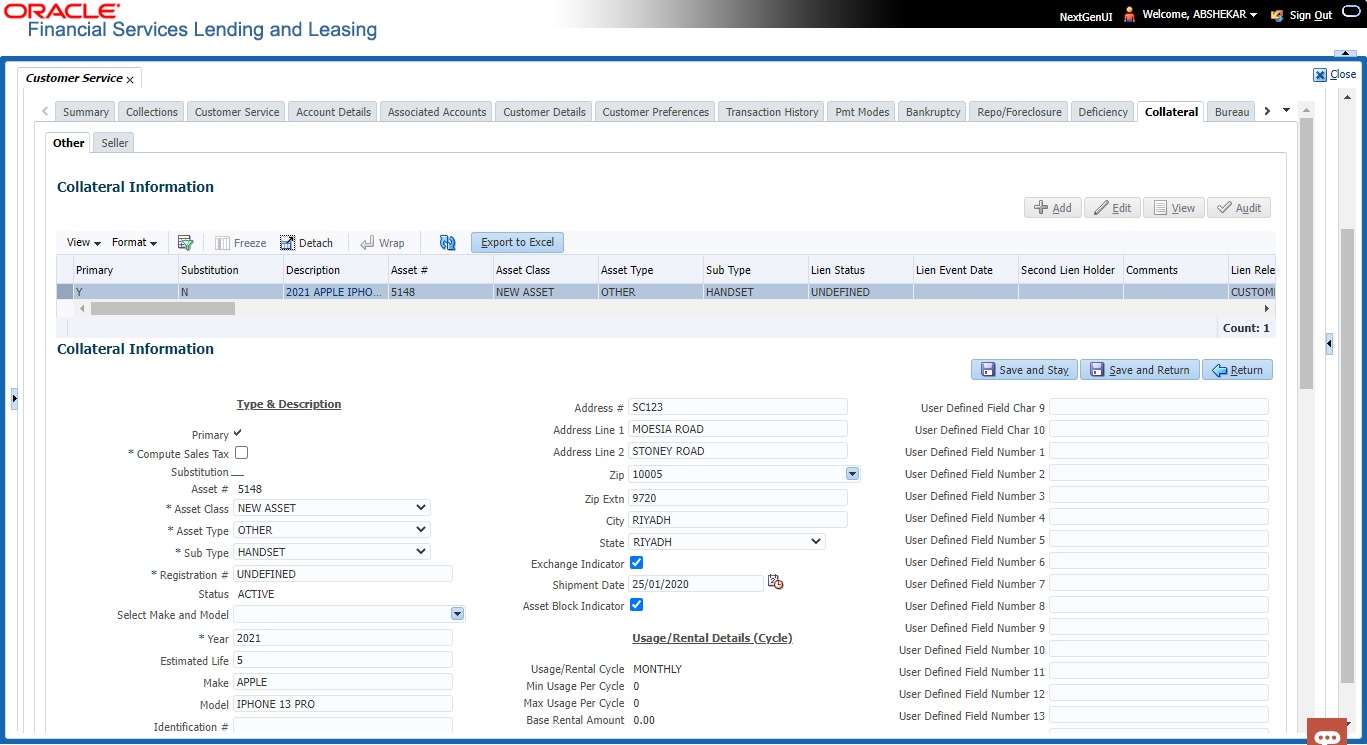
Clicking on Asset # in the Vehicle sub tab takes you to Collateral Management screen opening respective collateral. You can modify the details on Collateral management screen by clicking on ‘Edit’ and saving the record.
Note
While adding Collateral to an account, you can either select/deselect the ‘Substitution’ check box. If selected (default), system marks all the other collaterals/assets linked to the account as ‘Substituted’ and the same status is indicated in Collateral Management screen. If deselected, then there is no change in the Asset status.
The system displays a warning message if the Collateral Management screen is already open.
4.15.1 Valuation sub tab
With the Valuation sub screen, you can view the collateral or asset valuation for an account.
To view the collateral or asset valuation for an account
- Open the Customer Service screen and load the account you want to work with.
- Click Collateral tab and then Valuation.
- Click the Valuation sub tab to view the following information:
In this field:
View this:
Value section
Current
Select if this is the current valuation.
Valuation Dt
The valuation date of the vehicle.
Source
The valuation source.
Edition
The valuation edition.
Supplement
The valuation supplement.
Wholesale section
Wholesale Base
The wholesale value.
Usage
The usage. This pertains to Loan and usually is entered as the current mileage.
Retail section
Retail Amt
Specify the retail base value.
Addons Amt (+)
The add-ons value.
Usage Value Amt (+)
The usage value; that is, the monetary effect that current mileage has on the value of vehicle.
Total Amt (=)
The total value.
Addons section
Addons/Attributes
Select the add-on/attribute.
Value
The value of the attribute.
Amount
The add-on amount.
Note
Assets can have exactly one current valuation.
4.15.2 Tracking sub tab
With the Tracking sub screen, you can view collateral or asset tracking details to an account, such as the location of title, liens, and insurance information.
The Tracking Attributes for Line of credit accounts in this screen can also be loaded in bulk through file upload process. While doing so, ensure that the input data file definitions are in sync with attribute names. Before processing the bulk upload, system validates if the Tracking Attributes are already loaded. If not, system loads the Tracking Attributes and then updates the details.
To view the collateral or asset tracking for an account
- Open the Customer Service screen and load the account you want to work with.
- On the Customer Service screen, click Collateral tab.
- On the available screen (Vehicle, Home, or Other), click the Tracking sub tab.
- On the Tracking sub screen, enter, view, or edit the following information:
In this field:
View this:
Tracking Items section
Select
If selected, indicates that this is the current record.
Tracking Item
The tracking type.
Disposition
The disposition.
Start Dt
The tracking start date.
End Dt
The tracking end date.
Followup Dt
The next follow-up date.
Comment
Comments if any.
Tracking Item Details section
Enabled
Select to track the information from start date in the Start Dt field.
Parameter
The parameter.
Value
The tracking parameter value.
4.15.3 Vacation Ownership tab
In the Vacation Ownership sub tab you can capture and maintain ‘Timeshare’ specific collateral details of an account. This tab is displayed only for ‘Home’ collateral and allows to maintain only one record for the selected account.
In Vacation Ownership or Timeshare industry, ‘points’ represent monetary equivalent value and in a points-based timeshare ownership system, members/owners use the allotted points to exchange/trade collaterals. OFSLL uses these points for Asset Billing calculations while deriving the transaction amount as detailed in Setup > Asset Billing Rate screen.
Also in Vacation Ownership or Timeshare industry, ‘Tiers’ are used to classify a membership into different levels based on total points at Master Accounts. Each level of membership offers more perks than previous level. OFSLL supports points-based ‘Tier Calculation’ at Master Account level using the Formula parameters in Setup > User Defined Parameters screen.
Data in Vacation Ownership tab can also be populated from the following options:
- Create Collateral Web Service
- Create and Update Collateral Upload files
- API Process
- Account Onboarding
To maintain Vacation Ownership Elements for an account
- Open the Customer Service screen and load the account you want to work with.
- On the Customer Service screen, click Collateral tab.
- Click Home > Vacation Ownership sub tab.
- In the Vacation Ownership Elements section, view, or edit the following information:
In this field:
View this:
Club Name
Select the Club Name from the drop-down list.
Points
Specify the points up to two decimal digit.
Billing Points
View the auto populated billing points.
If the Asset Usage Type Sub Code is selected as FULL, this field is populated with total Points available in Points field.
If the Asset Usage Type Sub Code is selected as HALF, this field is populated with total Points/2 available in Points field.
For more details on how system consolidates the billing points, refer to Consolidate Actual Points at Master section.
First Year Proration
Select the check box for first year proration.
Resort Identifier
Select the Resort Identifier from the drop-down list.
Association Id
Select the Association Id from the drop-down list.
Building
Select the Building from the drop-down list.
Room/Unit Type
Select the Room/Unit Type from the drop-down list.
Unit
Select the Unit from the drop-down list.
Week
Select the Week from the drop-down list.
Site of Inventory
Select the Site of Inventory from the drop-down list.
Phase Number
Select the Phase Number from the drop-down list.
Usage Type
Select the Usage Type from the drop-down list.
Usage Start Date
Select the Usage Start Date from adjoining calendar.
Plus Membership Type
Check this box to indicate Plus Membership Type.
PR Marking
Check this box to indicate PR Marking.
Signature Grand Father
Check this box to indicate Signature Grand Father.
Club Indicator
Check this box to indicate Club Indicator.
Expiration Date of Asset
Select the Expiration Date of Asset from adjoining calendar.
This date is used for ‘Tier Calculation’ in the system.
Asset Travel Date
Select the Asset Travel Date from adjoining calendar.
Resale Indicator
Check this box to indicate Resale.
On disabling this check box system considers Asset Points and Grand Father Points for ‘Tier Calculation’ using formula Parameters.
Grand Father Points
Specify the Grand Father Points.
These points are used for ‘Tier Calculation’ in the system using formula parameters.
Additional Attributes - This section consists of additional 15 configurable fields as indicated below
5 check boxes - Membership 1-5 Opt
5 drop-down lists - Other Attribute 1-5
5 Calendar fields - Other Attribute 5-10
- Perform any of the Basic Actions mentioned in Navigation chapter.
Tier Calculation
Based on the value defined for Expiration Date of Asset, Resale Indicator, and Grand Father Points, OFSLL supports the following types of ‘Tier’ calculations at Master Account level using pre-defined formula parameters in Setup > User defined Parameters screen.
Type |
Formula Parameter |
Calculation |
Total Tier points at the Master account |
$ASE_TIER_POINTS |
Sum of Asset Billing Points where ‘Resale Indicator’ is ‘N’ and ‘Expiration Date of Asset’ is ‘greater than’ GL Date. |
Total Grand Father Points at the Master Account |
$ASE_GRAND_FATHER_POINTS |
Sum of Grandfather Points where ‘Resale Indicator’ is ‘N’ and ‘Expiration Date of Asset’ is ‘greater than’ GL Date. |
Note: For a non Master Account, system uses Master Account # to pick-up all Associated Accounts. |
||
4.15.3.1 Tracking Attributes sub tab
The Tracking Attributes screen enables you to link information to collateral that is not tracked by default in the system. These attributes are loaded when user loads the tracking attributes from Collateral > Collateral (Home) >Tracking tab.
To maintain the Tracking Attributes
- On the Customer Service screen, click Collateral tab.
- Click Home > Vacation Ownership > Tracking Attributes sub tab.
- Complete Tracking section by entering the requested parameter in the Value field.
- Save any changes you made to the account.
4.15.4 Seller sub tab
The Collateral link’s Seller Details screen enables you to view seller details of the collateral of Loan. You cannot edit or modify details of the seller.
- In Seller Details section, click View.
- View the following:
In this field:
View this:
Seller Details
Seller Type
The seller type.
Seller Name
The seller name.
Nationality
The nationality of the seller.
National Id
The national Id of the seller.
Authorized Signatory
The authorized signatory of the seller.
- In Seller Address section click View.
- View the following:
Seller Address
Mailing
If selected, indicates that this address is the mailing address.
Current
If selected, indicates that this address is the current address.
Country
The seller’s country name.
Address #
The seller’s address.
City
The seller’s city name.
State
The seller’s state name.
4.16 Customer Service screen’s Bureau tab
The Customer Service screen Bureau screen enables you to view credit bureau reports associated with the account that were pulled during servicing for account. You can also use the Bureau screen to create and pull additional credit bureau reports and view the results as a text only file.
To view an existing credit bureau report
- Open the Customer Service screen and load the account you want to work with.
- On the Customer Service screen, click Bureau tab.
- In the View Report section:
- Click Servicing to view credit reports generated with the Customer Service screen.
-or-
- Click Origination to view credit reports generated during Loan origination.
- In the Bureau Details section, select the report you want to view. The system displays report as a text file in the Text Report section.
To request a manual credit bureau report
- Open the Customer Service screen and load the account you want to work with.
- On the Customer Service screen, click Bureau tab.
- Click Add to open New Request section.
- Complete the following fields:
In this field:
Do this:
Customer
Select the available customer from the drop-down list.
Spouse
Select the applicant’s spouse from the drop-down list.
Bureau
Select the credit bureau from the drop-down list.
Report
Select the credit bureau report type from the drop-down list.
- In the New Request section, click Create Request. The system displays this information in the Bureau Details section and further information about customer in Customer Detail section.
Note
If you are requesting a report from Experian Credit Bureau for Premier Attribute Consumer report, you can do so without impacting the consumer FICO score. To facilitate the same, the ‘Soft Pull’ check box is to be selected in Bureau Details section. This option is available only when the system parameter ‘EXP_PA_SOFT_PULL_IND’ is enabled in the System Parameters screen and Bureau is selected as ‘EXP’ with Report as ‘PREMIER ATTRIBUTE’ in the Bureau Details section.
- If you want to receive a copy of a previously pulled credit bureau report, enter credit bureau reorder number in the Credit Bureau Reorder # field on the Bureau Details section.
- Click Save.
You can print the report by selecting the report and clicking on Print Report.
4.17 Customer Service screen’s Timeline tab
The Customer Service screen’s Timeline tab provides a graphical representation of specific events on an account over a period of time, The events mainly include Transactions (Monetary/Non Monetary), Payments and Call Activities that are posted on the account.
To view account timeline
- Open the Customer Service screen and load the account you want to work with.
- On the Customer Service screen, click Timeline tab.
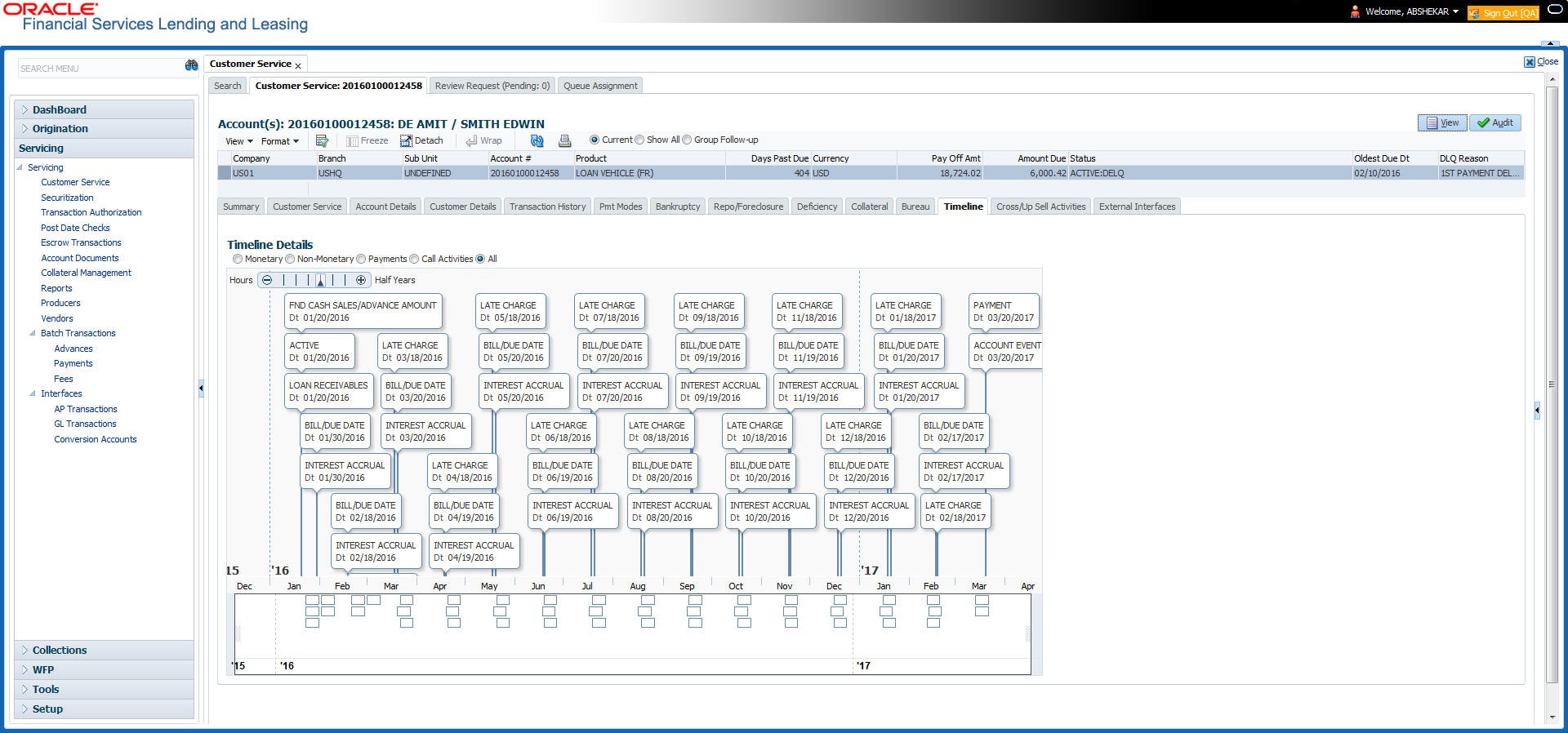
The Timeline Details section facilitates and displays the following options:
- The timeline ranges from 1 month before the account start date till 1 month after the current date.
- Each activity in timeline is arranged as per the transaction date on the account.
- The account activities are categorized as Monetary, Non-Monetary, Payments, and Call Activities. You can filter to view them by selecting the required option or select ‘ALL’ to display all the activities related to the account. By default, system displays ‘Monetary’ transactions.
- On selecting ‘Monetary’ and ‘Payments’ options, timeline displays only good monetary transactions and good payments. More details of these transactions can be viewed in Transaction History > Transactions tab by selecting ‘Good Txns’ and ‘Good Payments’ option.
- On selecting ‘Call Activities’ timeline displays all the call activities posted to the account.
- The Zoom bar
 has options to view the timeline based on Hours, Days, Weeks, Months, Quarters and Half Years.
has options to view the timeline based on Hours, Days, Weeks, Months, Quarters and Half Years.
- On hovering over the timeline, the arrows
 and
and  helps you to scroll through the timeline.
helps you to scroll through the timeline.
4.18 Customer Service screen’s Cross/Up Sell Activities tab
The Customer Service screen’s Cross/Up Sell Activities tab enables you to view and edit all the captured marketing trigger based events for respective customers linked primary accounts.
Oracle Financial Services Lending and Leasing Application has been integrated with a third party database marketing solutions provider to receive monitoring triggers related to marketing based call activities. Primarily the active customer details are shared through an input file and corresponding monitoring triggers data within the processed customer input file are uploaded back into designated location of OFSLL database through an automated interface.
The Customer Service screen’s Cross/Up Sell Activities tab displays the first 10 marketing trigger based call activities with the opportunity details and follow-up requirements. You can select View All check box to view all the ‘active’ and ‘closed’ call activities.
4.18.1 Edit Cross/Up Sell Activity
To edit a reported Cross/Up Sell Activity
- Open the Customer Service screen and load the account you want to work with.
- On the Customer Service screen, click Cross/Up Sell Activities tab.
- Select the record which you want to update and click Edit.
- Complete the following fields:
In this field:
Do this:
Trigger Dt
View the date on which the activity has been recorded.
Product
Select the product from drop-down list.
Trigger Action
View the trigger action captured.
Trigger Description
View the description of the action.
Result
Select the result of the action from the drop-down list.
Reason
Select the desired reason for the result selected.
Appn'mnt
Select the check box to indicate if a prior appointment is required for next communication.
Followup Dt
Select the agreed follow-up date from the adjoining calendar icon.
Close
If there is no follow-up and the opportunity is closed, you can select this check box indicating the status of call activity as closed.
Time Zone
Select the time zone of the contact from the drop down list.
Comments
Specify additional information, if any.
- Click Save and Stay or any other save option as explained in Basic Actions section.
4.18.2 Create Simple Application
You can use the call activity data and directly initiate the Loan Origination process from Cross/Up Sell Activities tab.
To create simple application
- Open the Customer Service screen and load the account you want to work with.
- On the Customer Service screen, click Cross/Up Sell Activities tab.
- Select the required call activity record and click Create Simple Application.
The system opens Origination > Simple Application Entry screen with Application section capturing the details of call activity.
You can enter/edit the required details and continue creating credit application data into Oracle Financial Services Lending and Leasing Application.
For detailed information, refer to Simple Application Entry chapter in Loan Origination User Manual.
4.18.3 Close Opportunity
You can close an opportunity based on the response received from customer and if there are no follow-ups required. However, you can close an opportunity and de-link the same from an account only when all the records are closed.
To close an opportunity
- Open the Customer Service screen and load the account you want to work with.
- On the Customer Service screen, click Cross/Up Sell Activities tab.
- Ensure that all the records are marked as closed and click Close Opportunity.
4.19 Customer Service screen’s External Interfaces tab
The Customer Service screen’s External Interfaces tab displays the account specific information derived from external system.
Oracle Financial Services Lending and Leasing has been integrated with a third party system to explicitly fetch the account specific information through an input data file. A set of automated batch jobs which are scheduled at regular intervals pulls the data shared by external system and populates in the respective account in Customer Service > External Interfaces tab. For more information on available Batch Jobs, refer to Setup Guide > Administration > System > Batch Jobs section.
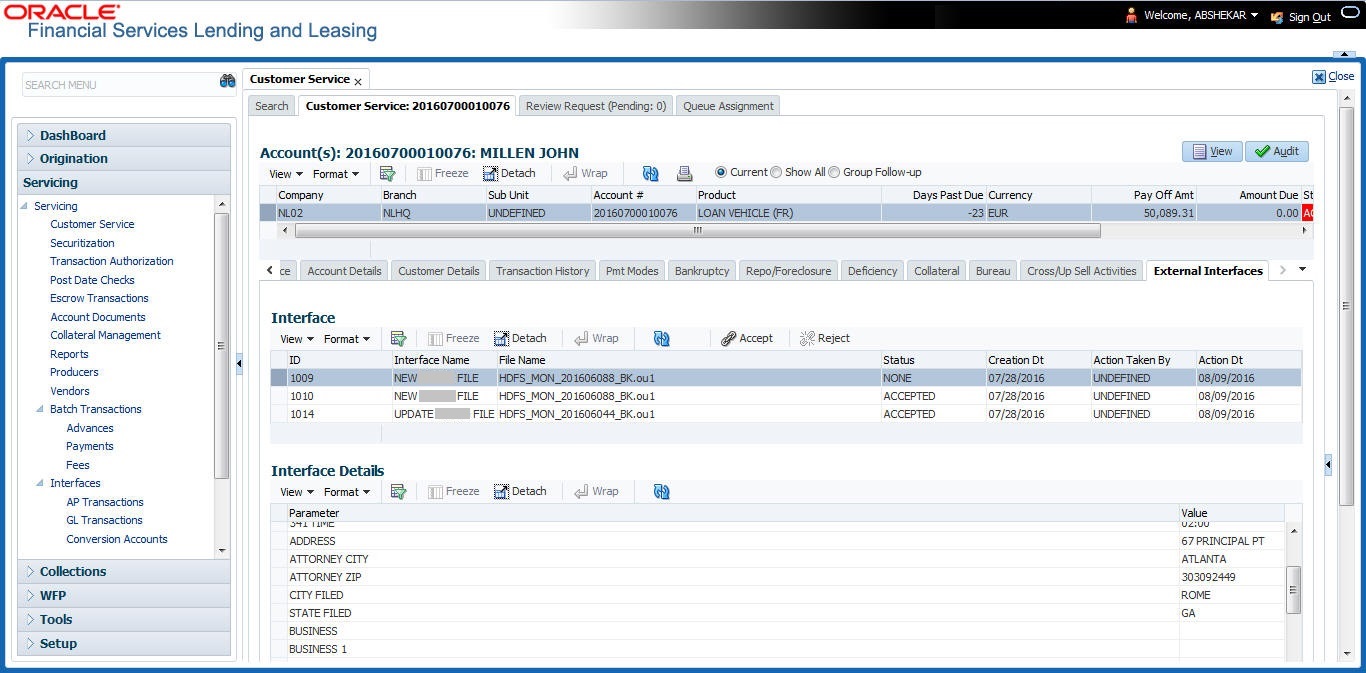
In the External Interfaces tab, each input data file either new or an update to existing information is displayed as individual record in the Interface section and the column definition details (as sorted in Setup > Data Files screen) are displayed in Interface Details section.
In this field: |
View this: |
Interface section |
|
ID |
Unique case identification number. |
Interface Name |
Name of the external interface. |
File Name |
Input data file name appended with New (IBN) or Existing (IBU) file identifier convention. |
Status |
Current status of the record (None, Accepted, or Rejected). |
Creation Dt |
Date when the record was created. |
Action Taken By |
User who has modified the record status. |
Action Dt |
Date when the action was performed on the record. |
Interface Details section |
|
Parameter |
Name of header used in input data file corresponding to the account information such as First Name, Last Name, Address and so on. |
Value |
Data fetched from external system for each header/parameter. |
Along with the account specific updates, the records may also contain bankruptcy details which needs you attention. You need to verify those details and confirm the authenticity by either accepting or rejecting the bankruptcy information. If Accepted, system posts the bankruptcy details on the corresponding customer accounts.
4.19.1 Accept or Reject Bankruptcy Details
In the External Interfaces tab you can Accept or Reject information of those records which are specific to bankruptcy update and marked with status as ‘None’.
- To accept the bankruptcy details, you need to create a new record with tracking attributes and then proceed with steps explained below.
- To reject a record, you can select the record and click ‘Reject’ in the external interface tab.
Post update, the status of record is marked as ‘Accepted’ or ‘Rejected’.
To Accept Bankruptcy Details
- Open the Customer Service screen and load the account you want to work with.
- On the Customer Service screen, click External Interfaces tab.
- In the Interface section, select the bankruptcy record with status ‘None’ for which action has to be performed.
- Verify the details displayed in Interface Details section.
- Once confirmed, navigate to Customer Service screen > Bankruptcy tab.
- Create a Bankruptcy record and load the tracking attributes as explained in ‘Customer Service screen’s Bankruptcy tab’ section.
- Click Accept in the action section and click ‘Yes’ in the confirmation dialog to accept changes.
On confirmation, system updates the bankruptcy details based on either ‘SSN’ for new bankrupt accounts or ‘Case Number’ for existing bankrupt accounts.
4.20 Review Request
The Review Requests screen is primarily a work flow tool used to flag an Account for the attention of another Oracle Financial Services Lending and Leasing user and ask for review / feedback. It allows the system users to send and receive requests (including e-mail) commenting on a specific Account. The Review Request tab supports iterative review of selected Account and also to process the review with multiple reviewers.
In this chapter, you will learn how to compete the following tasks:
- Filter and View Review Requests
- Create and Send Review Request
- Reviewing a Request
- Responding to Review Request
- Reassign Review Request
- E-mailing Review Request
- Closing Review Request
- Complete Review Request
Note
You can complete the above tasks for an Account Review Request using Review Request tab in the Customer Servicing screen.
4.20.1 Filter and View Review Requests
The Review Requests tab contains the following sections:
- Query Section
- Action Section
- Email Section
- Comment History Section
Query Section
The Query section enables you to filter records based on User and type of review requests using any of the following options:
The ‘User’ drop-down lists your User ID along with your Supervisor ID if the same has been defined in User Definition screen (Setup > Administration > User > Users). If you are the supervisor, you can view all your subordinates User ID’s along with yours for selection.
On selecting a particular User ID from the list, system displays all the requests which are created, reviewed, closed and completed by that user.
You can further filter the review request based on the following:
Query Options |
Descriptions |
Originator |
Displays the records of all the active review requests created by the selected User. |
Receiver |
Displays the records of all the active review requests received by the selected User. |
Both |
Displays all the review requests records created as well as reviewed by the selected User with the status other than ‘CLOSED’ and ‘COMPLETED’. |
View All |
Displays all the review requests records created as well as reviewed by the selected User with all the statuses. |
Forwarded Only |
Displays all the review requests records which are forwarded by the selected User to another user for review. |
Action Section
The Action section enables you to Send (create), Respond, Close, or Complete the review request.
Action Options |
Descriptions |
Open Account |
Displays the Customer Service screen with the Account details assigned for review. |
Send Request |
Sends a review request to another Oracle Financial Services Lending and Leasing user. |
Send Response |
Sends a response to a review request received from another Oracle Financial Services Lending and Leasing user. |
Close Request |
Changes the status of review request to CLOSED and can be viewed by selecting ‘View All’ option in the ‘Query’ section. |
Complete Request |
Changes the status of review request to COMPLETED and can be viewed by selecting ‘View All’ option in the ‘Query’ section. |
Remove Filter |
Removes the selected filters applied to narrow the view of review request. The option is available when a review request is accessed from DashBoard > My Pending Review Requests section. |
Email Section
The Email section enables you to send an email to either originator or receiver of the review request if an email setup is configured. However, note that a review request cannot be responded or replied back from email recipient.
Email Options |
Descriptions |
Originator |
Sends an email of review request information to the person listed in the Originator column on Review Request page. |
Receiver |
Sends an email of review request to the person listed in the Receiver column on Review Request page. |
The ‘Review Requests’ section in Customer Service screen displays the following information for each record:
Fields |
Descriptions |
Request # |
View the system generated review request number. The same can be used to query and track the review requests. |
Originator |
The user id of the review request originator. |
Priority |
The request priority: HIGH, NORMAL, or LOW. |
Receiver |
The recipient of the review request. |
Phone |
Applicant’s phone number in the review request. |
Address |
Applicant’s address in the review request. |
Applicant’s email in the review request. |
|
Status |
The current status of review request. Following status are tracked in this column: WAITING FOR RESPONSE - when request is sent to reviewer RETURN TO ORIGINATOR - when reviewer has responded to request CLOSED - when the request is closed COMPLETED - when the request is completed |
Date |
The date and time when the review request was created. |
Account # |
The Account number which needs review. |
Days Past Due |
Total number of days elapsed past the due date. |
Total Outstanding Balance |
Displays either ‘Account outstanding principal balance’ for active accounts, or ‘Deficiency balance’ for charge-off accounts. |
Customer |
Primary / Secondary (spouse) name associated to the account. |
Comment History
The ‘Comment History’ section displays the log of comments or additional information added by originator or receiver while creating or reviewing a request.
During an iterative review, where there are multiple trails of communication exchanged between originator and receiver, the ‘Comment History’ section tracks all the updates as individual records for reference.
The Comment History section also allows you to know the actually reviewer when an Account review request is forwarded to multiple reviewers and is reviewed or completed by second or third person other than the one assigned by originator.
In the Comment History section, you can view the following details of the selected review request:
Comments From |
Descriptions |
Type |
View the type of request and is indicated as REVIEW REQUEST by default as maintained in ‘COMMENT_TYPE_CD’ lookup code. |
Sub Type |
View the sub type of request which can be ORIGINATOR, RECEIVER, or SYSTEM GENERATED as maintained in COMMENT_SUB_TYPE_CD lookup code. Note: The sub type ‘SYSTEM GENERATED’ is automatically posted by the system when the review request is forwarded to another user by the assigned reviewer. The same is also updated with a comment in the next column. |
Comment |
View the Originator’s or Reviewer’s comment. SYSTEM GENERATED comments are posted in the format - REVIEW REQUEST: <Request #> FORWADED FROM <first assigned user id> TO <next assigned user id>. |
Comment By |
View the user who has posted the comment. SYSTEM GENERATED comments are marked as ‘INTERNAL’. |
Comment Dt |
View the Date and time when the comment was posted. |
4.20.2 Create and Send Review Request
The review request tab primarily allows you to flag an Account for the attention of another OFSLL user through a request asking for review / feedback. While doing so, you can either choose to send it to the reviewer immediately on creating the request or only create the request and later send for review.
To Create and Send Review Request
- On the Oracle Financial Services Lending and Leasing Application home page, click Servicing > Customer Service screen and select ‘Review Requests’ tab.

- In the Review Requests section, select ‘Originator’.
- Click ‘ADD’. You can also perform any of the Basic Operations mentioned in Navigation chapter. A brief description of the fields are given below:
In this field:
View this:
Request #
View the system generated request number.
Originator
View the requester’s user ID auto generated by system upon creating the request.
Priority
Select the priority of review request as High, Normal, or Low from the drop-down list. This helps the reviewer to prioritize the request while responding but does not affect the order in which messages are sent or received.
Receiver
Select the user ID of the reviewer from the drop-down list.
Comment
Specify additional details for review (if any) which can be sent to the reviewer along with the review request.
Sender
View the user ID of previous reviewer, if a request has been forwarded to another reviewer.
Note: A forwarded review request can only be viewed in the review request tab by filtering user ID of previous reviewer and selecting ‘Forwarded only’ check box.
Account #
Select the Account to be reviewed from the drop-down list. The following fields are auto-populated based on selection:
Days Past Due
Total Outstanding Balance
Customer
Phone
Address
Email
Reason
Select the purpose for request from drop-down list.
Status
View the status of review request auto updated by system upon creating the request.
Date
View the date and time when the request was created. System appends the current date by default.
Send Request
(Optional) Select this check box to send it to reviewer immediately on creating the request.
However, if the request still need changes, retain the check box unselected and proceed to create the request. The same can later be sent for review by selecting ‘Send Request’ option from the action section.
- Perform any of the Basic Actions mentioned in Navigation chapter.
The review request(s) appear on the recipient’s ‘My Pending Review Request’ window in DashBoard and also on the ‘Review Request’ tab header with (Pending: <count of unseen requests>). The status of request is updated as WAITING FOR RESPONSE.
4.20.3 Reviewing a Request
When you receive a review request, the system notifies you by creating an entry in ‘My Pending Review Requests By Priority’ section in DashBoard with the number of unseen messages. Clicking on the Account # link opens the Review Request tab.
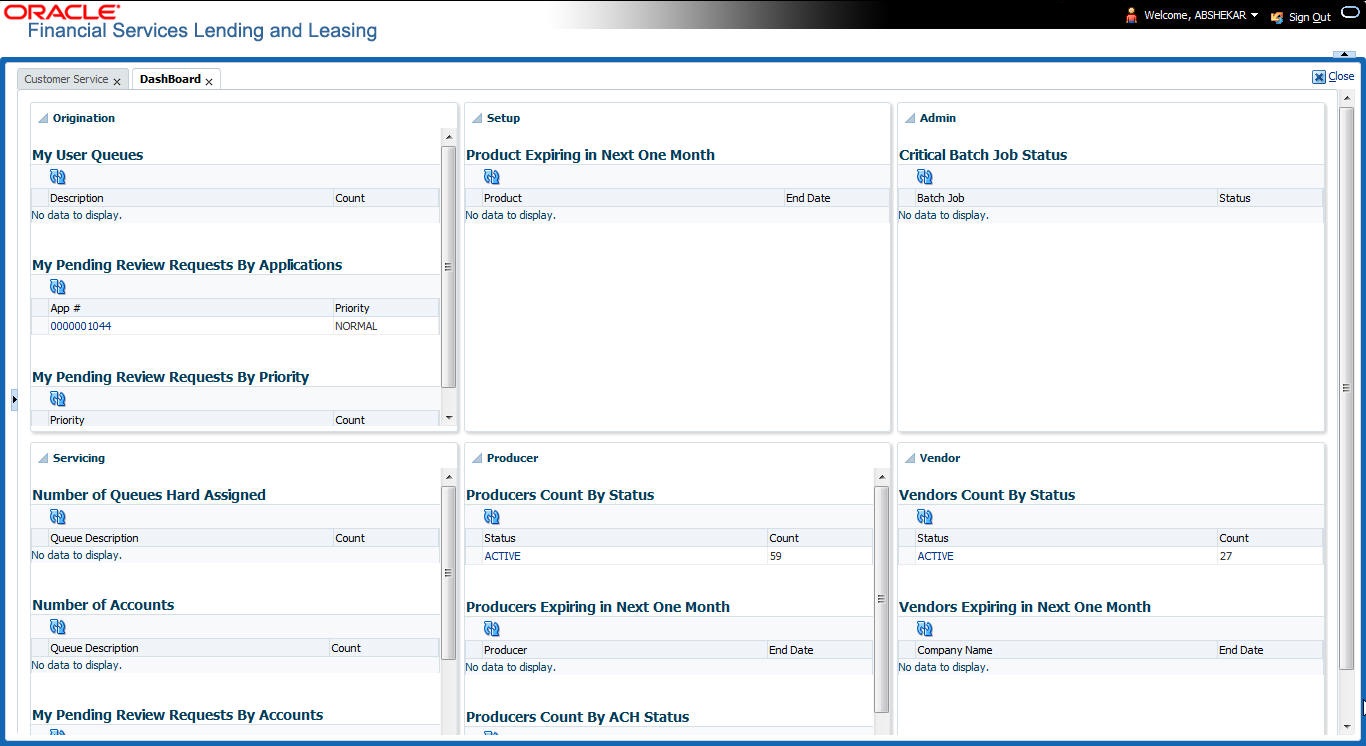
To review requests
- On the Oracle Financial Services Lending and Leasing Application home page, click Servicing > Customer Service screen and select ‘Review Requests’ tab.
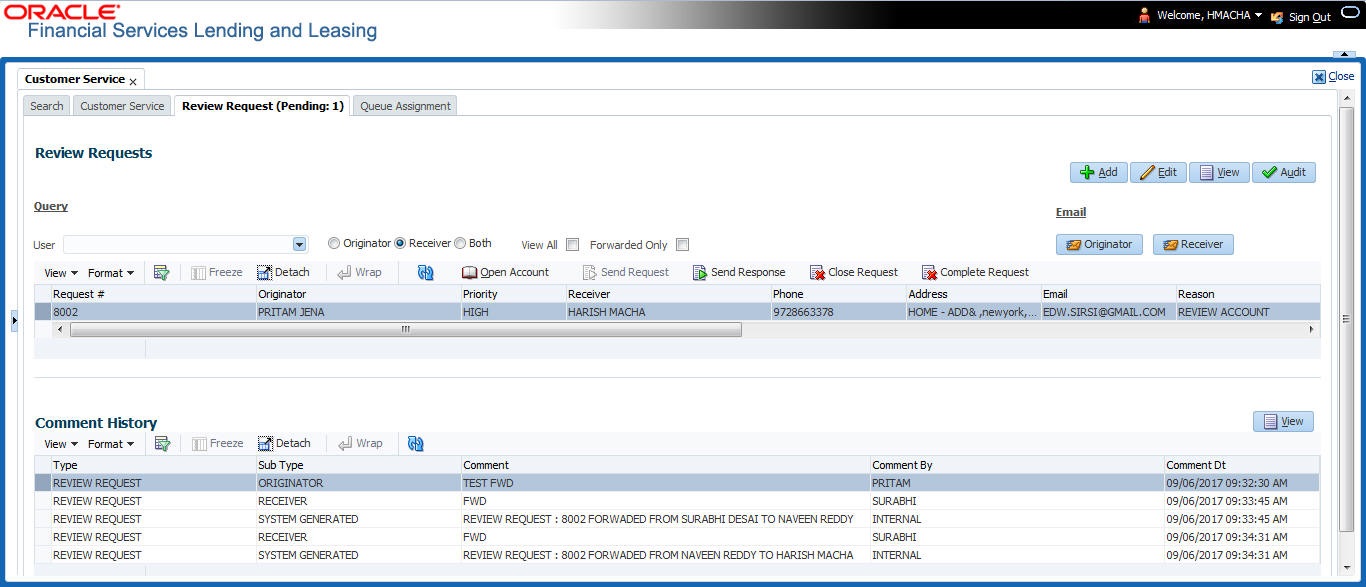
- In the Query section, click ‘Receiver’. System displays all open review request you have received.
- Click ‘Open Account’. The Account details are displayed in Customer Service > Summary tab.
- Review the details in particular to the details specified in the comment (if any).
4.20.4 Responding to Review Request
On completing the review, you can Send Response detailing the feedback of your review. It is ideally recommended to send a response back to the originator by providing your views on the review as a comment. The details are recorded in the ‘Comment History’ section as reference.
However, system also allows your forward the same request to another reviewer in case of additional clarifications.
To respond to review request
- On the Oracle Financial Services Lending and Leasing Application home page, click Servicing > Customer Service screen and select ‘Review Requests’ tab.
- In the Query section, click ‘Receiver’. System displays all open review request you have received.
- In the Review Request section, select the record that you have reviewed.Click ‘Edit’. Specify your review response in the ‘Comment’ field. Select the ‘Send Request’ check box to send the review response immediately to originator. In case of any further changes, retain the check box unselected and save the details. The response is not sent and the same can later be sent to originator by selecting the record and clicking on ‘Send Response’ option from the action section.

The details are updated in Review Request tab and status of request is updated as RETURN TO ORIGINATOR.
4.20.5 Reassign Review Request
While reviewing a request, system also facilitates you to reassign (i.e. forward) the review request to another user for review. In such a case, you become the ‘Sender’ and the assigned user will be the reviewer of the request. The request can further move to other reviewers if required.
When the request is reassigned or forwarded to another reviewer, the actual originator can still track the status of request by selecting user ID in Query section. As a ‘Sender’, you can view the reassigned review requests by selecting the ‘Forwarded Only’ check box in Query section. Also, on reassigning or forwarding a review request, system automatically posts a comment in ‘Comment History’ section in the format - REVIEW REQUEST: <Request #> FORWADED FROM <first assigned user id> TO <next assigned user id> with Sub Type as ‘SYSTEM GENERATED’ and Comment By as ‘INTERNAL’.
Note
It is recommended to limit the reassignment of review request since tracking the request status becomes difficult.
To reassign review request
- On the Oracle Financial Services Lending and Leasing Application home page, click Servicing > Customer Service screen and select ‘Review Requests’ tab.
- In the Query section, click ‘Receiver’. System displays all open review request you have received.
- In the Review Request section, select the record that you have reviewed and click Edit.
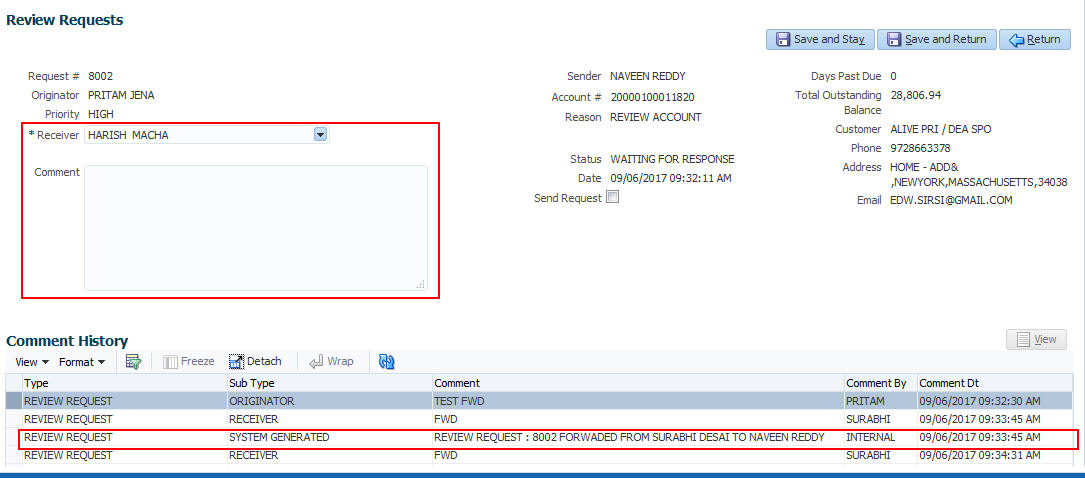
- Select the required reviewer from ‘Receiver’ drop down list.
- (Optional) Specify the reason for reassignment in the ‘Comment’ field. The same is tracked in ‘Comment History’ section.
- Select the ‘Send Request’ check box to reassign review request immediately on update. In case of any further changes, retain the check box unselected and save the details. The reassignment can later be completed by selecting the record and clicking on ‘Send Response’ option from the action section.
The details are updated in Review Request tab and status of request is updated as WAITING FOR RESPONSE.
4.20.6 E-mailing Review Request
While system updates ‘My Pending Review Requests By Priority ‘section in the DashBoard to notify you about the new requests, you can also e-mail a review request to both the originator and a receiver, as applicable. The system will use e-mail address recorded for both the originator and receiver in Setup > Administration > User > User Definition section.
To e-mail a review request
- On the Oracle Financial Services Lending and Leasing Application home page, click Servicing > Customer Service screen and select ‘Review Requests’ tab.
- In ‘Email’ section, click ‘Originator’ to send the message to the person listed in Originator field.
-or-
- Click ‘Receiver’ to send it to the person listed in the Receiver field.
The system emails the details of selected record to e-mail address recorded in user setup.
4.20.7 Closing Review Request
You can close a review request you created at anytime, regardless of status. However, you can only close review requests that have your user id in the Originator field. When you close a review request, the system removes it from Review Request tab.
To close a review request
- On the Oracle Financial Services Lending and Leasing Application home page, click Servicing > Customer Service screen and select ‘Review Requests’ tab.
- Select the request you want to close in the Review Request section.
- In the Action section, click ‘Close Request’.
The system assigns the request as Closed and removes it from your Review Request record. The closed review requests can be reviewed anytime by selecting ‘View All’ in the Query section.
4.20.8 Complete Review Request
When a particular review request has completed the review process from reviewer with required changes and confirmation, the same can be marked as ‘COMPLETE’ in the Review Request tab. However, you can complete a request only if you are the originator of the request. When you complete a review request, system removes it from Review Request tab.
To complete a review request
- On the Oracle Financial Services Lending and Leasing Application home page, click Servicing > Customer Service screen and select ‘Review Requests’ tab.
- Select the request you want to close in the Review Request section.
- In the Action section, click ‘Complete Request’.
The system assigns the request as ‘COMPLETED’ and removes it from your Review Request record. The completed review requests can be reviewed anytime by selecting ‘View All’ in the Query section.
4.21 Queue Assignment
The Queue Assignment tab in Oracle Financial Services Lending and Leasing application allows you to search and view the hard assigned customer service queues maintained in the system. You can also view the queue assignment details with option to reassign users in a hard assigned queue and track activity status posted on the account.
Customer Service Queues are maintained in Administration’s setup screen (Setup > Administration > User > Queues > Customer Service). For more information on hard assigned queues, refer to section “Using the Hard Assigned feature” in setup guide.
Navigating to Queue Assignment
On the Oracle Financial Services Lending and Leasing home screen, click Servicing > Servicing > Customer Service > Queue Assignment.
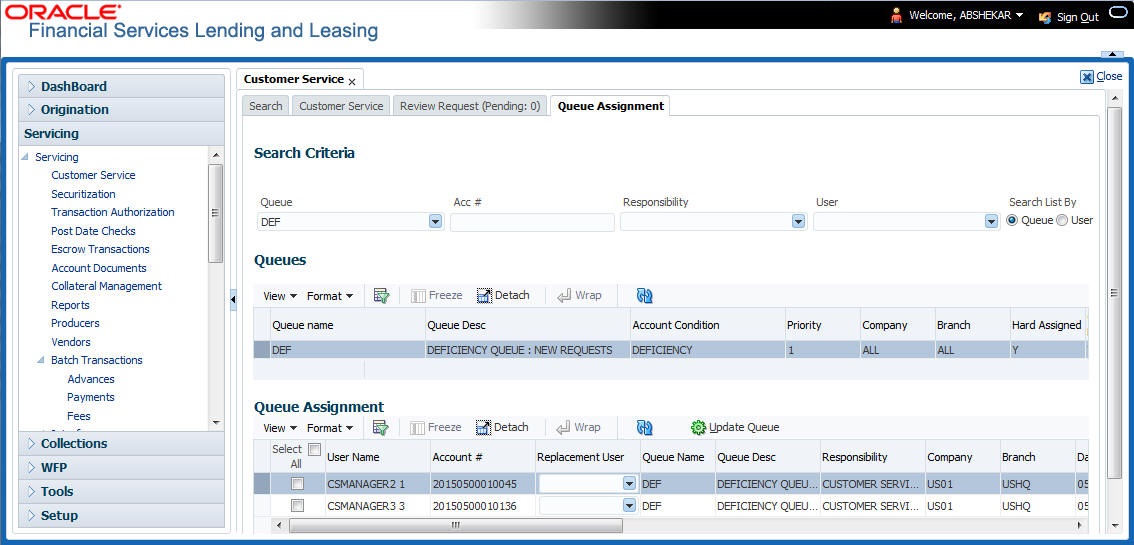
In this section, you will learn how to compete the following tasks:
- Using Queue Search
- Filter Queues in Queues sub tab
- Define criteria in Criteria sub tab
- View options in Queue Assignment sub tab
- Reassign Users in Queue
- Filter Accounts based on Queue Criteria
- View Accounts in Sort Order Sequence
- Track Activity Status
4.21.1 Using Queue Search
In the Search Criteria section, you can primarily use the ‘Search List By’ filter to search based on either ‘Queues’ or ‘Users’ maintained in the system. Depending on the option selected, you can further filter your search using the following list of parameters and query the database by providing one or more parameter values.
Field: |
Do this: |
Hard Assigned Queue |
Select the queue name from the drop-down list. The list displays both ‘Enabled’ and ‘Hard Assigned’ customer servicing queue definitions. |
Acc # |
Specify the account number to which the queue is assigned. |
Responsibility |
Select the user/queue responsibility from the drop-down list. The list displays various user responsibilities as defined in Setup > Administration > User > Queues > User Groups tab. |
User |
Select the ‘User’ from the drop-down list. The list displays all the hard assigned users maintained in the system. |
Note
You need to specify a minimum of one parameter for the search to retrieve queues from the database. Else system displays an error message.
Click Search. The search results for Queues are displayed in both the Queues & Queue Assignment section. Whereas, the search results for a ‘User’ (selected in Search List By option) is displayed in Queue Assignment section.
You can also click ‘Reset’ to clear the filters specified in Search Criteria .
Remove Account Filter
While searching for queues using Account number as the Search Criteria, the Queue Assignment section displays the filtered search results along with the ‘remove Filter’ option in the header.
Clicking on ‘remove Filter’ button will remove the account number filter and displays all the accounts belonging to the selected queue.
4.21.2 Queues sub tab
The Queues sub tab displays the search results for the specified search criteria and contains ‘Enabled’ and ‘Hard Assigned’ customer servicing queues with the following details:
- Queue name
- Queue Desc
- Account Condition
- Priority
- Company
- Branch
- Hard Assigned
- Group Follow-up Ind
- Near Real-Time
- Dialer Extract
- Enabled
4.21.3 Criteria sub tab
The Criteria sub tab allows you to define account selection criteria and sort order to filter the accounts displayed in Queue Assignment section.
- In the Criteria Definition section, click ‘ADD’. You can also perform any of the Basic Operations mentioned in Navigation chapter. A brief description of the fields are given below:
Field:
Do this:
Name
Specify a unique name to identify the criteria.
Description
Specify the required description for the criteria.
Hard Assigned Queue
Select the queue name from the drop-down list. The list displays all the ‘Enabled Hard Assigned’ customer service queues.
Enabled
Check this box to enable the criteria.
The Criteria sub tab further consists of ‘Selection Criteria’ and ‘Sort’ tabs.
- In the ‘Selection Criteria’ section, you can define the account selection criteria with the following fields. Perform any of the Basic Operations mentioned in Navigation chapter.
Note
Although system allows to define customized selection criteria, the execution of additional selection criteria requires additional processing at server level and can have significant performance impact delaying the EOD processing/web services. Hence it is recommended to have careful consideration while defining the additional selection criteria (like using user-defined tables and columns) and/or get approval from your database administrator before using any selection criteria.
A brief description of the fields are given below:
Field: |
Do this: |
Seq |
Specify sequence numbers. |
( |
Specify left bracket. |
Parameter |
Select the parameter from the drop-down list. The list displays all the ‘Enabled’ attributes maintained in user defined table which has both ‘Queue Assignment’ fields and 36 activities defined in Queues > Activity Tracking tab for selection. |
Comparison Operator |
Select comparison operator from the drop-down list. |
Criteria Value |
Specify criteria value. |
) |
Specify right bracket. |
Logical Expression |
Specify logical operator from the drop-down list. |
Enabled |
Check this box to enable the selection criteria. |
- Click ‘Check Criteria’ to validate the correctness of the SQL statement generated and to resolve errors, if any.
- Perform any of the Basic Actions mentioned in Navigation chapter.
- In the ‘Sort’ section, you can define the order to sort the account selection criteria with the following fields. Perform any of the Basic Operations mentioned in Navigation chapter. A brief description of the fields are given below:
Field:
Do this:
Seq
Specify sequence number.
Sort field
Select the sort field from the drop-down list. The list contains both the ‘Queue Assignment’ fields and 36 customer call activities defined in Queues > Activity Tracking tab for selection.
Order
Select sort order as either Ascending or Descending from the drop-down list.
- Perform any of the Basic Actions mentioned in Navigation chapter.
4.21.4 Queue Assignment sub tab
The Queue Assignment section, displays the user accounts associated with the selected queue and consists of the following details:
- User Name
- Account #
- Replacement User
- Queue Name
- Queue Desc
- Responsibility
- Company
- Branch
- Date
- Title
- Products
- Status
- Delinquency Days
- Amount Due
- Outstanding Balance
- Producer
- Secured
- Reason
In the Queue Assignment section, you can do the following:
- Reassign Users in Queue
- Filter Accounts based on Queue Criteria
- View Accounts in Sort Order Sequence
- Track Activity Status

4.21.5 Reassign Users in Queue
In the Queue Assignment tab, you can reassign a different user for a queue either individually or in bulk and reassign the hard assigned queues. While doing so, you can state the reason for change which later gets appended and displayed in the account conditions history log (Customer Service > Account Details > Condition Details sub tab).
4.21.5.1 Replace User in Queue
- On the Oracle Financial Services Lending and Leasing home screen, click Servicing > Servicing > Customer Service > Queue Assignment.
- Search for the required Queue or User using the parameters in Search Criteria. The search results are displayed in the Queues & Queue Assignment section.
- In the Queue Assignment section, click on the ‘Replacement User’ drop-down list against the required user and select the new user from the list. You can also use the ‘Search’ option within the list to search for the required user.
- Specify the reason for change in the Reason column against the user selected.
- Click Update Queue.
4.21.5.2 Bulk Replace Queue Users
- On the Oracle Financial Services Lending and Leasing home screen, click Servicing > Servicing > Customer Service > Queue Assignment.
- Search for the required Queue or User using the parameters in Search Criteria. The search results are displayed in the Queues & Queue Assignment section.
- In the Queue Assignment section, click ‘Select All’ check box.
- Click on the ‘Replacement User’ drop-down list on the header and select the new user from the list. You can also use the ‘Search’ option within the list to search for the required user.
- Specify the reason for change in the Reason field on the header.
- Click Update Queue.
On successful user replacement, a system generated comment is posted on the account with the following details:
- Alert flag as ‘N’
- Type
- Sub Type
- Comment Format QUEUE USER CHANGED FROM XXX TO YYY BECAUSE OF <<REASON>> ON <<DATEFORMAT>>
4.21.6 Filter Accounts based on Queue Criteria
To filter the list of accounts in Queue Assignment section, select the required option in ‘Sort Order Type’ drop-down list and click ‘Submit’. The list is populated based on the defined Queue Criteria. You can also click ‘Reset’ to remove the filter and display all the account associated to the queue.
4.21.7 View Accounts in Sort Order Sequence
In the Queue Assignment section the ‘Account #’ column is enabled with a link to directly navigate and view the account details in the Customer Service screen.
To view the next account in the same sequence as listed, click ‘Filtered Account’ button in the Queue Assignment section header. The details are displayed in Customer Service screen’s > Summary tab.
On reviewing the account details, you can further navigate to the subsequent accounts in the sequence by clicking ‘Filtered Account’ button in Right-Splitter window > Quick Search section. Successively, clicking ‘Filtered Account’ button displays all the accounts and when the last account is reached, a message is displayed indicating ‘There is no account in this queue’.
4.21.8 Track Activity Status
All the customer service call activities defined and enabled in setup screen (Setup > Administration > User > Queues > Customer Service > Queue Activity tab) for the selected Queue are listed against each account in separate columns. These activity fields are auto updated with call activity results and gives a quick snap shot of all the activity status scheduled and performed on the account.
Note
The activity status fields are available only when the accounts are populated from a Queue search by selecting the ‘Search List By’ option as ‘Queue’.
When a particular call activity is posted on the account, the respective activity status field is marked with a  indicating that the activity is complete.
indicating that the activity is complete.
However, in case the activity duration has expired based on the ‘Activity Expiry Days’ defined in Queue Activity tab, the activity field is disabled and status is not updated in Queue Assignment section.